Effectiveness of Corporate Social Responsibility by Firms
VerifiedAdded on 2023/04/24
|58
|13568
|196
AI Summary
This dissertation aims to understand and examine the strategies adopted by firms about the effective implementation of the CSR practices in the society. The research is conducted using interpretivism philosophy, deductive approach, descriptive research strategy and semi-structured interview process. The study finds that participants support the idea and concept of corporate social responsibility and thinks that it should be included and considered as an integral part of every business organization.
Contribute Materials
Your contribution can guide someone’s learning journey. Share your
documents today.

Running head: DISSERTATION
Effectiveness of Corporate Social Responsibility by Firms
Name of the Student:
Name of the University:
Author’s Note:
Effectiveness of Corporate Social Responsibility by Firms
Name of the Student:
Name of the University:
Author’s Note:
Secure Best Marks with AI Grader
Need help grading? Try our AI Grader for instant feedback on your assignments.
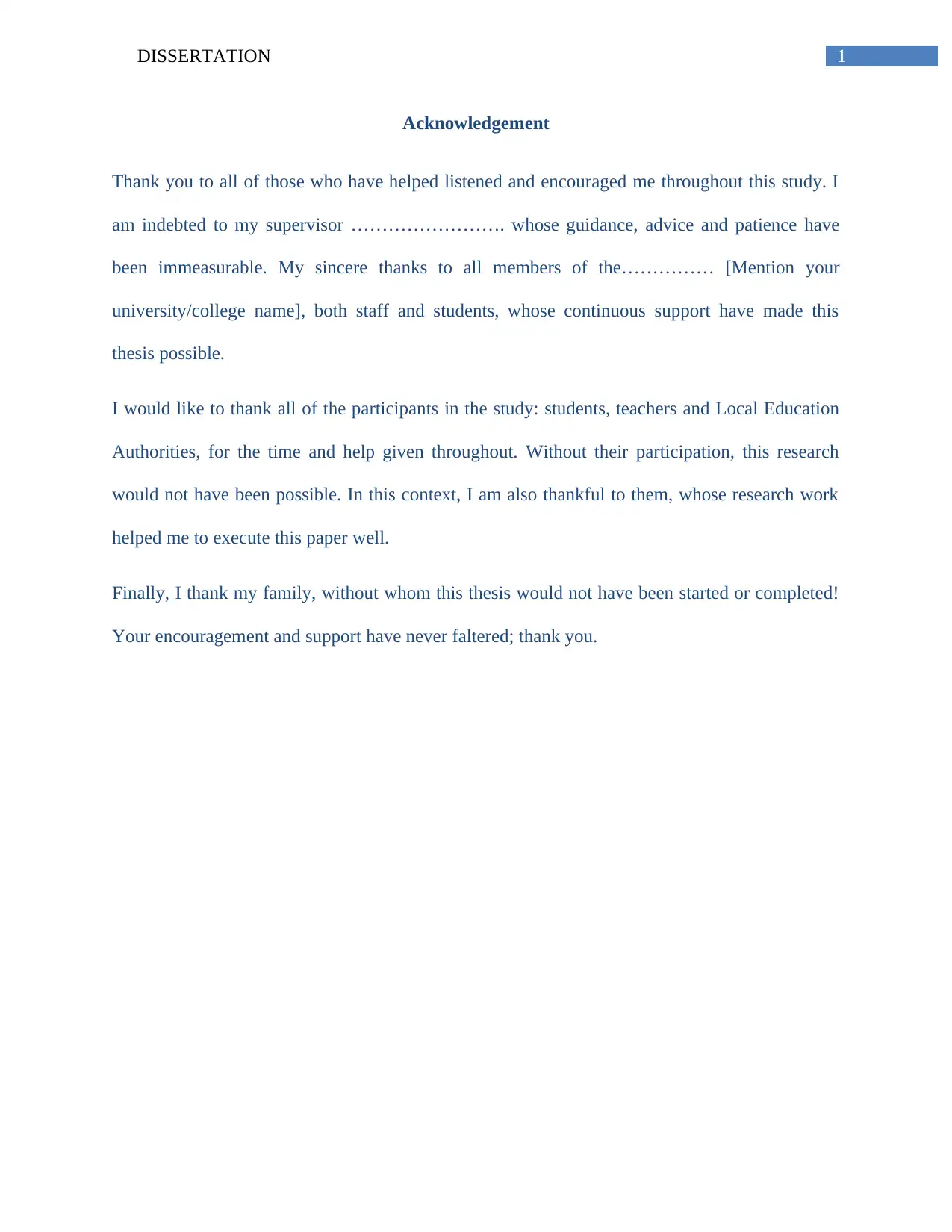
1DISSERTATION
Acknowledgement
Thank you to all of those who have helped listened and encouraged me throughout this study. I
am indebted to my supervisor ……………………. whose guidance, advice and patience have
been immeasurable. My sincere thanks to all members of the…………… [Mention your
university/college name], both staff and students, whose continuous support have made this
thesis possible.
I would like to thank all of the participants in the study: students, teachers and Local Education
Authorities, for the time and help given throughout. Without their participation, this research
would not have been possible. In this context, I am also thankful to them, whose research work
helped me to execute this paper well.
Finally, I thank my family, without whom this thesis would not have been started or completed!
Your encouragement and support have never faltered; thank you.
Acknowledgement
Thank you to all of those who have helped listened and encouraged me throughout this study. I
am indebted to my supervisor ……………………. whose guidance, advice and patience have
been immeasurable. My sincere thanks to all members of the…………… [Mention your
university/college name], both staff and students, whose continuous support have made this
thesis possible.
I would like to thank all of the participants in the study: students, teachers and Local Education
Authorities, for the time and help given throughout. Without their participation, this research
would not have been possible. In this context, I am also thankful to them, whose research work
helped me to execute this paper well.
Finally, I thank my family, without whom this thesis would not have been started or completed!
Your encouragement and support have never faltered; thank you.
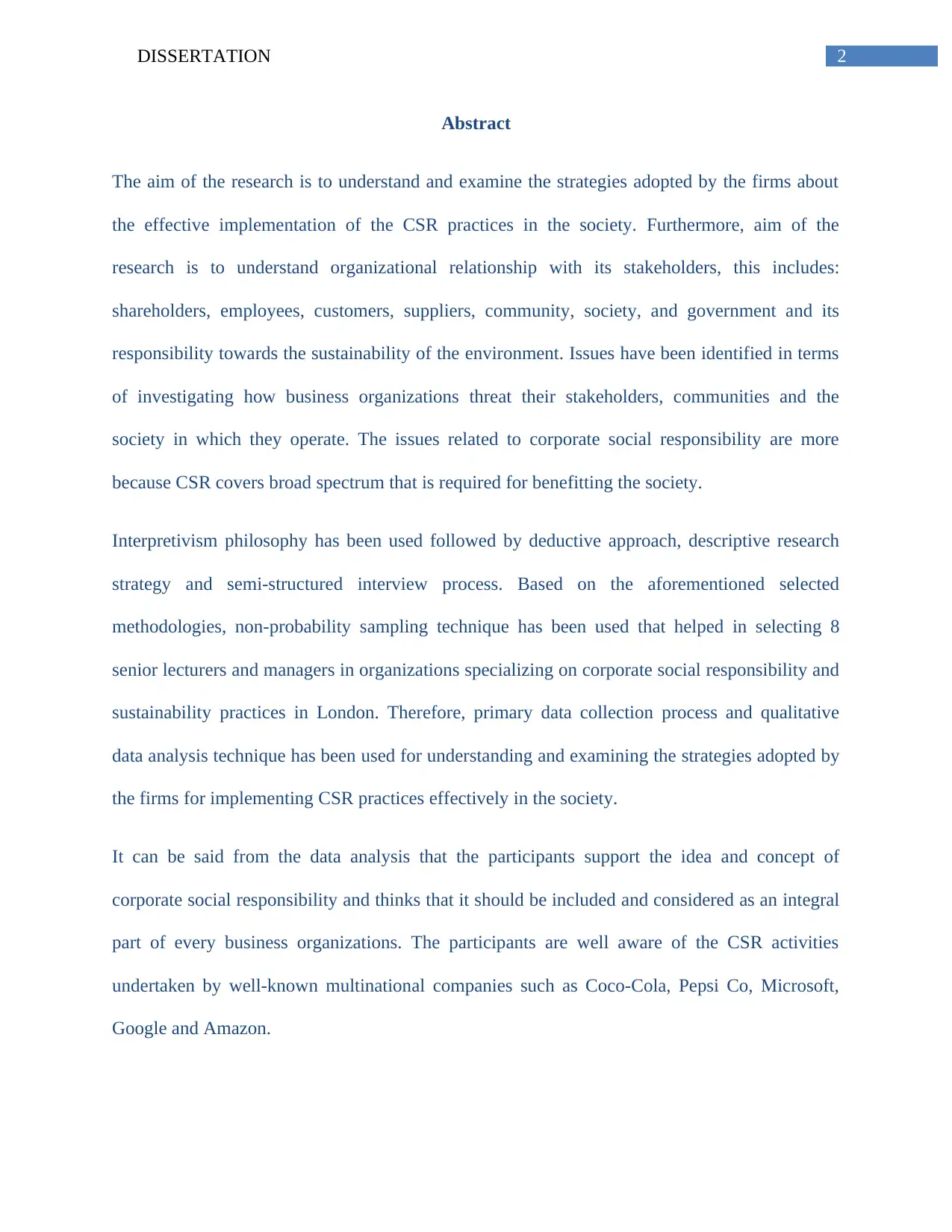
2DISSERTATION
Abstract
The aim of the research is to understand and examine the strategies adopted by the firms about
the effective implementation of the CSR practices in the society. Furthermore, aim of the
research is to understand organizational relationship with its stakeholders, this includes:
shareholders, employees, customers, suppliers, community, society, and government and its
responsibility towards the sustainability of the environment. Issues have been identified in terms
of investigating how business organizations threat their stakeholders, communities and the
society in which they operate. The issues related to corporate social responsibility are more
because CSR covers broad spectrum that is required for benefitting the society.
Interpretivism philosophy has been used followed by deductive approach, descriptive research
strategy and semi-structured interview process. Based on the aforementioned selected
methodologies, non-probability sampling technique has been used that helped in selecting 8
senior lecturers and managers in organizations specializing on corporate social responsibility and
sustainability practices in London. Therefore, primary data collection process and qualitative
data analysis technique has been used for understanding and examining the strategies adopted by
the firms for implementing CSR practices effectively in the society.
It can be said from the data analysis that the participants support the idea and concept of
corporate social responsibility and thinks that it should be included and considered as an integral
part of every business organizations. The participants are well aware of the CSR activities
undertaken by well-known multinational companies such as Coco-Cola, Pepsi Co, Microsoft,
Google and Amazon.
Abstract
The aim of the research is to understand and examine the strategies adopted by the firms about
the effective implementation of the CSR practices in the society. Furthermore, aim of the
research is to understand organizational relationship with its stakeholders, this includes:
shareholders, employees, customers, suppliers, community, society, and government and its
responsibility towards the sustainability of the environment. Issues have been identified in terms
of investigating how business organizations threat their stakeholders, communities and the
society in which they operate. The issues related to corporate social responsibility are more
because CSR covers broad spectrum that is required for benefitting the society.
Interpretivism philosophy has been used followed by deductive approach, descriptive research
strategy and semi-structured interview process. Based on the aforementioned selected
methodologies, non-probability sampling technique has been used that helped in selecting 8
senior lecturers and managers in organizations specializing on corporate social responsibility and
sustainability practices in London. Therefore, primary data collection process and qualitative
data analysis technique has been used for understanding and examining the strategies adopted by
the firms for implementing CSR practices effectively in the society.
It can be said from the data analysis that the participants support the idea and concept of
corporate social responsibility and thinks that it should be included and considered as an integral
part of every business organizations. The participants are well aware of the CSR activities
undertaken by well-known multinational companies such as Coco-Cola, Pepsi Co, Microsoft,
Google and Amazon.
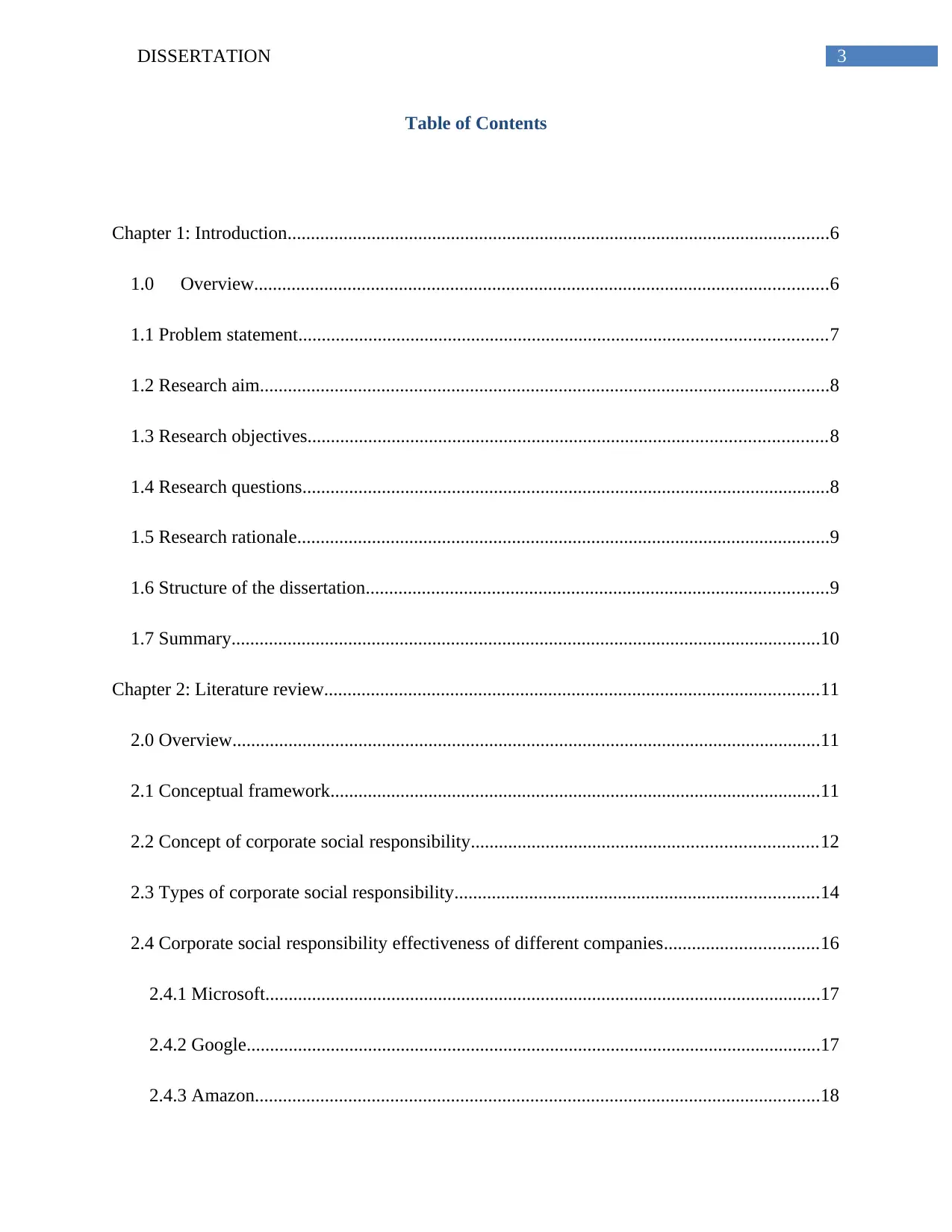
3DISSERTATION
Table of Contents
Chapter 1: Introduction....................................................................................................................6
1.0 Overview...........................................................................................................................6
1.1 Problem statement.................................................................................................................7
1.2 Research aim..........................................................................................................................8
1.3 Research objectives...............................................................................................................8
1.4 Research questions.................................................................................................................8
1.5 Research rationale..................................................................................................................9
1.6 Structure of the dissertation...................................................................................................9
1.7 Summary..............................................................................................................................10
Chapter 2: Literature review..........................................................................................................11
2.0 Overview..............................................................................................................................11
2.1 Conceptual framework.........................................................................................................11
2.2 Concept of corporate social responsibility..........................................................................12
2.3 Types of corporate social responsibility..............................................................................14
2.4 Corporate social responsibility effectiveness of different companies.................................16
2.4.1 Microsoft.......................................................................................................................17
2.4.2 Google...........................................................................................................................17
2.4.3 Amazon.........................................................................................................................18
Table of Contents
Chapter 1: Introduction....................................................................................................................6
1.0 Overview...........................................................................................................................6
1.1 Problem statement.................................................................................................................7
1.2 Research aim..........................................................................................................................8
1.3 Research objectives...............................................................................................................8
1.4 Research questions.................................................................................................................8
1.5 Research rationale..................................................................................................................9
1.6 Structure of the dissertation...................................................................................................9
1.7 Summary..............................................................................................................................10
Chapter 2: Literature review..........................................................................................................11
2.0 Overview..............................................................................................................................11
2.1 Conceptual framework.........................................................................................................11
2.2 Concept of corporate social responsibility..........................................................................12
2.3 Types of corporate social responsibility..............................................................................14
2.4 Corporate social responsibility effectiveness of different companies.................................16
2.4.1 Microsoft.......................................................................................................................17
2.4.2 Google...........................................................................................................................17
2.4.3 Amazon.........................................................................................................................18
Secure Best Marks with AI Grader
Need help grading? Try our AI Grader for instant feedback on your assignments.
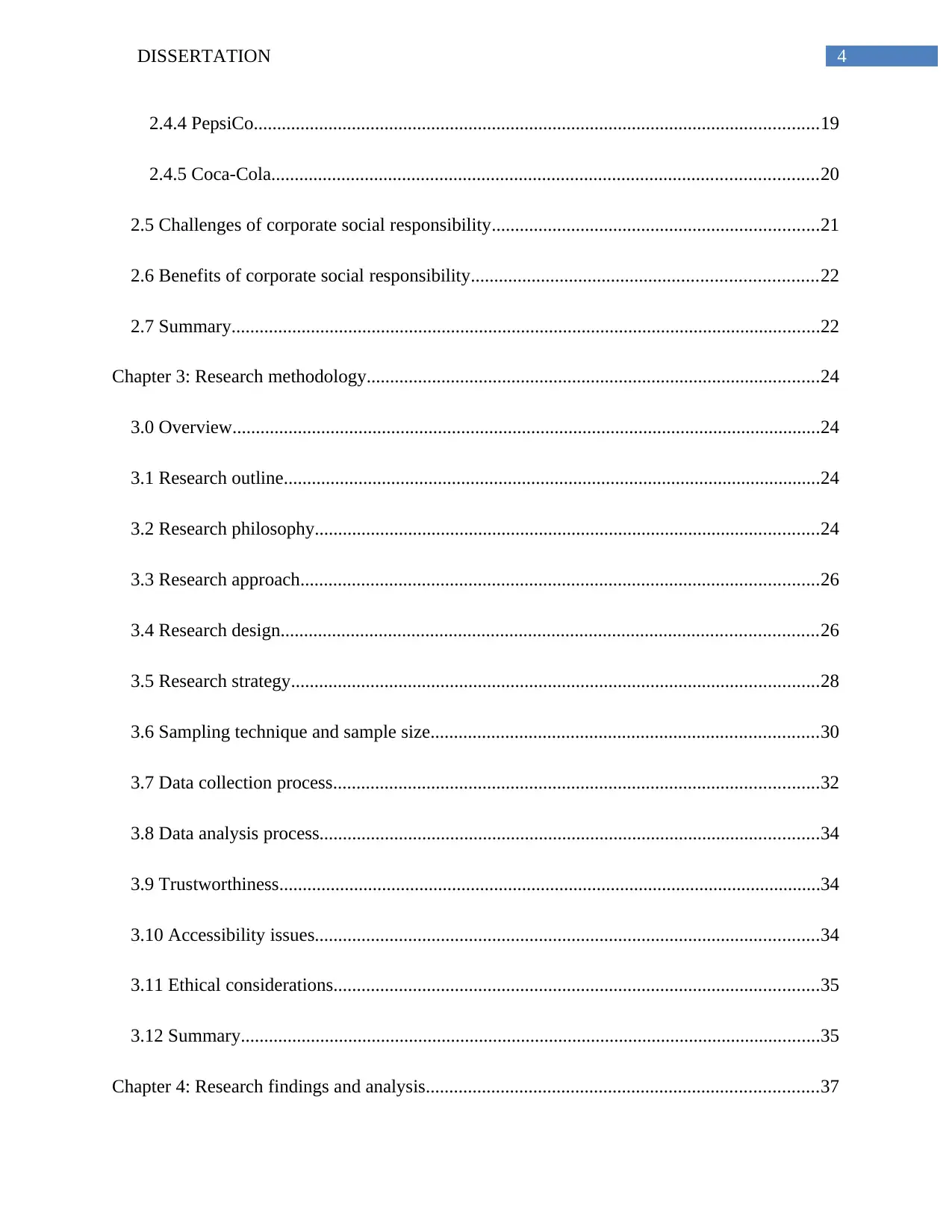
4DISSERTATION
2.4.4 PepsiCo.........................................................................................................................19
2.4.5 Coca-Cola.....................................................................................................................20
2.5 Challenges of corporate social responsibility......................................................................21
2.6 Benefits of corporate social responsibility..........................................................................22
2.7 Summary..............................................................................................................................22
Chapter 3: Research methodology.................................................................................................24
3.0 Overview..............................................................................................................................24
3.1 Research outline...................................................................................................................24
3.2 Research philosophy............................................................................................................24
3.3 Research approach...............................................................................................................26
3.4 Research design...................................................................................................................26
3.5 Research strategy.................................................................................................................28
3.6 Sampling technique and sample size...................................................................................30
3.7 Data collection process........................................................................................................32
3.8 Data analysis process...........................................................................................................34
3.9 Trustworthiness....................................................................................................................34
3.10 Accessibility issues............................................................................................................34
3.11 Ethical considerations........................................................................................................35
3.12 Summary............................................................................................................................35
Chapter 4: Research findings and analysis....................................................................................37
2.4.4 PepsiCo.........................................................................................................................19
2.4.5 Coca-Cola.....................................................................................................................20
2.5 Challenges of corporate social responsibility......................................................................21
2.6 Benefits of corporate social responsibility..........................................................................22
2.7 Summary..............................................................................................................................22
Chapter 3: Research methodology.................................................................................................24
3.0 Overview..............................................................................................................................24
3.1 Research outline...................................................................................................................24
3.2 Research philosophy............................................................................................................24
3.3 Research approach...............................................................................................................26
3.4 Research design...................................................................................................................26
3.5 Research strategy.................................................................................................................28
3.6 Sampling technique and sample size...................................................................................30
3.7 Data collection process........................................................................................................32
3.8 Data analysis process...........................................................................................................34
3.9 Trustworthiness....................................................................................................................34
3.10 Accessibility issues............................................................................................................34
3.11 Ethical considerations........................................................................................................35
3.12 Summary............................................................................................................................35
Chapter 4: Research findings and analysis....................................................................................37
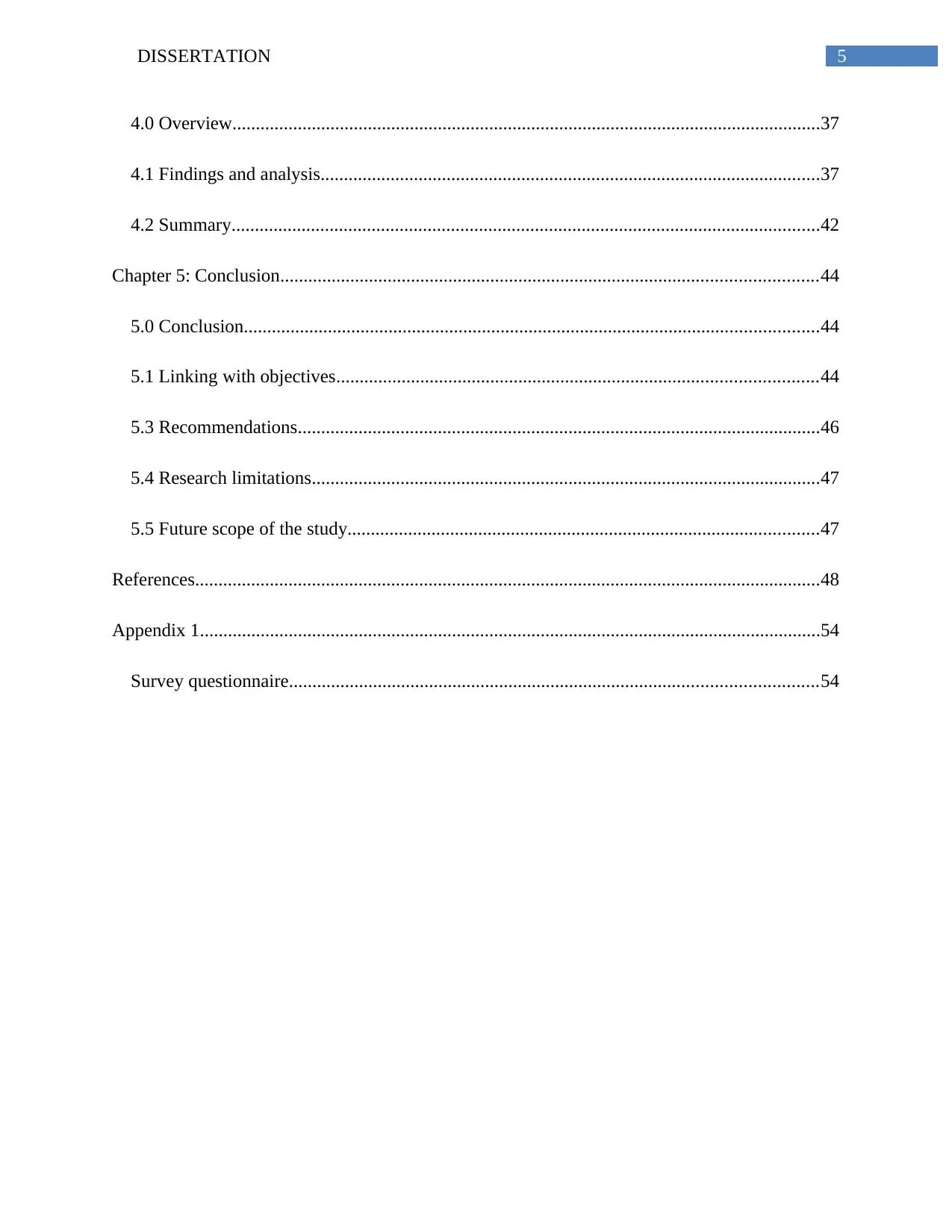
5DISSERTATION
4.0 Overview..............................................................................................................................37
4.1 Findings and analysis...........................................................................................................37
4.2 Summary..............................................................................................................................42
Chapter 5: Conclusion...................................................................................................................44
5.0 Conclusion...........................................................................................................................44
5.1 Linking with objectives.......................................................................................................44
5.3 Recommendations................................................................................................................46
5.4 Research limitations.............................................................................................................47
5.5 Future scope of the study.....................................................................................................47
References......................................................................................................................................48
Appendix 1.....................................................................................................................................54
Survey questionnaire.................................................................................................................54
4.0 Overview..............................................................................................................................37
4.1 Findings and analysis...........................................................................................................37
4.2 Summary..............................................................................................................................42
Chapter 5: Conclusion...................................................................................................................44
5.0 Conclusion...........................................................................................................................44
5.1 Linking with objectives.......................................................................................................44
5.3 Recommendations................................................................................................................46
5.4 Research limitations.............................................................................................................47
5.5 Future scope of the study.....................................................................................................47
References......................................................................................................................................48
Appendix 1.....................................................................................................................................54
Survey questionnaire.................................................................................................................54
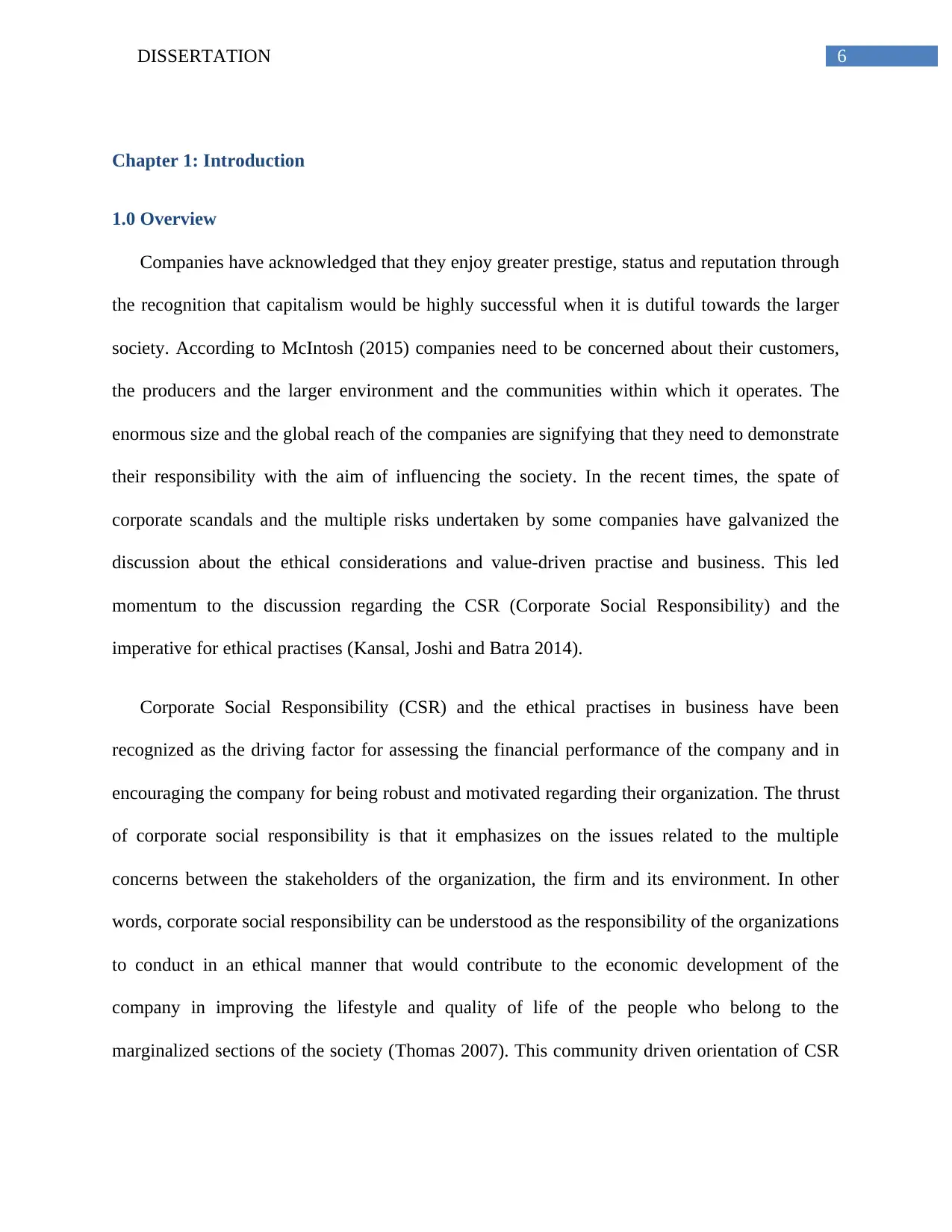
6DISSERTATION
Chapter 1: Introduction
1.0 Overview
Companies have acknowledged that they enjoy greater prestige, status and reputation through
the recognition that capitalism would be highly successful when it is dutiful towards the larger
society. According to McIntosh (2015) companies need to be concerned about their customers,
the producers and the larger environment and the communities within which it operates. The
enormous size and the global reach of the companies are signifying that they need to demonstrate
their responsibility with the aim of influencing the society. In the recent times, the spate of
corporate scandals and the multiple risks undertaken by some companies have galvanized the
discussion about the ethical considerations and value-driven practise and business. This led
momentum to the discussion regarding the CSR (Corporate Social Responsibility) and the
imperative for ethical practises (Kansal, Joshi and Batra 2014).
Corporate Social Responsibility (CSR) and the ethical practises in business have been
recognized as the driving factor for assessing the financial performance of the company and in
encouraging the company for being robust and motivated regarding their organization. The thrust
of corporate social responsibility is that it emphasizes on the issues related to the multiple
concerns between the stakeholders of the organization, the firm and its environment. In other
words, corporate social responsibility can be understood as the responsibility of the organizations
to conduct in an ethical manner that would contribute to the economic development of the
company in improving the lifestyle and quality of life of the people who belong to the
marginalized sections of the society (Thomas 2007). This community driven orientation of CSR
Chapter 1: Introduction
1.0 Overview
Companies have acknowledged that they enjoy greater prestige, status and reputation through
the recognition that capitalism would be highly successful when it is dutiful towards the larger
society. According to McIntosh (2015) companies need to be concerned about their customers,
the producers and the larger environment and the communities within which it operates. The
enormous size and the global reach of the companies are signifying that they need to demonstrate
their responsibility with the aim of influencing the society. In the recent times, the spate of
corporate scandals and the multiple risks undertaken by some companies have galvanized the
discussion about the ethical considerations and value-driven practise and business. This led
momentum to the discussion regarding the CSR (Corporate Social Responsibility) and the
imperative for ethical practises (Kansal, Joshi and Batra 2014).
Corporate Social Responsibility (CSR) and the ethical practises in business have been
recognized as the driving factor for assessing the financial performance of the company and in
encouraging the company for being robust and motivated regarding their organization. The thrust
of corporate social responsibility is that it emphasizes on the issues related to the multiple
concerns between the stakeholders of the organization, the firm and its environment. In other
words, corporate social responsibility can be understood as the responsibility of the organizations
to conduct in an ethical manner that would contribute to the economic development of the
company in improving the lifestyle and quality of life of the people who belong to the
marginalized sections of the society (Thomas 2007). This community driven orientation of CSR
Paraphrase This Document
Need a fresh take? Get an instant paraphrase of this document with our AI Paraphraser
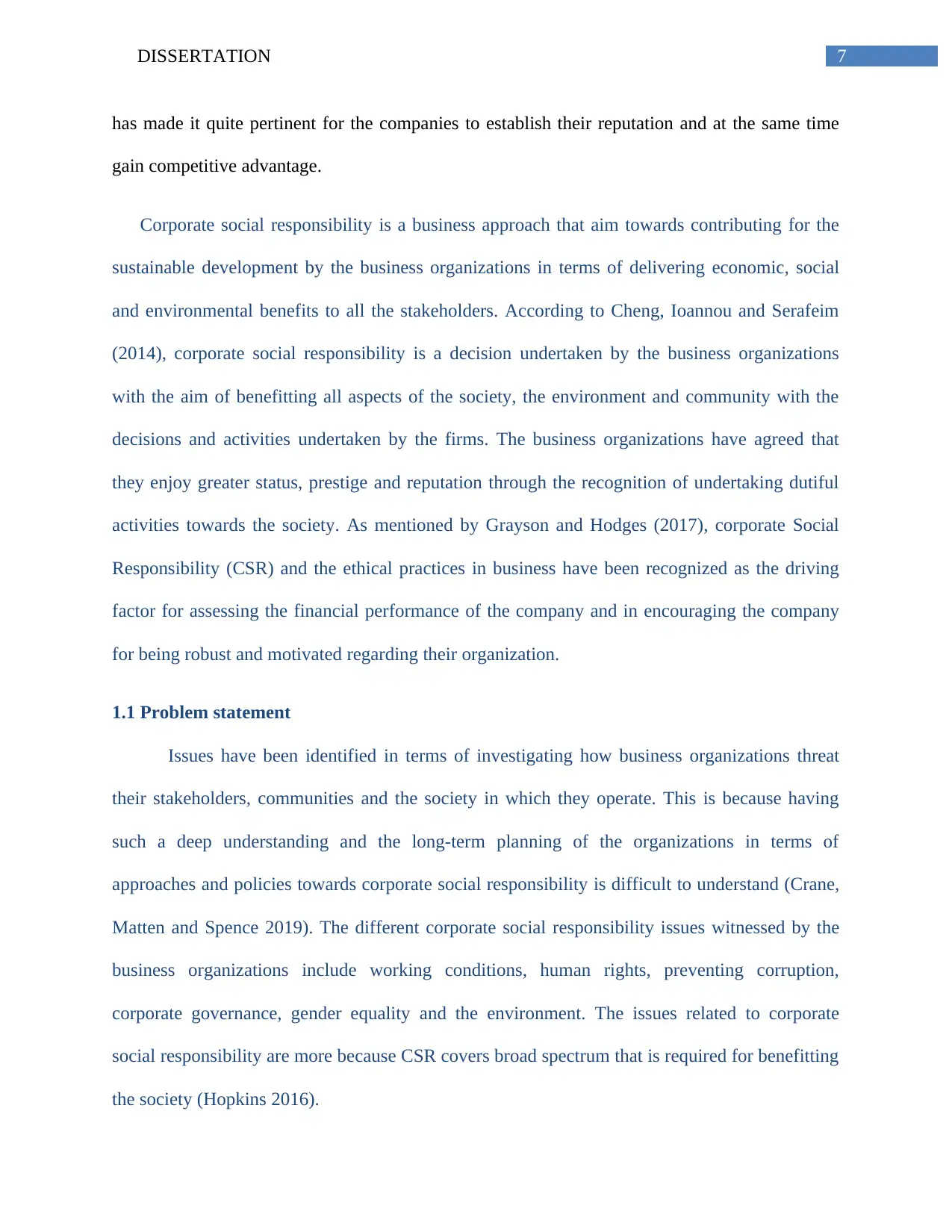
7DISSERTATION
has made it quite pertinent for the companies to establish their reputation and at the same time
gain competitive advantage.
Corporate social responsibility is a business approach that aim towards contributing for the
sustainable development by the business organizations in terms of delivering economic, social
and environmental benefits to all the stakeholders. According to Cheng, Ioannou and Serafeim
(2014), corporate social responsibility is a decision undertaken by the business organizations
with the aim of benefitting all aspects of the society, the environment and community with the
decisions and activities undertaken by the firms. The business organizations have agreed that
they enjoy greater status, prestige and reputation through the recognition of undertaking dutiful
activities towards the society. As mentioned by Grayson and Hodges (2017), corporate Social
Responsibility (CSR) and the ethical practices in business have been recognized as the driving
factor for assessing the financial performance of the company and in encouraging the company
for being robust and motivated regarding their organization.
1.1 Problem statement
Issues have been identified in terms of investigating how business organizations threat
their stakeholders, communities and the society in which they operate. This is because having
such a deep understanding and the long-term planning of the organizations in terms of
approaches and policies towards corporate social responsibility is difficult to understand (Crane,
Matten and Spence 2019). The different corporate social responsibility issues witnessed by the
business organizations include working conditions, human rights, preventing corruption,
corporate governance, gender equality and the environment. The issues related to corporate
social responsibility are more because CSR covers broad spectrum that is required for benefitting
the society (Hopkins 2016).
has made it quite pertinent for the companies to establish their reputation and at the same time
gain competitive advantage.
Corporate social responsibility is a business approach that aim towards contributing for the
sustainable development by the business organizations in terms of delivering economic, social
and environmental benefits to all the stakeholders. According to Cheng, Ioannou and Serafeim
(2014), corporate social responsibility is a decision undertaken by the business organizations
with the aim of benefitting all aspects of the society, the environment and community with the
decisions and activities undertaken by the firms. The business organizations have agreed that
they enjoy greater status, prestige and reputation through the recognition of undertaking dutiful
activities towards the society. As mentioned by Grayson and Hodges (2017), corporate Social
Responsibility (CSR) and the ethical practices in business have been recognized as the driving
factor for assessing the financial performance of the company and in encouraging the company
for being robust and motivated regarding their organization.
1.1 Problem statement
Issues have been identified in terms of investigating how business organizations threat
their stakeholders, communities and the society in which they operate. This is because having
such a deep understanding and the long-term planning of the organizations in terms of
approaches and policies towards corporate social responsibility is difficult to understand (Crane,
Matten and Spence 2019). The different corporate social responsibility issues witnessed by the
business organizations include working conditions, human rights, preventing corruption,
corporate governance, gender equality and the environment. The issues related to corporate
social responsibility are more because CSR covers broad spectrum that is required for benefitting
the society (Hopkins 2016).
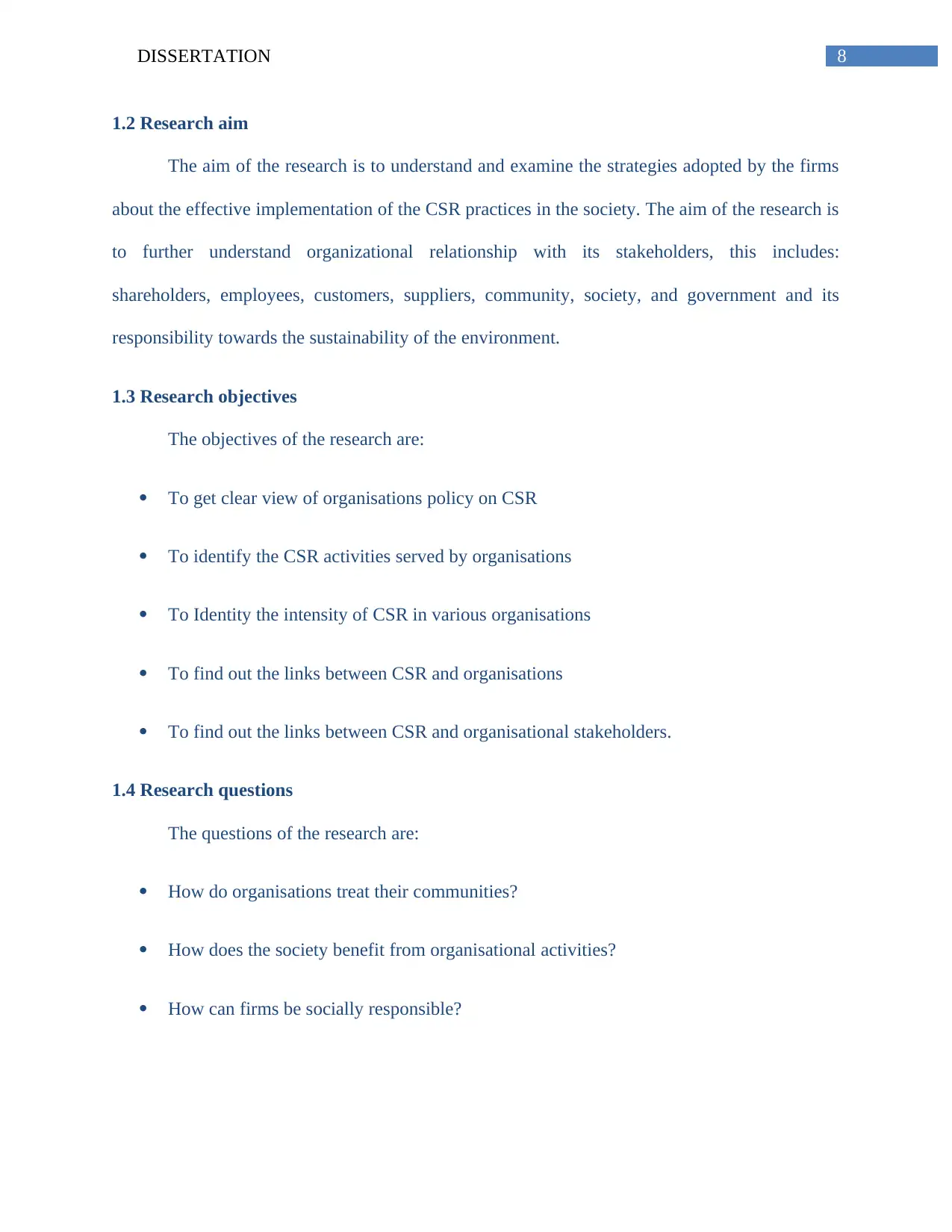
8DISSERTATION
1.2 Research aim
The aim of the research is to understand and examine the strategies adopted by the firms
about the effective implementation of the CSR practices in the society. The aim of the research is
to further understand organizational relationship with its stakeholders, this includes:
shareholders, employees, customers, suppliers, community, society, and government and its
responsibility towards the sustainability of the environment.
1.3 Research objectives
The objectives of the research are:
To get clear view of organisations policy on CSR
To identify the CSR activities served by organisations
To Identity the intensity of CSR in various organisations
To find out the links between CSR and organisations
To find out the links between CSR and organisational stakeholders.
1.4 Research questions
The questions of the research are:
How do organisations treat their communities?
How does the society benefit from organisational activities?
How can firms be socially responsible?
1.2 Research aim
The aim of the research is to understand and examine the strategies adopted by the firms
about the effective implementation of the CSR practices in the society. The aim of the research is
to further understand organizational relationship with its stakeholders, this includes:
shareholders, employees, customers, suppliers, community, society, and government and its
responsibility towards the sustainability of the environment.
1.3 Research objectives
The objectives of the research are:
To get clear view of organisations policy on CSR
To identify the CSR activities served by organisations
To Identity the intensity of CSR in various organisations
To find out the links between CSR and organisations
To find out the links between CSR and organisational stakeholders.
1.4 Research questions
The questions of the research are:
How do organisations treat their communities?
How does the society benefit from organisational activities?
How can firms be socially responsible?
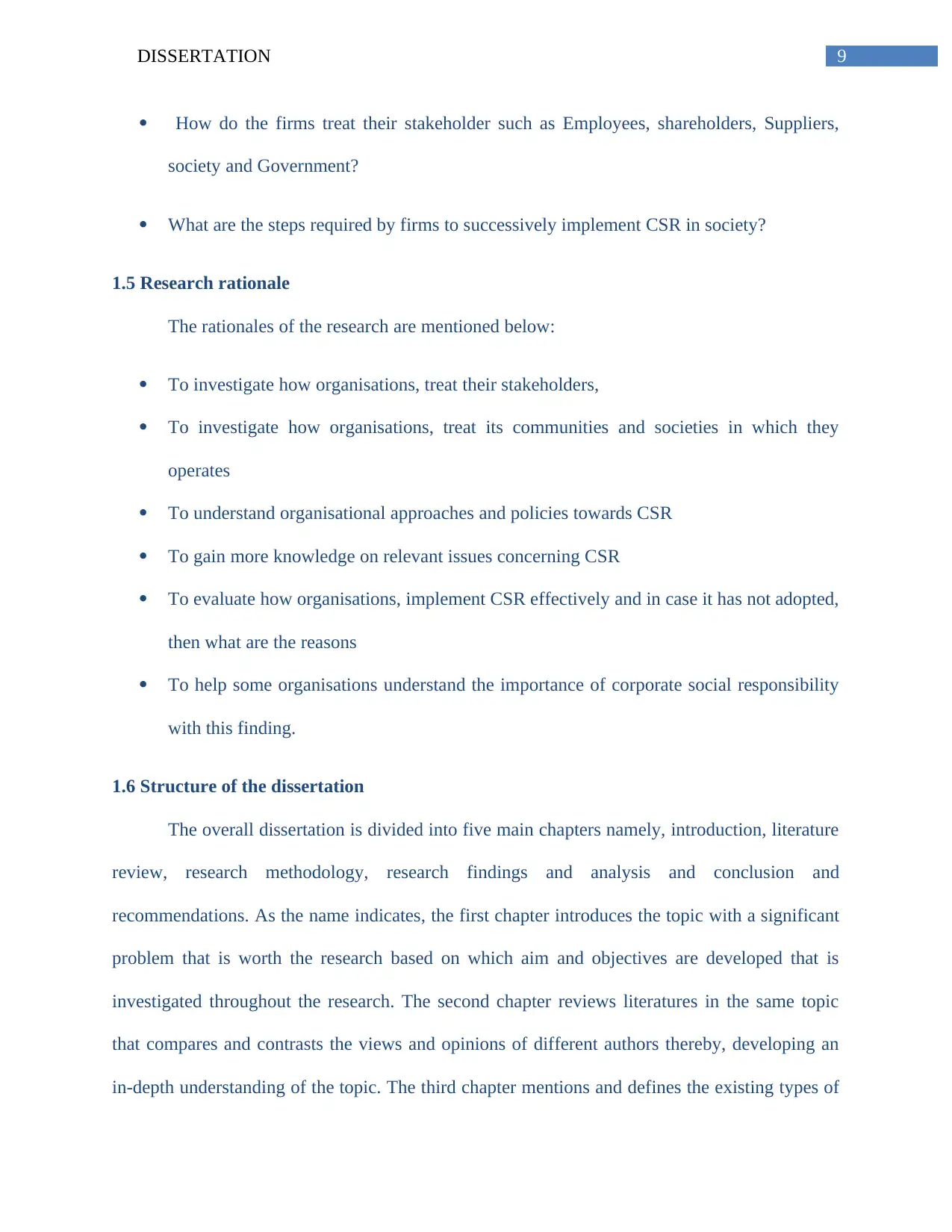
9DISSERTATION
How do the firms treat their stakeholder such as Employees, shareholders, Suppliers,
society and Government?
What are the steps required by firms to successively implement CSR in society?
1.5 Research rationale
The rationales of the research are mentioned below:
To investigate how organisations, treat their stakeholders,
To investigate how organisations, treat its communities and societies in which they
operates
To understand organisational approaches and policies towards CSR
To gain more knowledge on relevant issues concerning CSR
To evaluate how organisations, implement CSR effectively and in case it has not adopted,
then what are the reasons
To help some organisations understand the importance of corporate social responsibility
with this finding.
1.6 Structure of the dissertation
The overall dissertation is divided into five main chapters namely, introduction, literature
review, research methodology, research findings and analysis and conclusion and
recommendations. As the name indicates, the first chapter introduces the topic with a significant
problem that is worth the research based on which aim and objectives are developed that is
investigated throughout the research. The second chapter reviews literatures in the same topic
that compares and contrasts the views and opinions of different authors thereby, developing an
in-depth understanding of the topic. The third chapter mentions and defines the existing types of
How do the firms treat their stakeholder such as Employees, shareholders, Suppliers,
society and Government?
What are the steps required by firms to successively implement CSR in society?
1.5 Research rationale
The rationales of the research are mentioned below:
To investigate how organisations, treat their stakeholders,
To investigate how organisations, treat its communities and societies in which they
operates
To understand organisational approaches and policies towards CSR
To gain more knowledge on relevant issues concerning CSR
To evaluate how organisations, implement CSR effectively and in case it has not adopted,
then what are the reasons
To help some organisations understand the importance of corporate social responsibility
with this finding.
1.6 Structure of the dissertation
The overall dissertation is divided into five main chapters namely, introduction, literature
review, research methodology, research findings and analysis and conclusion and
recommendations. As the name indicates, the first chapter introduces the topic with a significant
problem that is worth the research based on which aim and objectives are developed that is
investigated throughout the research. The second chapter reviews literatures in the same topic
that compares and contrasts the views and opinions of different authors thereby, developing an
in-depth understanding of the topic. The third chapter mentions and defines the existing types of
Secure Best Marks with AI Grader
Need help grading? Try our AI Grader for instant feedback on your assignments.
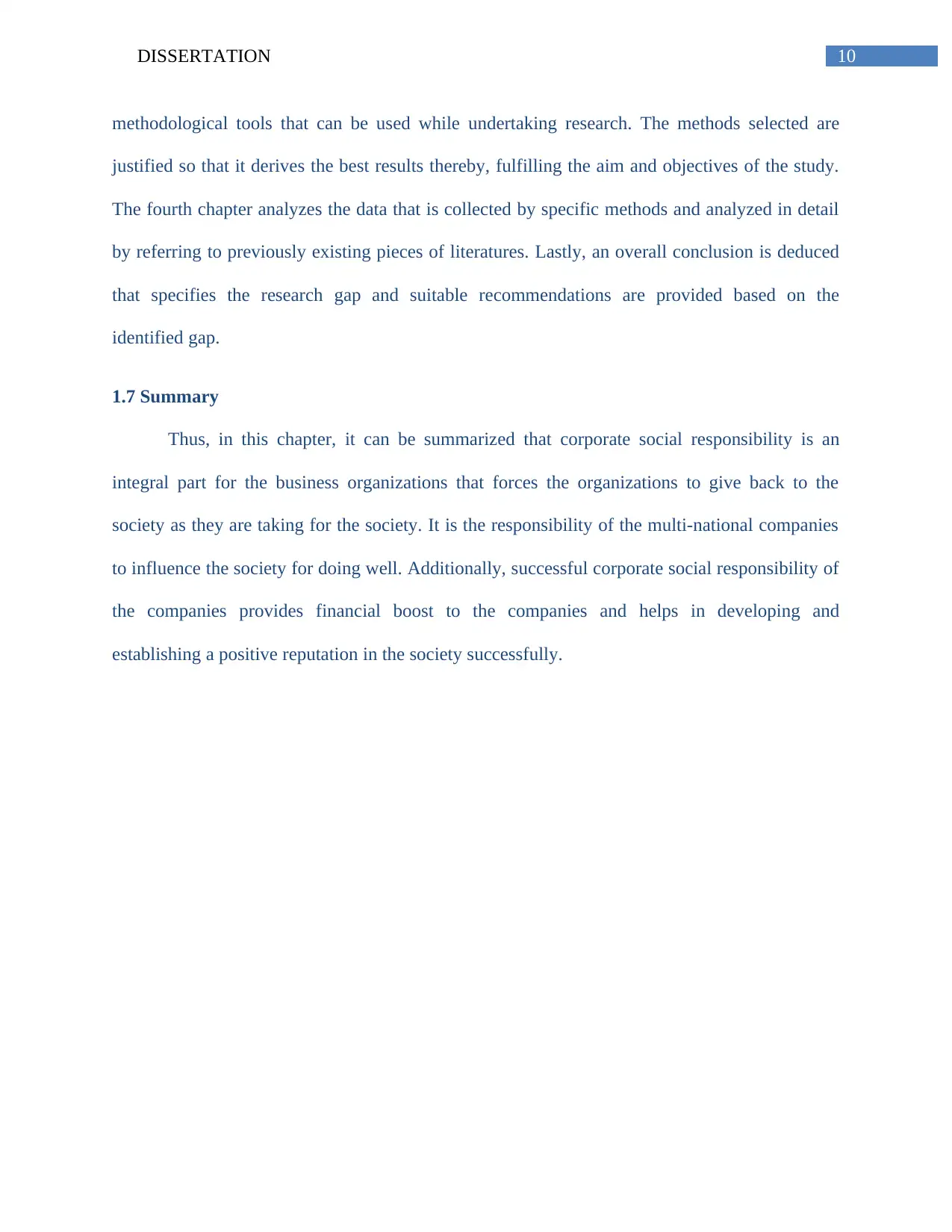
10DISSERTATION
methodological tools that can be used while undertaking research. The methods selected are
justified so that it derives the best results thereby, fulfilling the aim and objectives of the study.
The fourth chapter analyzes the data that is collected by specific methods and analyzed in detail
by referring to previously existing pieces of literatures. Lastly, an overall conclusion is deduced
that specifies the research gap and suitable recommendations are provided based on the
identified gap.
1.7 Summary
Thus, in this chapter, it can be summarized that corporate social responsibility is an
integral part for the business organizations that forces the organizations to give back to the
society as they are taking for the society. It is the responsibility of the multi-national companies
to influence the society for doing well. Additionally, successful corporate social responsibility of
the companies provides financial boost to the companies and helps in developing and
establishing a positive reputation in the society successfully.
methodological tools that can be used while undertaking research. The methods selected are
justified so that it derives the best results thereby, fulfilling the aim and objectives of the study.
The fourth chapter analyzes the data that is collected by specific methods and analyzed in detail
by referring to previously existing pieces of literatures. Lastly, an overall conclusion is deduced
that specifies the research gap and suitable recommendations are provided based on the
identified gap.
1.7 Summary
Thus, in this chapter, it can be summarized that corporate social responsibility is an
integral part for the business organizations that forces the organizations to give back to the
society as they are taking for the society. It is the responsibility of the multi-national companies
to influence the society for doing well. Additionally, successful corporate social responsibility of
the companies provides financial boost to the companies and helps in developing and
establishing a positive reputation in the society successfully.
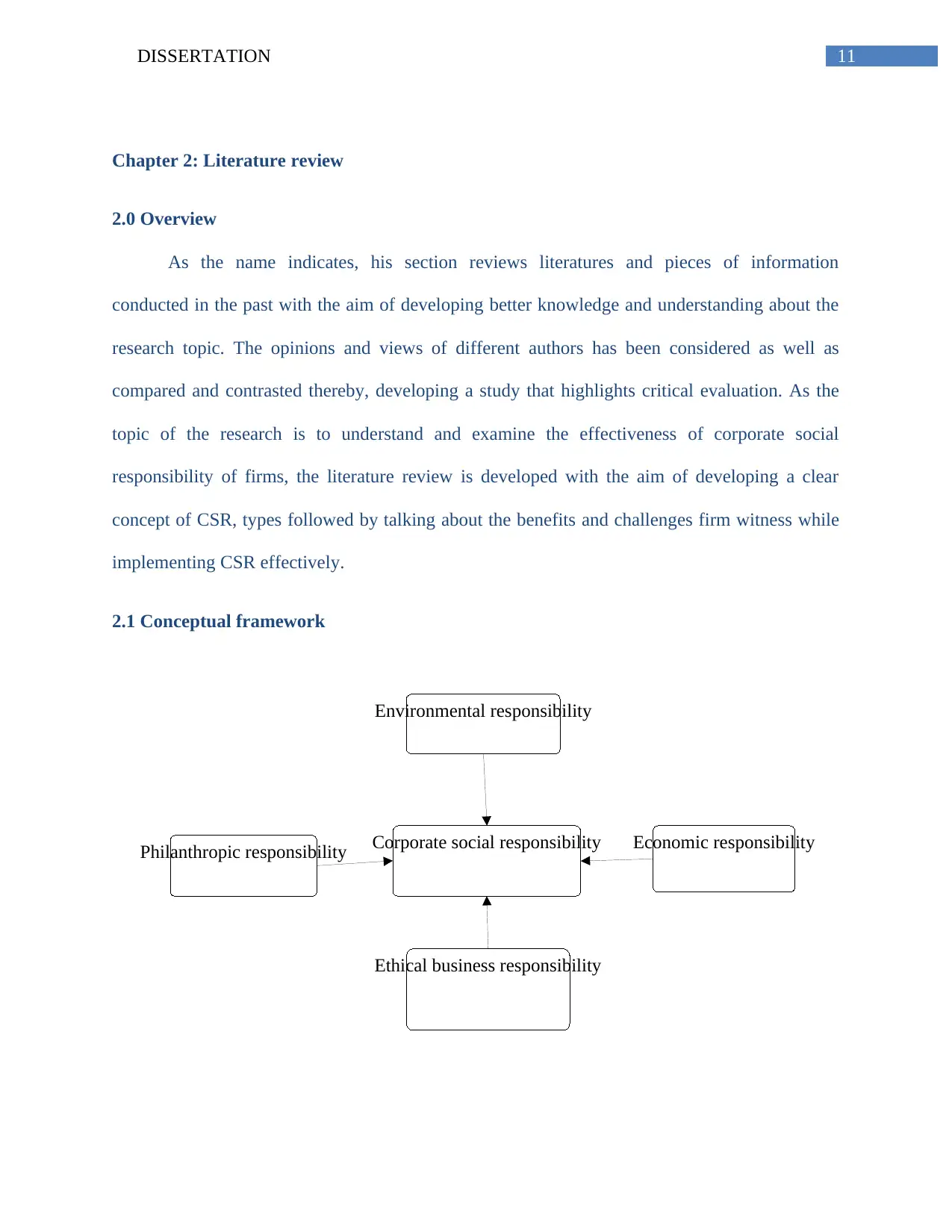
11DISSERTATION
Corporate social responsibility
Philanthropic responsibility
Environmental responsibility
Economic responsibility
Ethical business responsibility
Chapter 2: Literature review
2.0 Overview
As the name indicates, his section reviews literatures and pieces of information
conducted in the past with the aim of developing better knowledge and understanding about the
research topic. The opinions and views of different authors has been considered as well as
compared and contrasted thereby, developing a study that highlights critical evaluation. As the
topic of the research is to understand and examine the effectiveness of corporate social
responsibility of firms, the literature review is developed with the aim of developing a clear
concept of CSR, types followed by talking about the benefits and challenges firm witness while
implementing CSR effectively.
2.1 Conceptual framework
Corporate social responsibility
Philanthropic responsibility
Environmental responsibility
Economic responsibility
Ethical business responsibility
Chapter 2: Literature review
2.0 Overview
As the name indicates, his section reviews literatures and pieces of information
conducted in the past with the aim of developing better knowledge and understanding about the
research topic. The opinions and views of different authors has been considered as well as
compared and contrasted thereby, developing a study that highlights critical evaluation. As the
topic of the research is to understand and examine the effectiveness of corporate social
responsibility of firms, the literature review is developed with the aim of developing a clear
concept of CSR, types followed by talking about the benefits and challenges firm witness while
implementing CSR effectively.
2.1 Conceptual framework
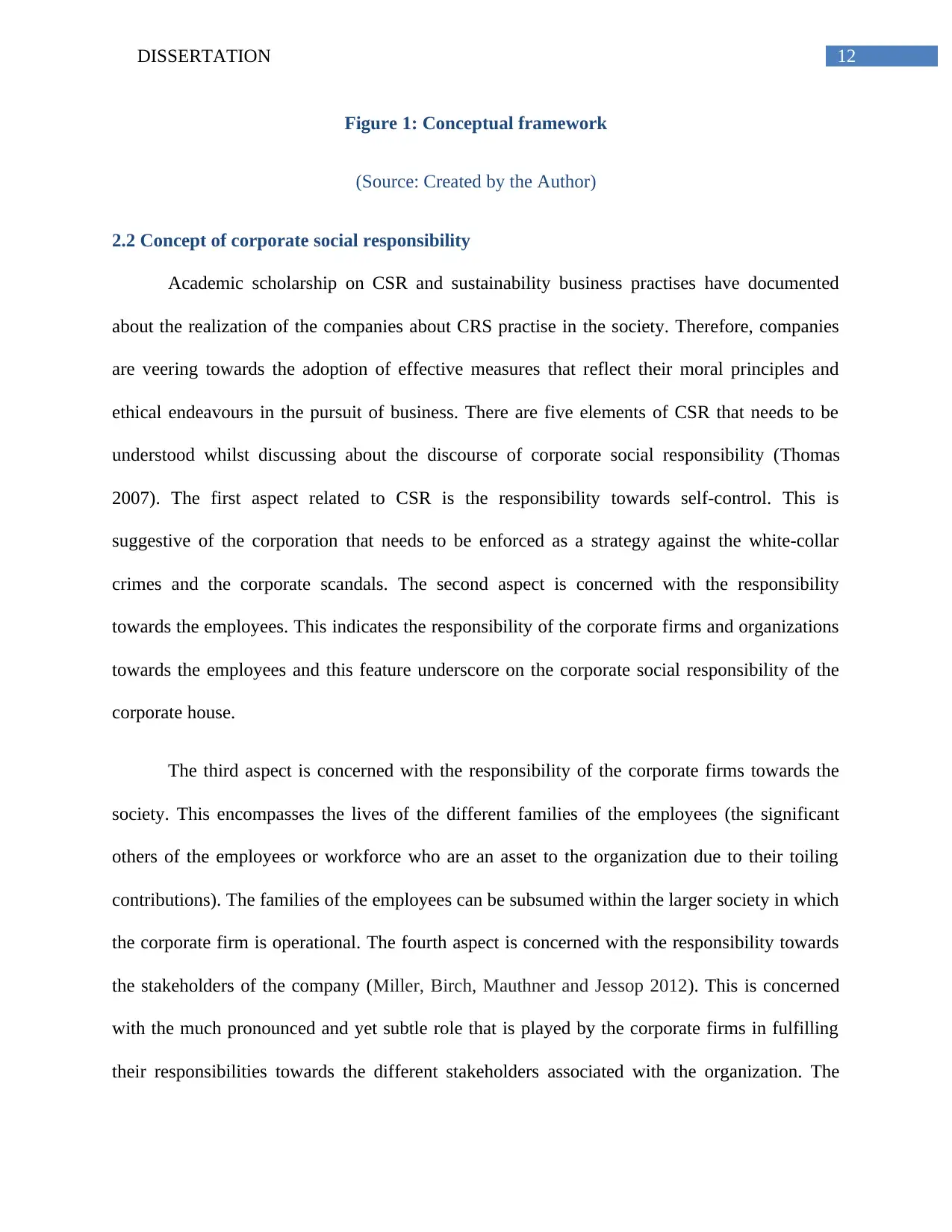
12DISSERTATION
Figure 1: Conceptual framework
(Source: Created by the Author)
2.2 Concept of corporate social responsibility
Academic scholarship on CSR and sustainability business practises have documented
about the realization of the companies about CRS practise in the society. Therefore, companies
are veering towards the adoption of effective measures that reflect their moral principles and
ethical endeavours in the pursuit of business. There are five elements of CSR that needs to be
understood whilst discussing about the discourse of corporate social responsibility (Thomas
2007). The first aspect related to CSR is the responsibility towards self-control. This is
suggestive of the corporation that needs to be enforced as a strategy against the white-collar
crimes and the corporate scandals. The second aspect is concerned with the responsibility
towards the employees. This indicates the responsibility of the corporate firms and organizations
towards the employees and this feature underscore on the corporate social responsibility of the
corporate house.
The third aspect is concerned with the responsibility of the corporate firms towards the
society. This encompasses the lives of the different families of the employees (the significant
others of the employees or workforce who are an asset to the organization due to their toiling
contributions). The families of the employees can be subsumed within the larger society in which
the corporate firm is operational. The fourth aspect is concerned with the responsibility towards
the stakeholders of the company (Miller, Birch, Mauthner and Jessop 2012). This is concerned
with the much pronounced and yet subtle role that is played by the corporate firms in fulfilling
their responsibilities towards the different stakeholders associated with the organization. The
Figure 1: Conceptual framework
(Source: Created by the Author)
2.2 Concept of corporate social responsibility
Academic scholarship on CSR and sustainability business practises have documented
about the realization of the companies about CRS practise in the society. Therefore, companies
are veering towards the adoption of effective measures that reflect their moral principles and
ethical endeavours in the pursuit of business. There are five elements of CSR that needs to be
understood whilst discussing about the discourse of corporate social responsibility (Thomas
2007). The first aspect related to CSR is the responsibility towards self-control. This is
suggestive of the corporation that needs to be enforced as a strategy against the white-collar
crimes and the corporate scandals. The second aspect is concerned with the responsibility
towards the employees. This indicates the responsibility of the corporate firms and organizations
towards the employees and this feature underscore on the corporate social responsibility of the
corporate house.
The third aspect is concerned with the responsibility of the corporate firms towards the
society. This encompasses the lives of the different families of the employees (the significant
others of the employees or workforce who are an asset to the organization due to their toiling
contributions). The families of the employees can be subsumed within the larger society in which
the corporate firm is operational. The fourth aspect is concerned with the responsibility towards
the stakeholders of the company (Miller, Birch, Mauthner and Jessop 2012). This is concerned
with the much pronounced and yet subtle role that is played by the corporate firms in fulfilling
their responsibilities towards the different stakeholders associated with the organization. The
Paraphrase This Document
Need a fresh take? Get an instant paraphrase of this document with our AI Paraphraser
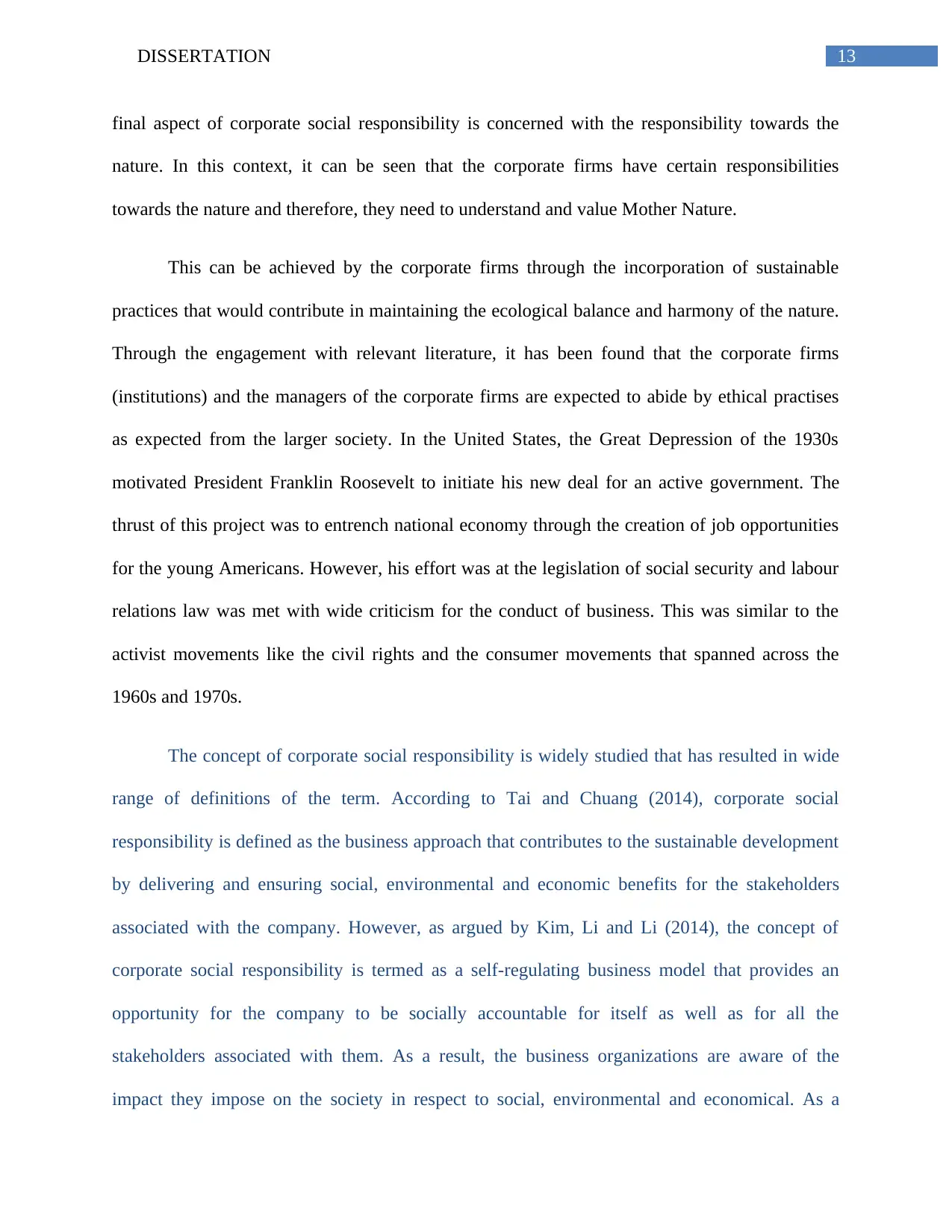
13DISSERTATION
final aspect of corporate social responsibility is concerned with the responsibility towards the
nature. In this context, it can be seen that the corporate firms have certain responsibilities
towards the nature and therefore, they need to understand and value Mother Nature.
This can be achieved by the corporate firms through the incorporation of sustainable
practices that would contribute in maintaining the ecological balance and harmony of the nature.
Through the engagement with relevant literature, it has been found that the corporate firms
(institutions) and the managers of the corporate firms are expected to abide by ethical practises
as expected from the larger society. In the United States, the Great Depression of the 1930s
motivated President Franklin Roosevelt to initiate his new deal for an active government. The
thrust of this project was to entrench national economy through the creation of job opportunities
for the young Americans. However, his effort was at the legislation of social security and labour
relations law was met with wide criticism for the conduct of business. This was similar to the
activist movements like the civil rights and the consumer movements that spanned across the
1960s and 1970s.
The concept of corporate social responsibility is widely studied that has resulted in wide
range of definitions of the term. According to Tai and Chuang (2014), corporate social
responsibility is defined as the business approach that contributes to the sustainable development
by delivering and ensuring social, environmental and economic benefits for the stakeholders
associated with the company. However, as argued by Kim, Li and Li (2014), the concept of
corporate social responsibility is termed as a self-regulating business model that provides an
opportunity for the company to be socially accountable for itself as well as for all the
stakeholders associated with them. As a result, the business organizations are aware of the
impact they impose on the society in respect to social, environmental and economical. As a
final aspect of corporate social responsibility is concerned with the responsibility towards the
nature. In this context, it can be seen that the corporate firms have certain responsibilities
towards the nature and therefore, they need to understand and value Mother Nature.
This can be achieved by the corporate firms through the incorporation of sustainable
practices that would contribute in maintaining the ecological balance and harmony of the nature.
Through the engagement with relevant literature, it has been found that the corporate firms
(institutions) and the managers of the corporate firms are expected to abide by ethical practises
as expected from the larger society. In the United States, the Great Depression of the 1930s
motivated President Franklin Roosevelt to initiate his new deal for an active government. The
thrust of this project was to entrench national economy through the creation of job opportunities
for the young Americans. However, his effort was at the legislation of social security and labour
relations law was met with wide criticism for the conduct of business. This was similar to the
activist movements like the civil rights and the consumer movements that spanned across the
1960s and 1970s.
The concept of corporate social responsibility is widely studied that has resulted in wide
range of definitions of the term. According to Tai and Chuang (2014), corporate social
responsibility is defined as the business approach that contributes to the sustainable development
by delivering and ensuring social, environmental and economic benefits for the stakeholders
associated with the company. However, as argued by Kim, Li and Li (2014), the concept of
corporate social responsibility is termed as a self-regulating business model that provides an
opportunity for the company to be socially accountable for itself as well as for all the
stakeholders associated with them. As a result, the business organizations are aware of the
impact they impose on the society in respect to social, environmental and economical. As a
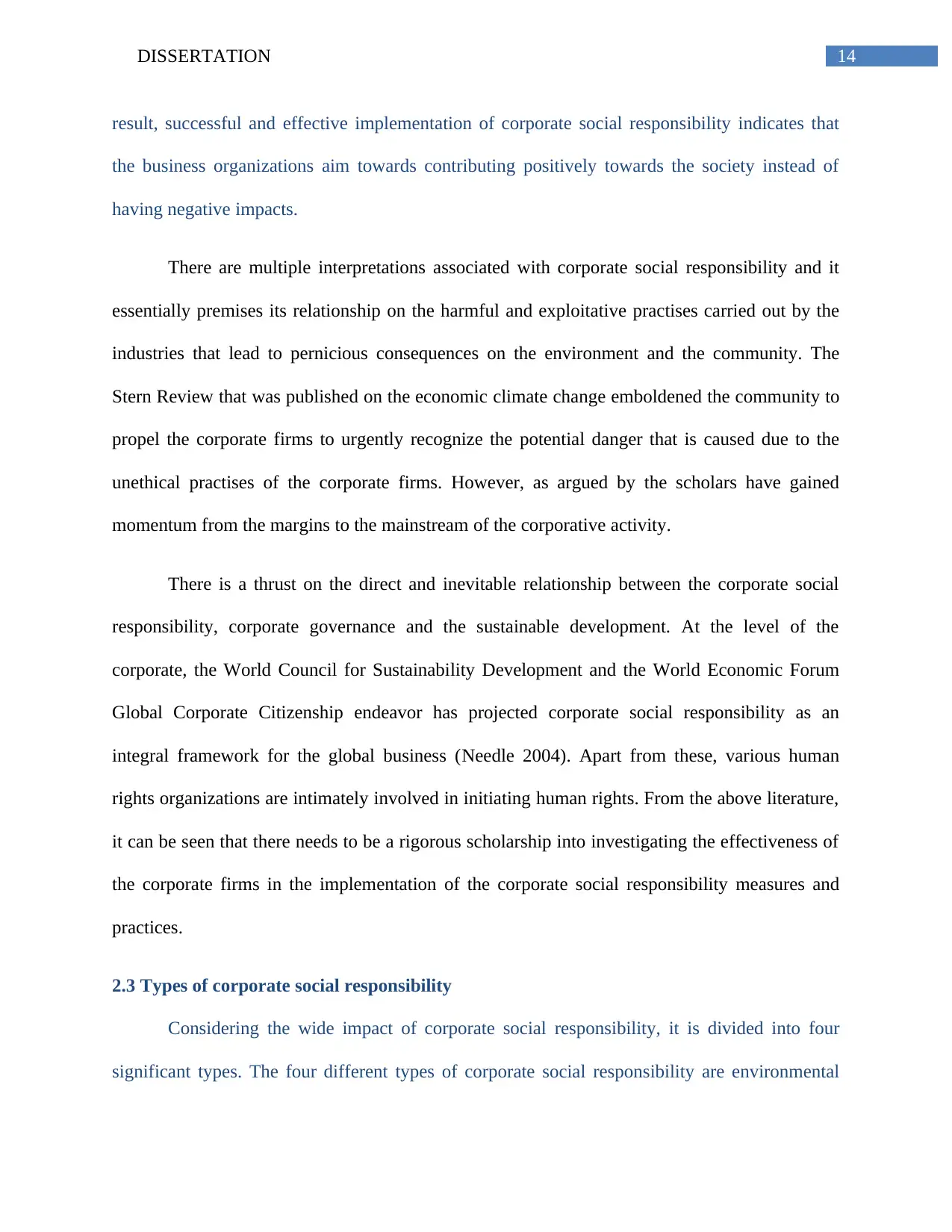
14DISSERTATION
result, successful and effective implementation of corporate social responsibility indicates that
the business organizations aim towards contributing positively towards the society instead of
having negative impacts.
There are multiple interpretations associated with corporate social responsibility and it
essentially premises its relationship on the harmful and exploitative practises carried out by the
industries that lead to pernicious consequences on the environment and the community. The
Stern Review that was published on the economic climate change emboldened the community to
propel the corporate firms to urgently recognize the potential danger that is caused due to the
unethical practises of the corporate firms. However, as argued by the scholars have gained
momentum from the margins to the mainstream of the corporative activity.
There is a thrust on the direct and inevitable relationship between the corporate social
responsibility, corporate governance and the sustainable development. At the level of the
corporate, the World Council for Sustainability Development and the World Economic Forum
Global Corporate Citizenship endeavor has projected corporate social responsibility as an
integral framework for the global business (Needle 2004). Apart from these, various human
rights organizations are intimately involved in initiating human rights. From the above literature,
it can be seen that there needs to be a rigorous scholarship into investigating the effectiveness of
the corporate firms in the implementation of the corporate social responsibility measures and
practices.
2.3 Types of corporate social responsibility
Considering the wide impact of corporate social responsibility, it is divided into four
significant types. The four different types of corporate social responsibility are environmental
result, successful and effective implementation of corporate social responsibility indicates that
the business organizations aim towards contributing positively towards the society instead of
having negative impacts.
There are multiple interpretations associated with corporate social responsibility and it
essentially premises its relationship on the harmful and exploitative practises carried out by the
industries that lead to pernicious consequences on the environment and the community. The
Stern Review that was published on the economic climate change emboldened the community to
propel the corporate firms to urgently recognize the potential danger that is caused due to the
unethical practises of the corporate firms. However, as argued by the scholars have gained
momentum from the margins to the mainstream of the corporative activity.
There is a thrust on the direct and inevitable relationship between the corporate social
responsibility, corporate governance and the sustainable development. At the level of the
corporate, the World Council for Sustainability Development and the World Economic Forum
Global Corporate Citizenship endeavor has projected corporate social responsibility as an
integral framework for the global business (Needle 2004). Apart from these, various human
rights organizations are intimately involved in initiating human rights. From the above literature,
it can be seen that there needs to be a rigorous scholarship into investigating the effectiveness of
the corporate firms in the implementation of the corporate social responsibility measures and
practices.
2.3 Types of corporate social responsibility
Considering the wide impact of corporate social responsibility, it is divided into four
significant types. The four different types of corporate social responsibility are environmental
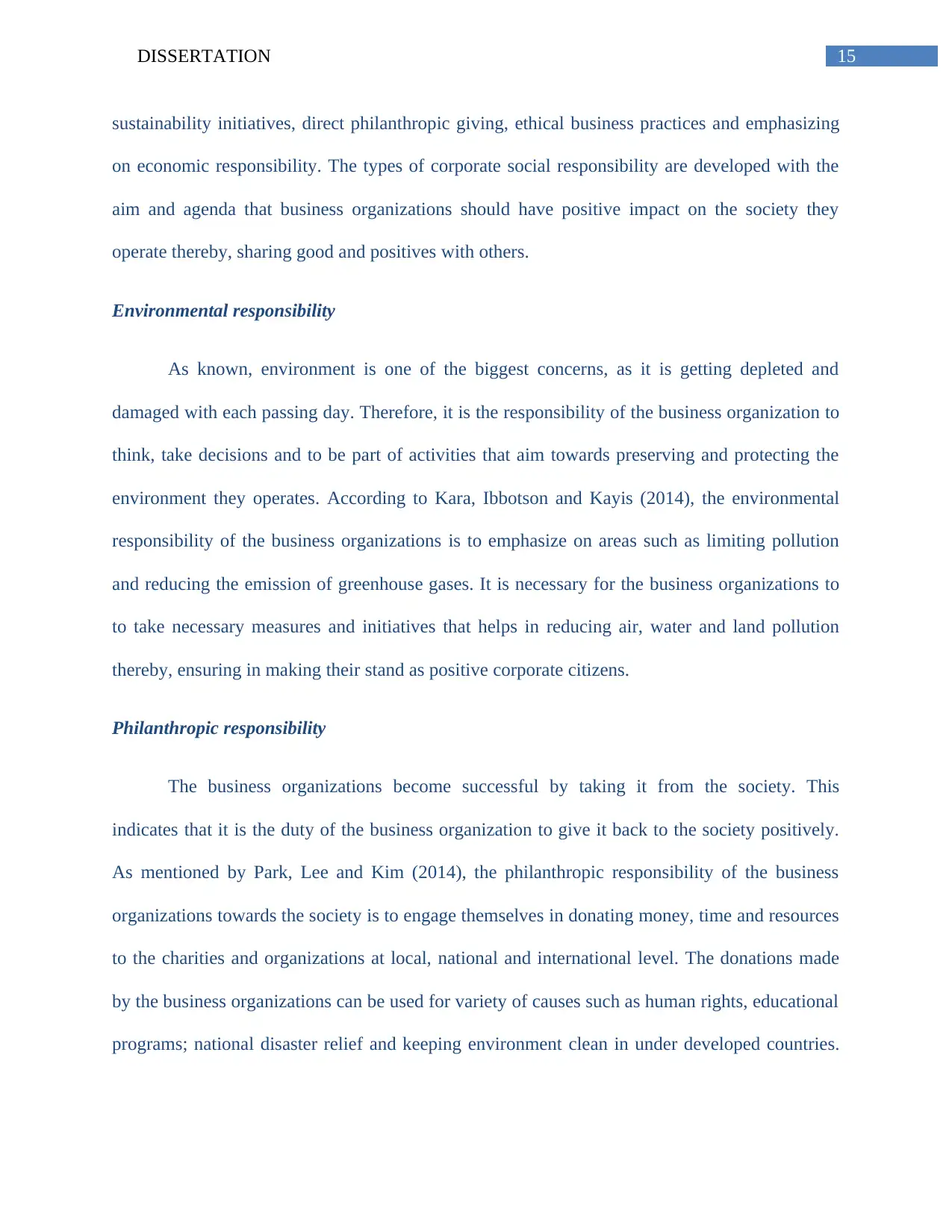
15DISSERTATION
sustainability initiatives, direct philanthropic giving, ethical business practices and emphasizing
on economic responsibility. The types of corporate social responsibility are developed with the
aim and agenda that business organizations should have positive impact on the society they
operate thereby, sharing good and positives with others.
Environmental responsibility
As known, environment is one of the biggest concerns, as it is getting depleted and
damaged with each passing day. Therefore, it is the responsibility of the business organization to
think, take decisions and to be part of activities that aim towards preserving and protecting the
environment they operates. According to Kara, Ibbotson and Kayis (2014), the environmental
responsibility of the business organizations is to emphasize on areas such as limiting pollution
and reducing the emission of greenhouse gases. It is necessary for the business organizations to
to take necessary measures and initiatives that helps in reducing air, water and land pollution
thereby, ensuring in making their stand as positive corporate citizens.
Philanthropic responsibility
The business organizations become successful by taking it from the society. This
indicates that it is the duty of the business organization to give it back to the society positively.
As mentioned by Park, Lee and Kim (2014), the philanthropic responsibility of the business
organizations towards the society is to engage themselves in donating money, time and resources
to the charities and organizations at local, national and international level. The donations made
by the business organizations can be used for variety of causes such as human rights, educational
programs; national disaster relief and keeping environment clean in under developed countries.
sustainability initiatives, direct philanthropic giving, ethical business practices and emphasizing
on economic responsibility. The types of corporate social responsibility are developed with the
aim and agenda that business organizations should have positive impact on the society they
operate thereby, sharing good and positives with others.
Environmental responsibility
As known, environment is one of the biggest concerns, as it is getting depleted and
damaged with each passing day. Therefore, it is the responsibility of the business organization to
think, take decisions and to be part of activities that aim towards preserving and protecting the
environment they operates. According to Kara, Ibbotson and Kayis (2014), the environmental
responsibility of the business organizations is to emphasize on areas such as limiting pollution
and reducing the emission of greenhouse gases. It is necessary for the business organizations to
to take necessary measures and initiatives that helps in reducing air, water and land pollution
thereby, ensuring in making their stand as positive corporate citizens.
Philanthropic responsibility
The business organizations become successful by taking it from the society. This
indicates that it is the duty of the business organization to give it back to the society positively.
As mentioned by Park, Lee and Kim (2014), the philanthropic responsibility of the business
organizations towards the society is to engage themselves in donating money, time and resources
to the charities and organizations at local, national and international level. The donations made
by the business organizations can be used for variety of causes such as human rights, educational
programs; national disaster relief and keeping environment clean in under developed countries.
Secure Best Marks with AI Grader
Need help grading? Try our AI Grader for instant feedback on your assignments.
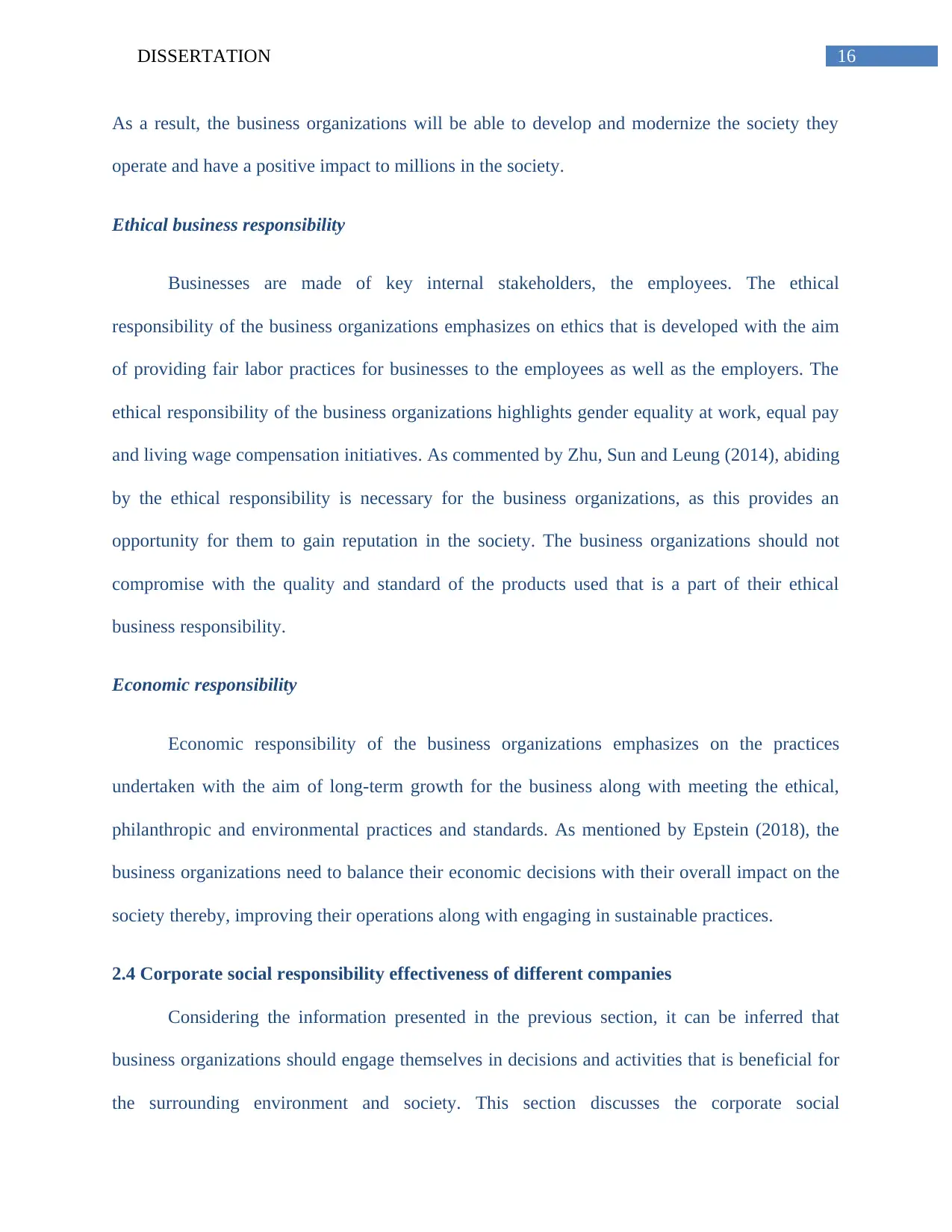
16DISSERTATION
As a result, the business organizations will be able to develop and modernize the society they
operate and have a positive impact to millions in the society.
Ethical business responsibility
Businesses are made of key internal stakeholders, the employees. The ethical
responsibility of the business organizations emphasizes on ethics that is developed with the aim
of providing fair labor practices for businesses to the employees as well as the employers. The
ethical responsibility of the business organizations highlights gender equality at work, equal pay
and living wage compensation initiatives. As commented by Zhu, Sun and Leung (2014), abiding
by the ethical responsibility is necessary for the business organizations, as this provides an
opportunity for them to gain reputation in the society. The business organizations should not
compromise with the quality and standard of the products used that is a part of their ethical
business responsibility.
Economic responsibility
Economic responsibility of the business organizations emphasizes on the practices
undertaken with the aim of long-term growth for the business along with meeting the ethical,
philanthropic and environmental practices and standards. As mentioned by Epstein (2018), the
business organizations need to balance their economic decisions with their overall impact on the
society thereby, improving their operations along with engaging in sustainable practices.
2.4 Corporate social responsibility effectiveness of different companies
Considering the information presented in the previous section, it can be inferred that
business organizations should engage themselves in decisions and activities that is beneficial for
the surrounding environment and society. This section discusses the corporate social
As a result, the business organizations will be able to develop and modernize the society they
operate and have a positive impact to millions in the society.
Ethical business responsibility
Businesses are made of key internal stakeholders, the employees. The ethical
responsibility of the business organizations emphasizes on ethics that is developed with the aim
of providing fair labor practices for businesses to the employees as well as the employers. The
ethical responsibility of the business organizations highlights gender equality at work, equal pay
and living wage compensation initiatives. As commented by Zhu, Sun and Leung (2014), abiding
by the ethical responsibility is necessary for the business organizations, as this provides an
opportunity for them to gain reputation in the society. The business organizations should not
compromise with the quality and standard of the products used that is a part of their ethical
business responsibility.
Economic responsibility
Economic responsibility of the business organizations emphasizes on the practices
undertaken with the aim of long-term growth for the business along with meeting the ethical,
philanthropic and environmental practices and standards. As mentioned by Epstein (2018), the
business organizations need to balance their economic decisions with their overall impact on the
society thereby, improving their operations along with engaging in sustainable practices.
2.4 Corporate social responsibility effectiveness of different companies
Considering the information presented in the previous section, it can be inferred that
business organizations should engage themselves in decisions and activities that is beneficial for
the surrounding environment and society. This section discusses the corporate social

17DISSERTATION
responsibilities undertaken by well-known multi-national companies such as Microsoft, Google,
Amazon, PepsiCo and Coca-Cola.
2.4.1 Microsoft
Microsoft is one of the well-known in the world associated with various corporate social
responsibilities such as supporting local communities, educating and empowering workers,
gender equality and energy and water consumptions. Reports suggest that the employees of
Microsoft have donated USD158 million to non-profits with the aim of serving the local
communities around the world. Apart from the employees, the founder of Microsoft Bill Gates
along with his wife has reportedly donated millions of dollars for educating children in the
society. Additionally, Microsoft’s 4Afrika initiative provides a set of programs developed with
the aim of empowering African youths, developers, leaders and entrepreneurs (Wang et al.
2016).
Moreover, YouthSpark initiative is a philanthropic responsibility undertaken by
Microsoft that aim towards empowering 300 million young people globally by providing them
opportunities in terms of education, employment and entrepreneurship. Apart from doing good
for the society, Microsoft is highly concerned with their employees. The company has multiple
channels for collecting the feedback of the employees and acts on them. The employees took out
time and shared their feedback that they are proud to be a part of Microsoft and recommend it as
a great place to work. 44% of the electricity used by Microsoft is derived from water, air and sun
and the air cooling techniques used by the company has resulted in 20% to 30% lower energy
consumption. For instance, in India, Microsoft stores rain water and also treats sewage for using
it in landscaping thereby, ensuring zero sewer discharge (Isaksson, Kiessling and Harvey 2014).
responsibilities undertaken by well-known multi-national companies such as Microsoft, Google,
Amazon, PepsiCo and Coca-Cola.
2.4.1 Microsoft
Microsoft is one of the well-known in the world associated with various corporate social
responsibilities such as supporting local communities, educating and empowering workers,
gender equality and energy and water consumptions. Reports suggest that the employees of
Microsoft have donated USD158 million to non-profits with the aim of serving the local
communities around the world. Apart from the employees, the founder of Microsoft Bill Gates
along with his wife has reportedly donated millions of dollars for educating children in the
society. Additionally, Microsoft’s 4Afrika initiative provides a set of programs developed with
the aim of empowering African youths, developers, leaders and entrepreneurs (Wang et al.
2016).
Moreover, YouthSpark initiative is a philanthropic responsibility undertaken by
Microsoft that aim towards empowering 300 million young people globally by providing them
opportunities in terms of education, employment and entrepreneurship. Apart from doing good
for the society, Microsoft is highly concerned with their employees. The company has multiple
channels for collecting the feedback of the employees and acts on them. The employees took out
time and shared their feedback that they are proud to be a part of Microsoft and recommend it as
a great place to work. 44% of the electricity used by Microsoft is derived from water, air and sun
and the air cooling techniques used by the company has resulted in 20% to 30% lower energy
consumption. For instance, in India, Microsoft stores rain water and also treats sewage for using
it in landscaping thereby, ensuring zero sewer discharge (Isaksson, Kiessling and Harvey 2014).
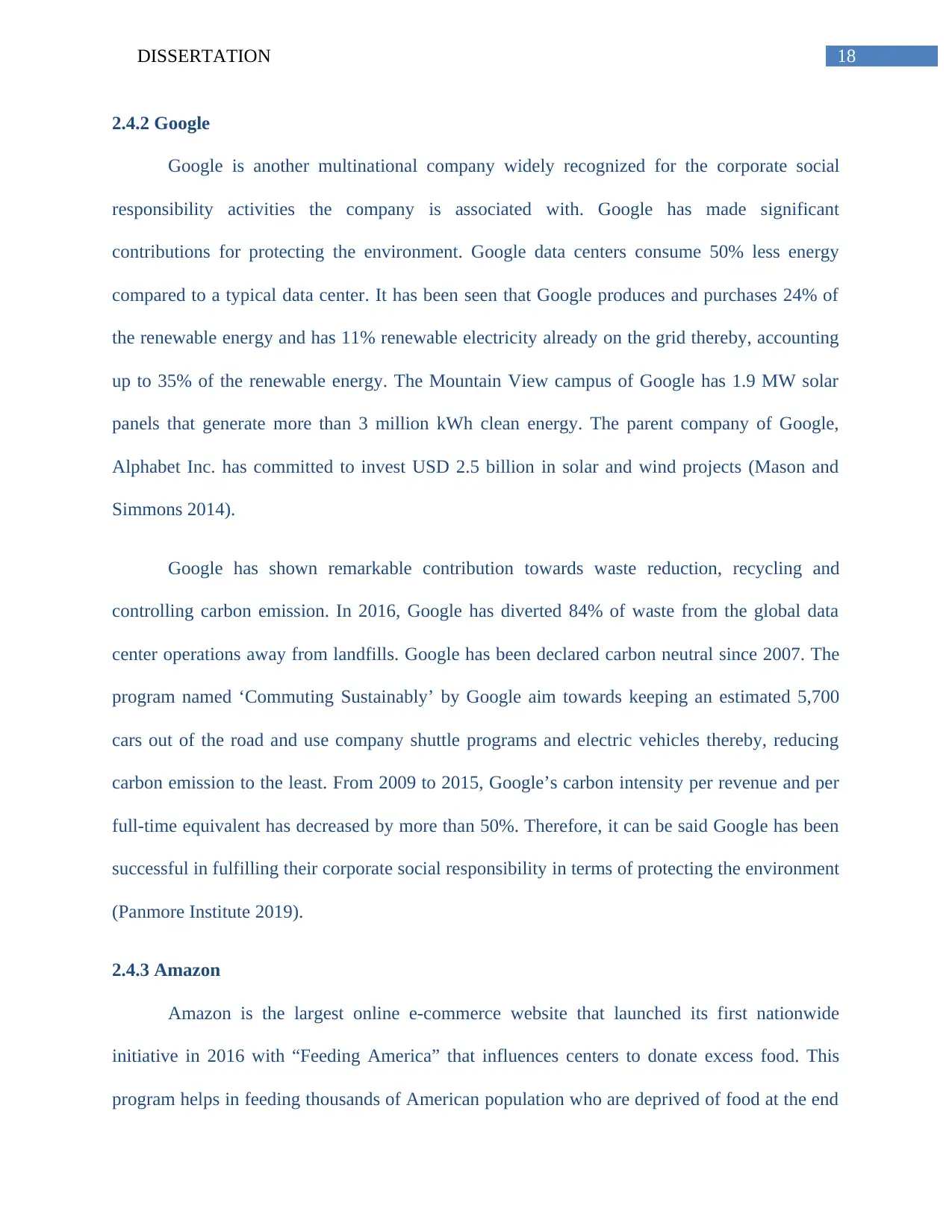
18DISSERTATION
2.4.2 Google
Google is another multinational company widely recognized for the corporate social
responsibility activities the company is associated with. Google has made significant
contributions for protecting the environment. Google data centers consume 50% less energy
compared to a typical data center. It has been seen that Google produces and purchases 24% of
the renewable energy and has 11% renewable electricity already on the grid thereby, accounting
up to 35% of the renewable energy. The Mountain View campus of Google has 1.9 MW solar
panels that generate more than 3 million kWh clean energy. The parent company of Google,
Alphabet Inc. has committed to invest USD 2.5 billion in solar and wind projects (Mason and
Simmons 2014).
Google has shown remarkable contribution towards waste reduction, recycling and
controlling carbon emission. In 2016, Google has diverted 84% of waste from the global data
center operations away from landfills. Google has been declared carbon neutral since 2007. The
program named ‘Commuting Sustainably’ by Google aim towards keeping an estimated 5,700
cars out of the road and use company shuttle programs and electric vehicles thereby, reducing
carbon emission to the least. From 2009 to 2015, Google’s carbon intensity per revenue and per
full-time equivalent has decreased by more than 50%. Therefore, it can be said Google has been
successful in fulfilling their corporate social responsibility in terms of protecting the environment
(Panmore Institute 2019).
2.4.3 Amazon
Amazon is the largest online e-commerce website that launched its first nationwide
initiative in 2016 with “Feeding America” that influences centers to donate excess food. This
program helps in feeding thousands of American population who are deprived of food at the end
2.4.2 Google
Google is another multinational company widely recognized for the corporate social
responsibility activities the company is associated with. Google has made significant
contributions for protecting the environment. Google data centers consume 50% less energy
compared to a typical data center. It has been seen that Google produces and purchases 24% of
the renewable energy and has 11% renewable electricity already on the grid thereby, accounting
up to 35% of the renewable energy. The Mountain View campus of Google has 1.9 MW solar
panels that generate more than 3 million kWh clean energy. The parent company of Google,
Alphabet Inc. has committed to invest USD 2.5 billion in solar and wind projects (Mason and
Simmons 2014).
Google has shown remarkable contribution towards waste reduction, recycling and
controlling carbon emission. In 2016, Google has diverted 84% of waste from the global data
center operations away from landfills. Google has been declared carbon neutral since 2007. The
program named ‘Commuting Sustainably’ by Google aim towards keeping an estimated 5,700
cars out of the road and use company shuttle programs and electric vehicles thereby, reducing
carbon emission to the least. From 2009 to 2015, Google’s carbon intensity per revenue and per
full-time equivalent has decreased by more than 50%. Therefore, it can be said Google has been
successful in fulfilling their corporate social responsibility in terms of protecting the environment
(Panmore Institute 2019).
2.4.3 Amazon
Amazon is the largest online e-commerce website that launched its first nationwide
initiative in 2016 with “Feeding America” that influences centers to donate excess food. This
program helps in feeding thousands of American population who are deprived of food at the end
Paraphrase This Document
Need a fresh take? Get an instant paraphrase of this document with our AI Paraphraser
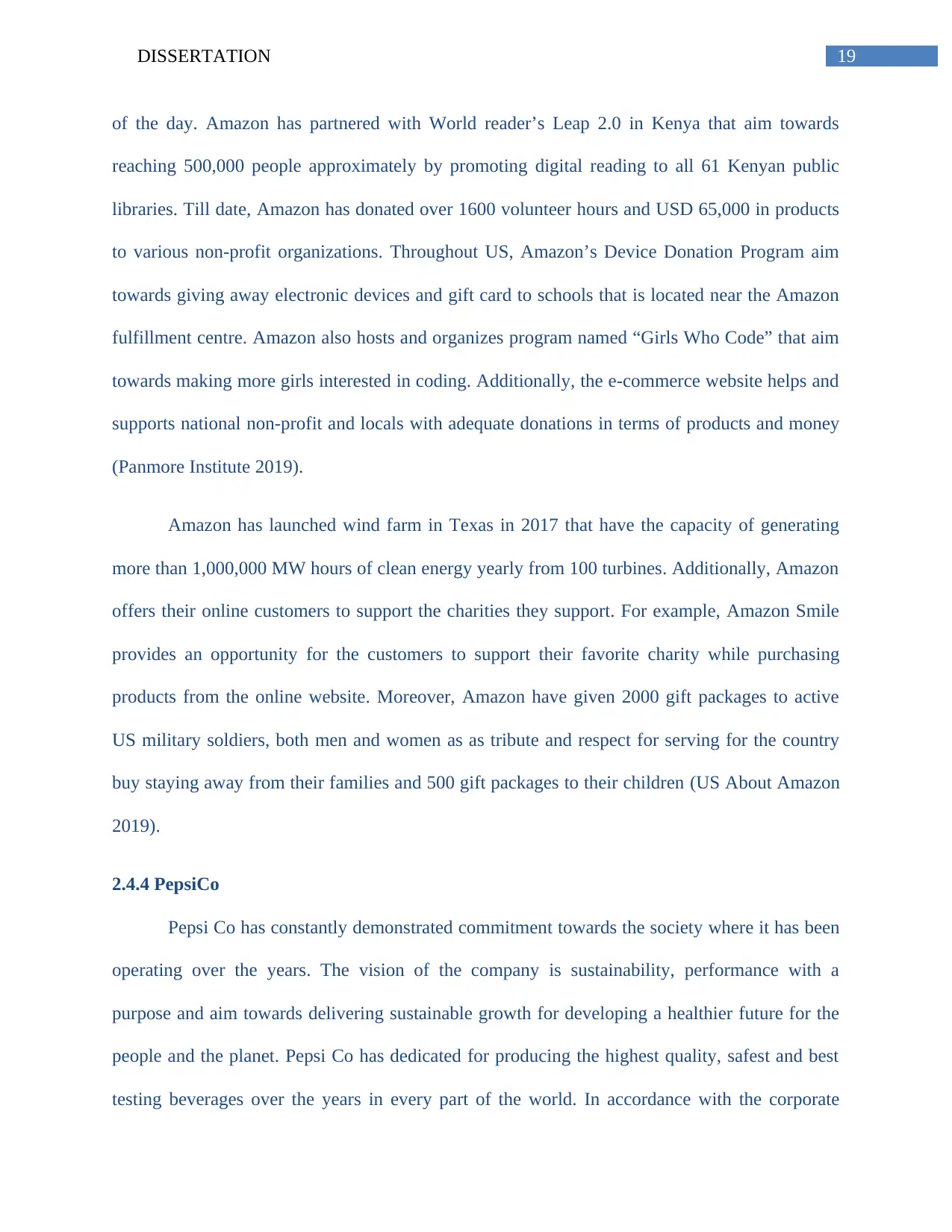
19DISSERTATION
of the day. Amazon has partnered with World reader’s Leap 2.0 in Kenya that aim towards
reaching 500,000 people approximately by promoting digital reading to all 61 Kenyan public
libraries. Till date, Amazon has donated over 1600 volunteer hours and USD 65,000 in products
to various non-profit organizations. Throughout US, Amazon’s Device Donation Program aim
towards giving away electronic devices and gift card to schools that is located near the Amazon
fulfillment centre. Amazon also hosts and organizes program named “Girls Who Code” that aim
towards making more girls interested in coding. Additionally, the e-commerce website helps and
supports national non-profit and locals with adequate donations in terms of products and money
(Panmore Institute 2019).
Amazon has launched wind farm in Texas in 2017 that have the capacity of generating
more than 1,000,000 MW hours of clean energy yearly from 100 turbines. Additionally, Amazon
offers their online customers to support the charities they support. For example, Amazon Smile
provides an opportunity for the customers to support their favorite charity while purchasing
products from the online website. Moreover, Amazon have given 2000 gift packages to active
US military soldiers, both men and women as as tribute and respect for serving for the country
buy staying away from their families and 500 gift packages to their children (US About Amazon
2019).
2.4.4 PepsiCo
Pepsi Co has constantly demonstrated commitment towards the society where it has been
operating over the years. The vision of the company is sustainability, performance with a
purpose and aim towards delivering sustainable growth for developing a healthier future for the
people and the planet. Pepsi Co has dedicated for producing the highest quality, safest and best
testing beverages over the years in every part of the world. In accordance with the corporate
of the day. Amazon has partnered with World reader’s Leap 2.0 in Kenya that aim towards
reaching 500,000 people approximately by promoting digital reading to all 61 Kenyan public
libraries. Till date, Amazon has donated over 1600 volunteer hours and USD 65,000 in products
to various non-profit organizations. Throughout US, Amazon’s Device Donation Program aim
towards giving away electronic devices and gift card to schools that is located near the Amazon
fulfillment centre. Amazon also hosts and organizes program named “Girls Who Code” that aim
towards making more girls interested in coding. Additionally, the e-commerce website helps and
supports national non-profit and locals with adequate donations in terms of products and money
(Panmore Institute 2019).
Amazon has launched wind farm in Texas in 2017 that have the capacity of generating
more than 1,000,000 MW hours of clean energy yearly from 100 turbines. Additionally, Amazon
offers their online customers to support the charities they support. For example, Amazon Smile
provides an opportunity for the customers to support their favorite charity while purchasing
products from the online website. Moreover, Amazon have given 2000 gift packages to active
US military soldiers, both men and women as as tribute and respect for serving for the country
buy staying away from their families and 500 gift packages to their children (US About Amazon
2019).
2.4.4 PepsiCo
Pepsi Co has constantly demonstrated commitment towards the society where it has been
operating over the years. The vision of the company is sustainability, performance with a
purpose and aim towards delivering sustainable growth for developing a healthier future for the
people and the planet. Pepsi Co has dedicated for producing the highest quality, safest and best
testing beverages over the years in every part of the world. In accordance with the corporate

20DISSERTATION
social responsibility of the company, Pepsi Co has developed and maintained robust food safety
programs by assuring safety packaging in the market. Pepsi Co values the health and well-being
of the individuals associated with them, be it associates, partners, employees and customers. As a
result, the company considers it as their responsibility to ensure health and well-being
considering which it offers wide range of health benefits promotes healthy living and provides
required education (Csrworld.net 2019).
Pepsi Co is considered as an environment friendly corporate citizen and has developed
environment friendly policies those are related to Environmental Compliance and Sustainability.
The company has launched the policy of sustainable packaging with the objective of developing
packaging strategies, goals and targets thereby, supporting disposable practices reasonably
(Csrwire.com 2019).
2.4.5 Coca-Cola
Coco-Cola is another leading beverage company in the world that has been operating
globally over the years. As a responsible corporate citizen, Coco-Cola has developed the aim of
giving back an estimated 1% of their annual income for various charitable causes globally. In the
years 2012-2013, Coco-Cola has been listed as the World’s Best Multinational Workplaces
according to a leading magazine. In 2013, 44% of the US workforce in Coco-Cola highlighted
and supported cultural diversity followed by recruiting at least 1010 military veterans. In
addition to, taking into account the health perspectives of the individuals Coco-Cola beverages
are sold to, majority of the drinks introduced had reduced, low or completely calorie free. The
energy efficient of the company has been improved by 20% since 2004. Considering the
significance of conserving energy, the delivery vehicles used Coco-Cola has been turned into
efficient hybrid-electric vehicles (Karnani 2014).
social responsibility of the company, Pepsi Co has developed and maintained robust food safety
programs by assuring safety packaging in the market. Pepsi Co values the health and well-being
of the individuals associated with them, be it associates, partners, employees and customers. As a
result, the company considers it as their responsibility to ensure health and well-being
considering which it offers wide range of health benefits promotes healthy living and provides
required education (Csrworld.net 2019).
Pepsi Co is considered as an environment friendly corporate citizen and has developed
environment friendly policies those are related to Environmental Compliance and Sustainability.
The company has launched the policy of sustainable packaging with the objective of developing
packaging strategies, goals and targets thereby, supporting disposable practices reasonably
(Csrwire.com 2019).
2.4.5 Coca-Cola
Coco-Cola is another leading beverage company in the world that has been operating
globally over the years. As a responsible corporate citizen, Coco-Cola has developed the aim of
giving back an estimated 1% of their annual income for various charitable causes globally. In the
years 2012-2013, Coco-Cola has been listed as the World’s Best Multinational Workplaces
according to a leading magazine. In 2013, 44% of the US workforce in Coco-Cola highlighted
and supported cultural diversity followed by recruiting at least 1010 military veterans. In
addition to, taking into account the health perspectives of the individuals Coco-Cola beverages
are sold to, majority of the drinks introduced had reduced, low or completely calorie free. The
energy efficient of the company has been improved by 20% since 2004. Considering the
significance of conserving energy, the delivery vehicles used Coco-Cola has been turned into
efficient hybrid-electric vehicles (Karnani 2014).
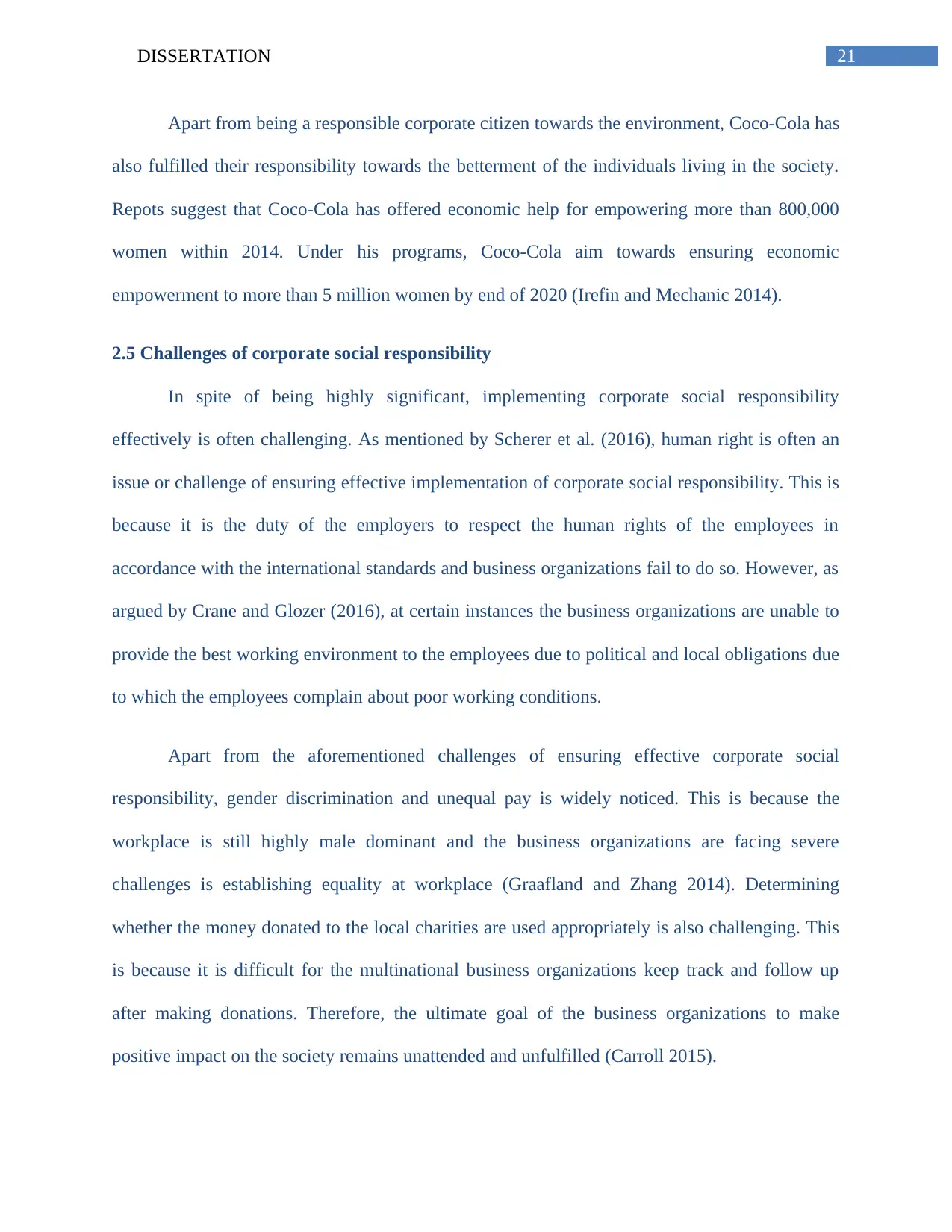
21DISSERTATION
Apart from being a responsible corporate citizen towards the environment, Coco-Cola has
also fulfilled their responsibility towards the betterment of the individuals living in the society.
Repots suggest that Coco-Cola has offered economic help for empowering more than 800,000
women within 2014. Under his programs, Coco-Cola aim towards ensuring economic
empowerment to more than 5 million women by end of 2020 (Irefin and Mechanic 2014).
2.5 Challenges of corporate social responsibility
In spite of being highly significant, implementing corporate social responsibility
effectively is often challenging. As mentioned by Scherer et al. (2016), human right is often an
issue or challenge of ensuring effective implementation of corporate social responsibility. This is
because it is the duty of the employers to respect the human rights of the employees in
accordance with the international standards and business organizations fail to do so. However, as
argued by Crane and Glozer (2016), at certain instances the business organizations are unable to
provide the best working environment to the employees due to political and local obligations due
to which the employees complain about poor working conditions.
Apart from the aforementioned challenges of ensuring effective corporate social
responsibility, gender discrimination and unequal pay is widely noticed. This is because the
workplace is still highly male dominant and the business organizations are facing severe
challenges is establishing equality at workplace (Graafland and Zhang 2014). Determining
whether the money donated to the local charities are used appropriately is also challenging. This
is because it is difficult for the multinational business organizations keep track and follow up
after making donations. Therefore, the ultimate goal of the business organizations to make
positive impact on the society remains unattended and unfulfilled (Carroll 2015).
Apart from being a responsible corporate citizen towards the environment, Coco-Cola has
also fulfilled their responsibility towards the betterment of the individuals living in the society.
Repots suggest that Coco-Cola has offered economic help for empowering more than 800,000
women within 2014. Under his programs, Coco-Cola aim towards ensuring economic
empowerment to more than 5 million women by end of 2020 (Irefin and Mechanic 2014).
2.5 Challenges of corporate social responsibility
In spite of being highly significant, implementing corporate social responsibility
effectively is often challenging. As mentioned by Scherer et al. (2016), human right is often an
issue or challenge of ensuring effective implementation of corporate social responsibility. This is
because it is the duty of the employers to respect the human rights of the employees in
accordance with the international standards and business organizations fail to do so. However, as
argued by Crane and Glozer (2016), at certain instances the business organizations are unable to
provide the best working environment to the employees due to political and local obligations due
to which the employees complain about poor working conditions.
Apart from the aforementioned challenges of ensuring effective corporate social
responsibility, gender discrimination and unequal pay is widely noticed. This is because the
workplace is still highly male dominant and the business organizations are facing severe
challenges is establishing equality at workplace (Graafland and Zhang 2014). Determining
whether the money donated to the local charities are used appropriately is also challenging. This
is because it is difficult for the multinational business organizations keep track and follow up
after making donations. Therefore, the ultimate goal of the business organizations to make
positive impact on the society remains unattended and unfulfilled (Carroll 2015).
Secure Best Marks with AI Grader
Need help grading? Try our AI Grader for instant feedback on your assignments.
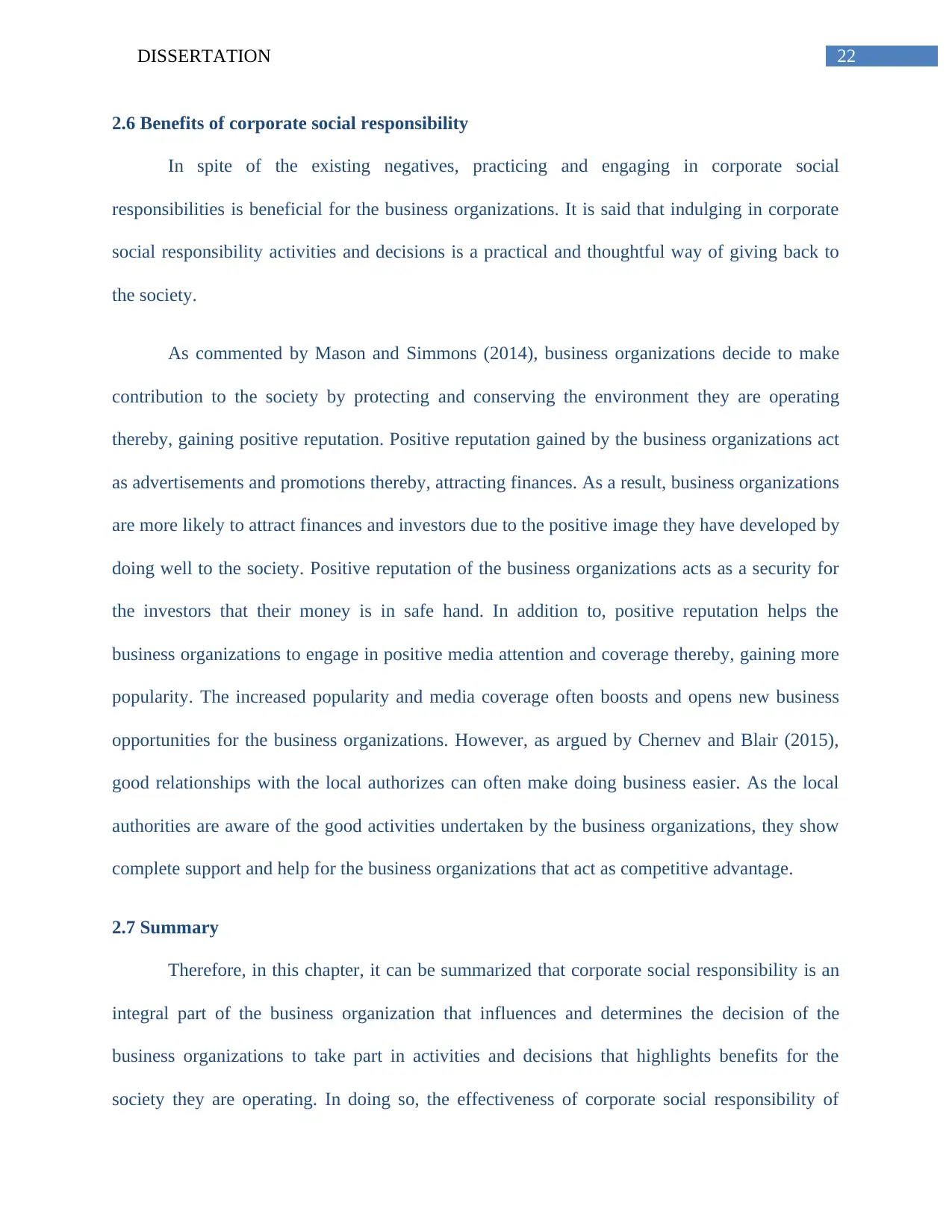
22DISSERTATION
2.6 Benefits of corporate social responsibility
In spite of the existing negatives, practicing and engaging in corporate social
responsibilities is beneficial for the business organizations. It is said that indulging in corporate
social responsibility activities and decisions is a practical and thoughtful way of giving back to
the society.
As commented by Mason and Simmons (2014), business organizations decide to make
contribution to the society by protecting and conserving the environment they are operating
thereby, gaining positive reputation. Positive reputation gained by the business organizations act
as advertisements and promotions thereby, attracting finances. As a result, business organizations
are more likely to attract finances and investors due to the positive image they have developed by
doing well to the society. Positive reputation of the business organizations acts as a security for
the investors that their money is in safe hand. In addition to, positive reputation helps the
business organizations to engage in positive media attention and coverage thereby, gaining more
popularity. The increased popularity and media coverage often boosts and opens new business
opportunities for the business organizations. However, as argued by Chernev and Blair (2015),
good relationships with the local authorizes can often make doing business easier. As the local
authorities are aware of the good activities undertaken by the business organizations, they show
complete support and help for the business organizations that act as competitive advantage.
2.7 Summary
Therefore, in this chapter, it can be summarized that corporate social responsibility is an
integral part of the business organization that influences and determines the decision of the
business organizations to take part in activities and decisions that highlights benefits for the
society they are operating. In doing so, the effectiveness of corporate social responsibility of
2.6 Benefits of corporate social responsibility
In spite of the existing negatives, practicing and engaging in corporate social
responsibilities is beneficial for the business organizations. It is said that indulging in corporate
social responsibility activities and decisions is a practical and thoughtful way of giving back to
the society.
As commented by Mason and Simmons (2014), business organizations decide to make
contribution to the society by protecting and conserving the environment they are operating
thereby, gaining positive reputation. Positive reputation gained by the business organizations act
as advertisements and promotions thereby, attracting finances. As a result, business organizations
are more likely to attract finances and investors due to the positive image they have developed by
doing well to the society. Positive reputation of the business organizations acts as a security for
the investors that their money is in safe hand. In addition to, positive reputation helps the
business organizations to engage in positive media attention and coverage thereby, gaining more
popularity. The increased popularity and media coverage often boosts and opens new business
opportunities for the business organizations. However, as argued by Chernev and Blair (2015),
good relationships with the local authorizes can often make doing business easier. As the local
authorities are aware of the good activities undertaken by the business organizations, they show
complete support and help for the business organizations that act as competitive advantage.
2.7 Summary
Therefore, in this chapter, it can be summarized that corporate social responsibility is an
integral part of the business organization that influences and determines the decision of the
business organizations to take part in activities and decisions that highlights benefits for the
society they are operating. In doing so, the effectiveness of corporate social responsibility of
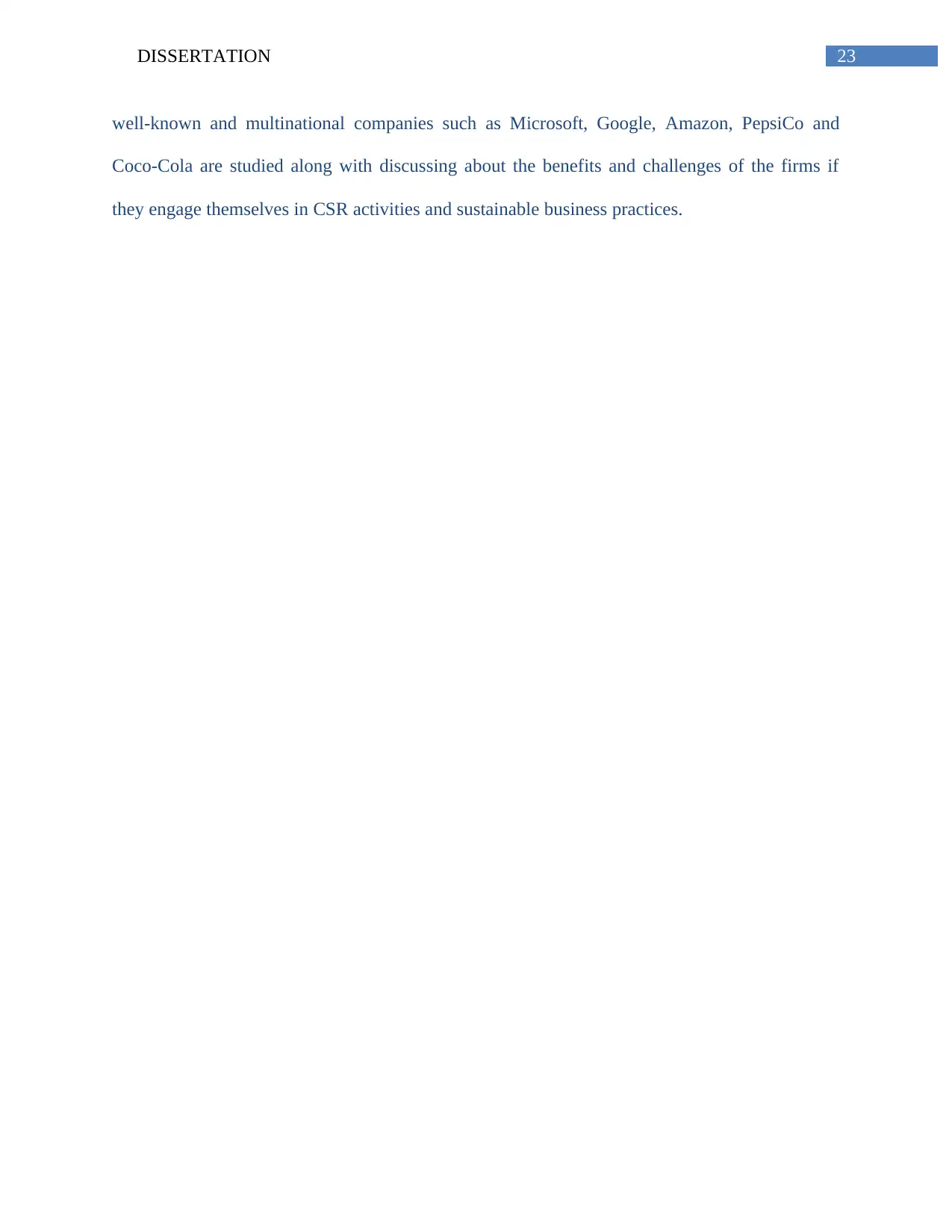
23DISSERTATION
well-known and multinational companies such as Microsoft, Google, Amazon, PepsiCo and
Coco-Cola are studied along with discussing about the benefits and challenges of the firms if
they engage themselves in CSR activities and sustainable business practices.
well-known and multinational companies such as Microsoft, Google, Amazon, PepsiCo and
Coco-Cola are studied along with discussing about the benefits and challenges of the firms if
they engage themselves in CSR activities and sustainable business practices.
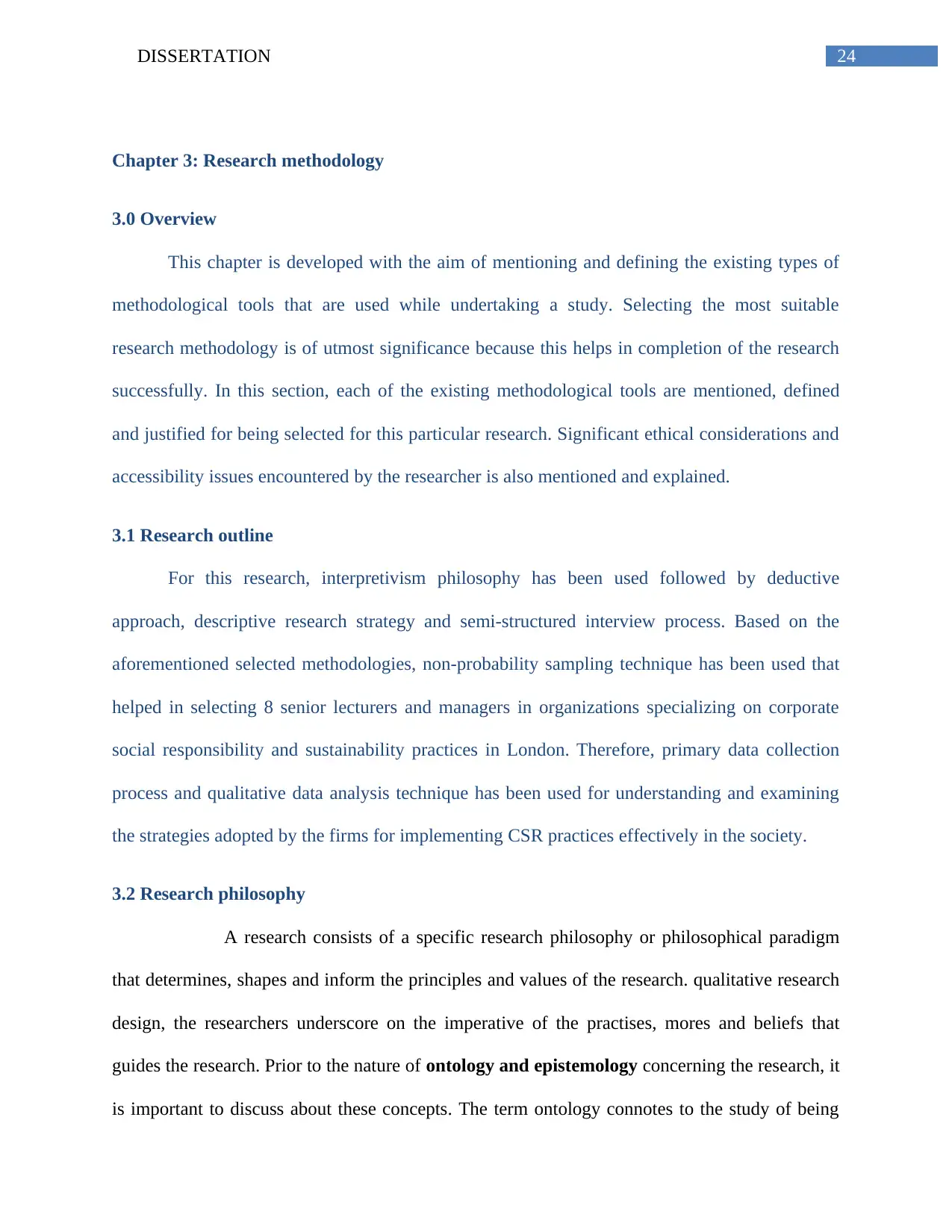
24DISSERTATION
Chapter 3: Research methodology
3.0 Overview
This chapter is developed with the aim of mentioning and defining the existing types of
methodological tools that are used while undertaking a study. Selecting the most suitable
research methodology is of utmost significance because this helps in completion of the research
successfully. In this section, each of the existing methodological tools are mentioned, defined
and justified for being selected for this particular research. Significant ethical considerations and
accessibility issues encountered by the researcher is also mentioned and explained.
3.1 Research outline
For this research, interpretivism philosophy has been used followed by deductive
approach, descriptive research strategy and semi-structured interview process. Based on the
aforementioned selected methodologies, non-probability sampling technique has been used that
helped in selecting 8 senior lecturers and managers in organizations specializing on corporate
social responsibility and sustainability practices in London. Therefore, primary data collection
process and qualitative data analysis technique has been used for understanding and examining
the strategies adopted by the firms for implementing CSR practices effectively in the society.
3.2 Research philosophy
A research consists of a specific research philosophy or philosophical paradigm
that determines, shapes and inform the principles and values of the research. qualitative research
design, the researchers underscore on the imperative of the practises, mores and beliefs that
guides the research. Prior to the nature of ontology and epistemology concerning the research, it
is important to discuss about these concepts. The term ontology connotes to the study of being
Chapter 3: Research methodology
3.0 Overview
This chapter is developed with the aim of mentioning and defining the existing types of
methodological tools that are used while undertaking a study. Selecting the most suitable
research methodology is of utmost significance because this helps in completion of the research
successfully. In this section, each of the existing methodological tools are mentioned, defined
and justified for being selected for this particular research. Significant ethical considerations and
accessibility issues encountered by the researcher is also mentioned and explained.
3.1 Research outline
For this research, interpretivism philosophy has been used followed by deductive
approach, descriptive research strategy and semi-structured interview process. Based on the
aforementioned selected methodologies, non-probability sampling technique has been used that
helped in selecting 8 senior lecturers and managers in organizations specializing on corporate
social responsibility and sustainability practices in London. Therefore, primary data collection
process and qualitative data analysis technique has been used for understanding and examining
the strategies adopted by the firms for implementing CSR practices effectively in the society.
3.2 Research philosophy
A research consists of a specific research philosophy or philosophical paradigm
that determines, shapes and inform the principles and values of the research. qualitative research
design, the researchers underscore on the imperative of the practises, mores and beliefs that
guides the research. Prior to the nature of ontology and epistemology concerning the research, it
is important to discuss about these concepts. The term ontology connotes to the study of being
Paraphrase This Document
Need a fresh take? Get an instant paraphrase of this document with our AI Paraphraser
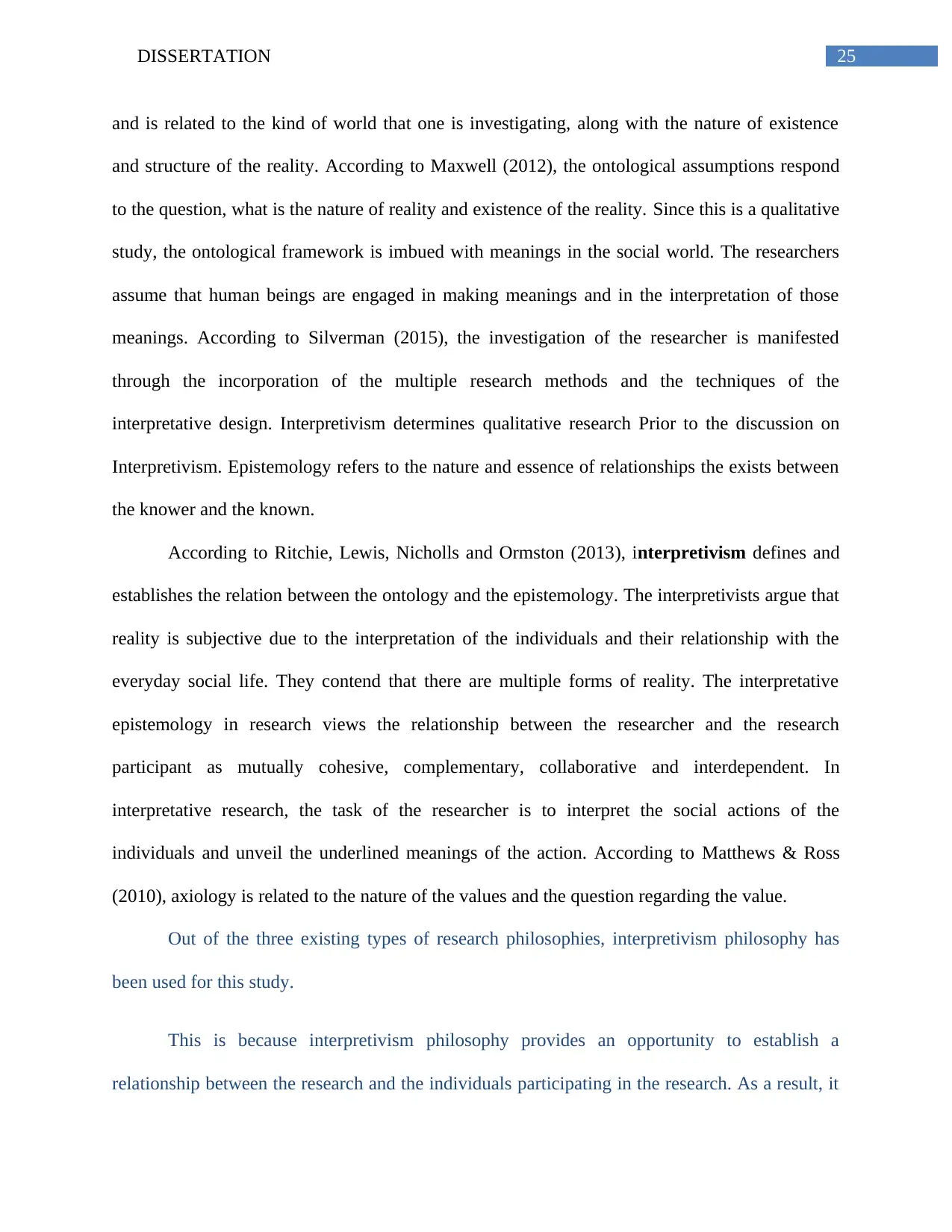
25DISSERTATION
and is related to the kind of world that one is investigating, along with the nature of existence
and structure of the reality. According to Maxwell (2012), the ontological assumptions respond
to the question, what is the nature of reality and existence of the reality. Since this is a qualitative
study, the ontological framework is imbued with meanings in the social world. The researchers
assume that human beings are engaged in making meanings and in the interpretation of those
meanings. According to Silverman (2015), the investigation of the researcher is manifested
through the incorporation of the multiple research methods and the techniques of the
interpretative design. Interpretivism determines qualitative research Prior to the discussion on
Interpretivism. Epistemology refers to the nature and essence of relationships the exists between
the knower and the known.
According to Ritchie, Lewis, Nicholls and Ormston (2013), interpretivism defines and
establishes the relation between the ontology and the epistemology. The interpretivists argue that
reality is subjective due to the interpretation of the individuals and their relationship with the
everyday social life. They contend that there are multiple forms of reality. The interpretative
epistemology in research views the relationship between the researcher and the research
participant as mutually cohesive, complementary, collaborative and interdependent. In
interpretative research, the task of the researcher is to interpret the social actions of the
individuals and unveil the underlined meanings of the action. According to Matthews & Ross
(2010), axiology is related to the nature of the values and the question regarding the value.
Out of the three existing types of research philosophies, interpretivism philosophy has
been used for this study.
This is because interpretivism philosophy provides an opportunity to establish a
relationship between the research and the individuals participating in the research. As a result, it
and is related to the kind of world that one is investigating, along with the nature of existence
and structure of the reality. According to Maxwell (2012), the ontological assumptions respond
to the question, what is the nature of reality and existence of the reality. Since this is a qualitative
study, the ontological framework is imbued with meanings in the social world. The researchers
assume that human beings are engaged in making meanings and in the interpretation of those
meanings. According to Silverman (2015), the investigation of the researcher is manifested
through the incorporation of the multiple research methods and the techniques of the
interpretative design. Interpretivism determines qualitative research Prior to the discussion on
Interpretivism. Epistemology refers to the nature and essence of relationships the exists between
the knower and the known.
According to Ritchie, Lewis, Nicholls and Ormston (2013), interpretivism defines and
establishes the relation between the ontology and the epistemology. The interpretivists argue that
reality is subjective due to the interpretation of the individuals and their relationship with the
everyday social life. They contend that there are multiple forms of reality. The interpretative
epistemology in research views the relationship between the researcher and the research
participant as mutually cohesive, complementary, collaborative and interdependent. In
interpretative research, the task of the researcher is to interpret the social actions of the
individuals and unveil the underlined meanings of the action. According to Matthews & Ross
(2010), axiology is related to the nature of the values and the question regarding the value.
Out of the three existing types of research philosophies, interpretivism philosophy has
been used for this study.
This is because interpretivism philosophy provides an opportunity to establish a
relationship between the research and the individuals participating in the research. As a result, it
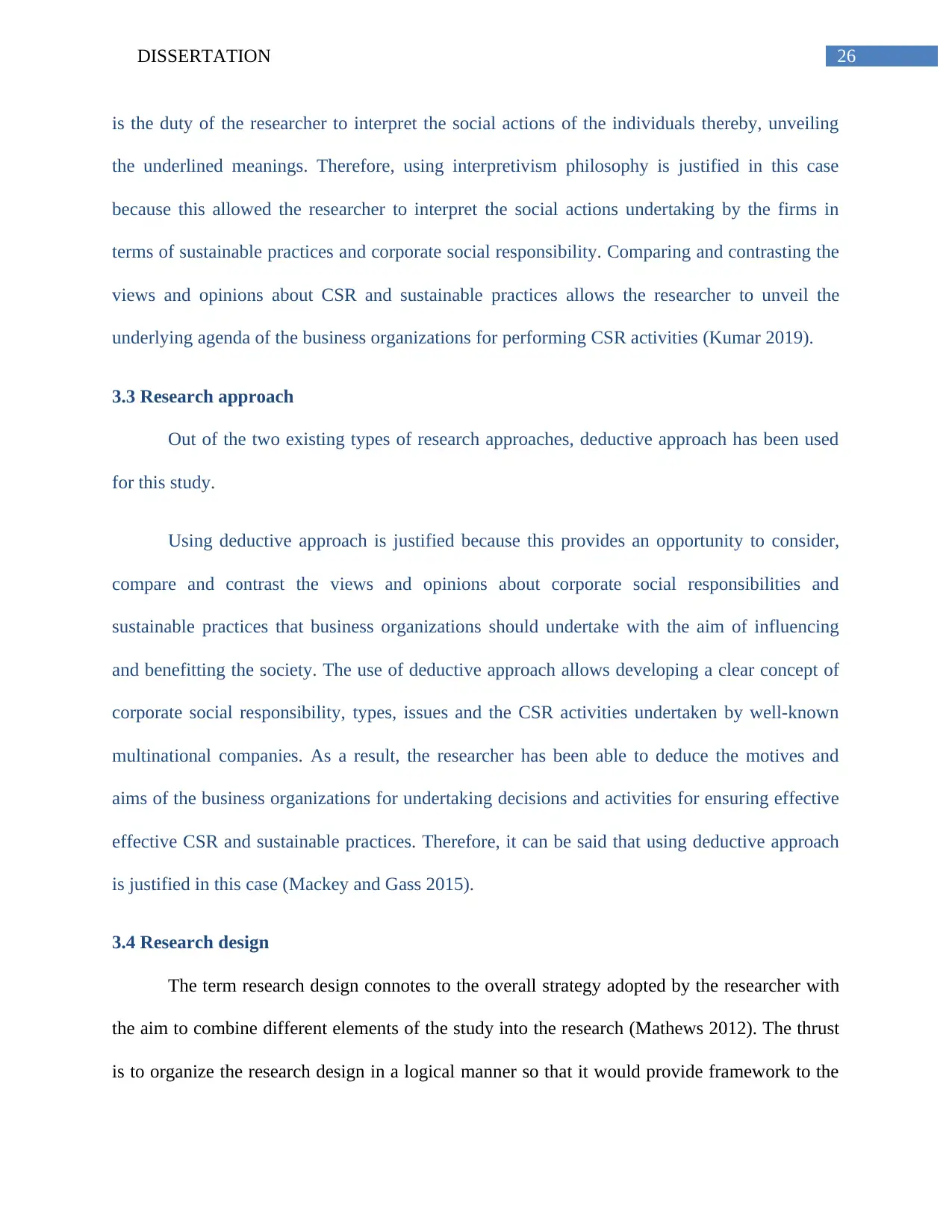
26DISSERTATION
is the duty of the researcher to interpret the social actions of the individuals thereby, unveiling
the underlined meanings. Therefore, using interpretivism philosophy is justified in this case
because this allowed the researcher to interpret the social actions undertaking by the firms in
terms of sustainable practices and corporate social responsibility. Comparing and contrasting the
views and opinions about CSR and sustainable practices allows the researcher to unveil the
underlying agenda of the business organizations for performing CSR activities (Kumar 2019).
3.3 Research approach
Out of the two existing types of research approaches, deductive approach has been used
for this study.
Using deductive approach is justified because this provides an opportunity to consider,
compare and contrast the views and opinions about corporate social responsibilities and
sustainable practices that business organizations should undertake with the aim of influencing
and benefitting the society. The use of deductive approach allows developing a clear concept of
corporate social responsibility, types, issues and the CSR activities undertaken by well-known
multinational companies. As a result, the researcher has been able to deduce the motives and
aims of the business organizations for undertaking decisions and activities for ensuring effective
effective CSR and sustainable practices. Therefore, it can be said that using deductive approach
is justified in this case (Mackey and Gass 2015).
3.4 Research design
The term research design connotes to the overall strategy adopted by the researcher with
the aim to combine different elements of the study into the research (Mathews 2012). The thrust
is to organize the research design in a logical manner so that it would provide framework to the
is the duty of the researcher to interpret the social actions of the individuals thereby, unveiling
the underlined meanings. Therefore, using interpretivism philosophy is justified in this case
because this allowed the researcher to interpret the social actions undertaking by the firms in
terms of sustainable practices and corporate social responsibility. Comparing and contrasting the
views and opinions about CSR and sustainable practices allows the researcher to unveil the
underlying agenda of the business organizations for performing CSR activities (Kumar 2019).
3.3 Research approach
Out of the two existing types of research approaches, deductive approach has been used
for this study.
Using deductive approach is justified because this provides an opportunity to consider,
compare and contrast the views and opinions about corporate social responsibilities and
sustainable practices that business organizations should undertake with the aim of influencing
and benefitting the society. The use of deductive approach allows developing a clear concept of
corporate social responsibility, types, issues and the CSR activities undertaken by well-known
multinational companies. As a result, the researcher has been able to deduce the motives and
aims of the business organizations for undertaking decisions and activities for ensuring effective
effective CSR and sustainable practices. Therefore, it can be said that using deductive approach
is justified in this case (Mackey and Gass 2015).
3.4 Research design
The term research design connotes to the overall strategy adopted by the researcher with
the aim to combine different elements of the study into the research (Mathews 2012). The thrust
is to organize the research design in a logical manner so that it would provide framework to the
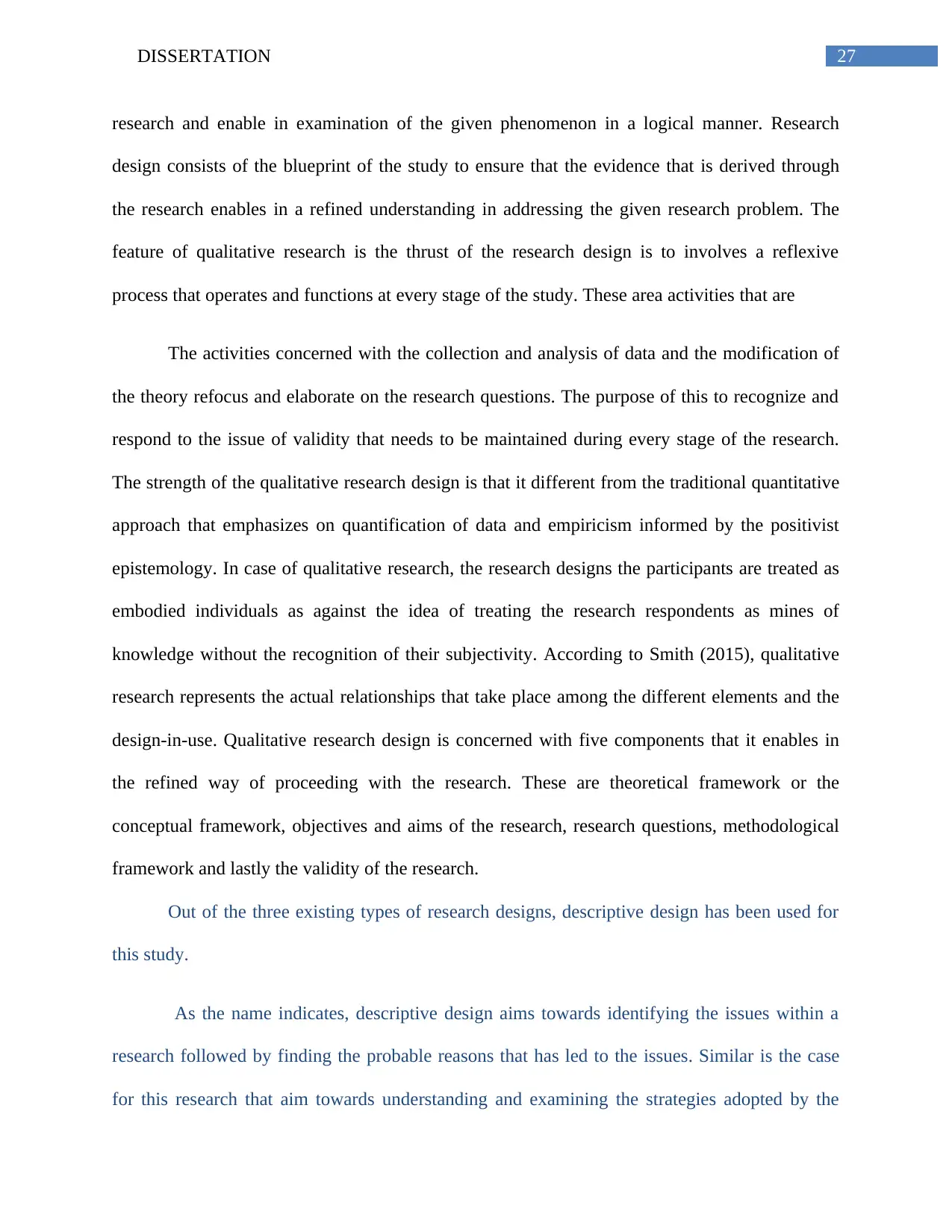
27DISSERTATION
research and enable in examination of the given phenomenon in a logical manner. Research
design consists of the blueprint of the study to ensure that the evidence that is derived through
the research enables in a refined understanding in addressing the given research problem. The
feature of qualitative research is the thrust of the research design is to involves a reflexive
process that operates and functions at every stage of the study. These area activities that are
The activities concerned with the collection and analysis of data and the modification of
the theory refocus and elaborate on the research questions. The purpose of this to recognize and
respond to the issue of validity that needs to be maintained during every stage of the research.
The strength of the qualitative research design is that it different from the traditional quantitative
approach that emphasizes on quantification of data and empiricism informed by the positivist
epistemology. In case of qualitative research, the research designs the participants are treated as
embodied individuals as against the idea of treating the research respondents as mines of
knowledge without the recognition of their subjectivity. According to Smith (2015), qualitative
research represents the actual relationships that take place among the different elements and the
design-in-use. Qualitative research design is concerned with five components that it enables in
the refined way of proceeding with the research. These are theoretical framework or the
conceptual framework, objectives and aims of the research, research questions, methodological
framework and lastly the validity of the research.
Out of the three existing types of research designs, descriptive design has been used for
this study.
As the name indicates, descriptive design aims towards identifying the issues within a
research followed by finding the probable reasons that has led to the issues. Similar is the case
for this research that aim towards understanding and examining the strategies adopted by the
research and enable in examination of the given phenomenon in a logical manner. Research
design consists of the blueprint of the study to ensure that the evidence that is derived through
the research enables in a refined understanding in addressing the given research problem. The
feature of qualitative research is the thrust of the research design is to involves a reflexive
process that operates and functions at every stage of the study. These area activities that are
The activities concerned with the collection and analysis of data and the modification of
the theory refocus and elaborate on the research questions. The purpose of this to recognize and
respond to the issue of validity that needs to be maintained during every stage of the research.
The strength of the qualitative research design is that it different from the traditional quantitative
approach that emphasizes on quantification of data and empiricism informed by the positivist
epistemology. In case of qualitative research, the research designs the participants are treated as
embodied individuals as against the idea of treating the research respondents as mines of
knowledge without the recognition of their subjectivity. According to Smith (2015), qualitative
research represents the actual relationships that take place among the different elements and the
design-in-use. Qualitative research design is concerned with five components that it enables in
the refined way of proceeding with the research. These are theoretical framework or the
conceptual framework, objectives and aims of the research, research questions, methodological
framework and lastly the validity of the research.
Out of the three existing types of research designs, descriptive design has been used for
this study.
As the name indicates, descriptive design aims towards identifying the issues within a
research followed by finding the probable reasons that has led to the issues. Similar is the case
for this research that aim towards understanding and examining the strategies adopted by the
Secure Best Marks with AI Grader
Need help grading? Try our AI Grader for instant feedback on your assignments.
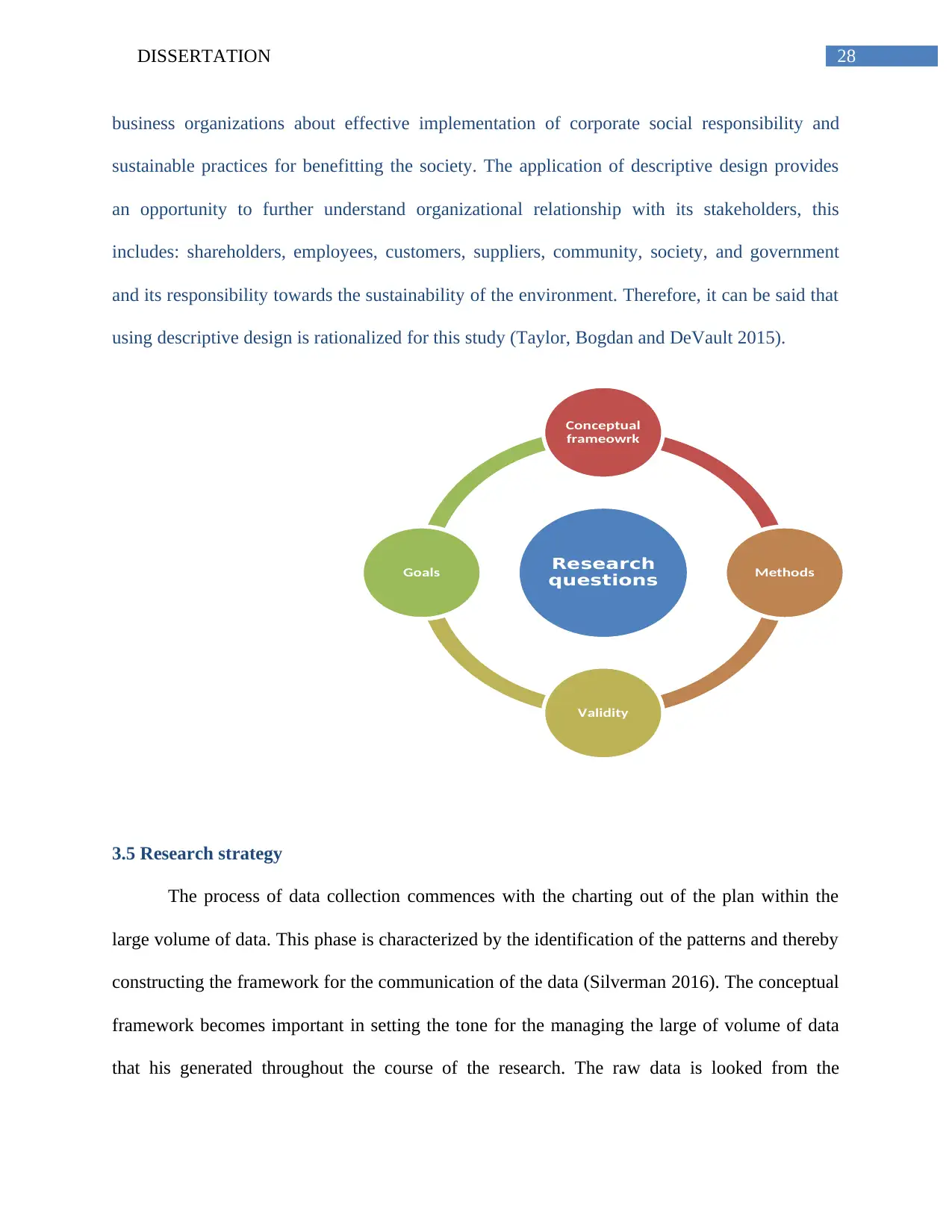
28DISSERTATION
business organizations about effective implementation of corporate social responsibility and
sustainable practices for benefitting the society. The application of descriptive design provides
an opportunity to further understand organizational relationship with its stakeholders, this
includes: shareholders, employees, customers, suppliers, community, society, and government
and its responsibility towards the sustainability of the environment. Therefore, it can be said that
using descriptive design is rationalized for this study (Taylor, Bogdan and DeVault 2015).
3.5 Research strategy
The process of data collection commences with the charting out of the plan within the
large volume of data. This phase is characterized by the identification of the patterns and thereby
constructing the framework for the communication of the data (Silverman 2016). The conceptual
framework becomes important in setting the tone for the managing the large of volume of data
that his generated throughout the course of the research. The raw data is looked from the
Research
questions
Conceptual
frameowrk
Methods
Validity
Goals
business organizations about effective implementation of corporate social responsibility and
sustainable practices for benefitting the society. The application of descriptive design provides
an opportunity to further understand organizational relationship with its stakeholders, this
includes: shareholders, employees, customers, suppliers, community, society, and government
and its responsibility towards the sustainability of the environment. Therefore, it can be said that
using descriptive design is rationalized for this study (Taylor, Bogdan and DeVault 2015).
3.5 Research strategy
The process of data collection commences with the charting out of the plan within the
large volume of data. This phase is characterized by the identification of the patterns and thereby
constructing the framework for the communication of the data (Silverman 2016). The conceptual
framework becomes important in setting the tone for the managing the large of volume of data
that his generated throughout the course of the research. The raw data is looked from the
Research
questions
Conceptual
frameowrk
Methods
Validity
Goals
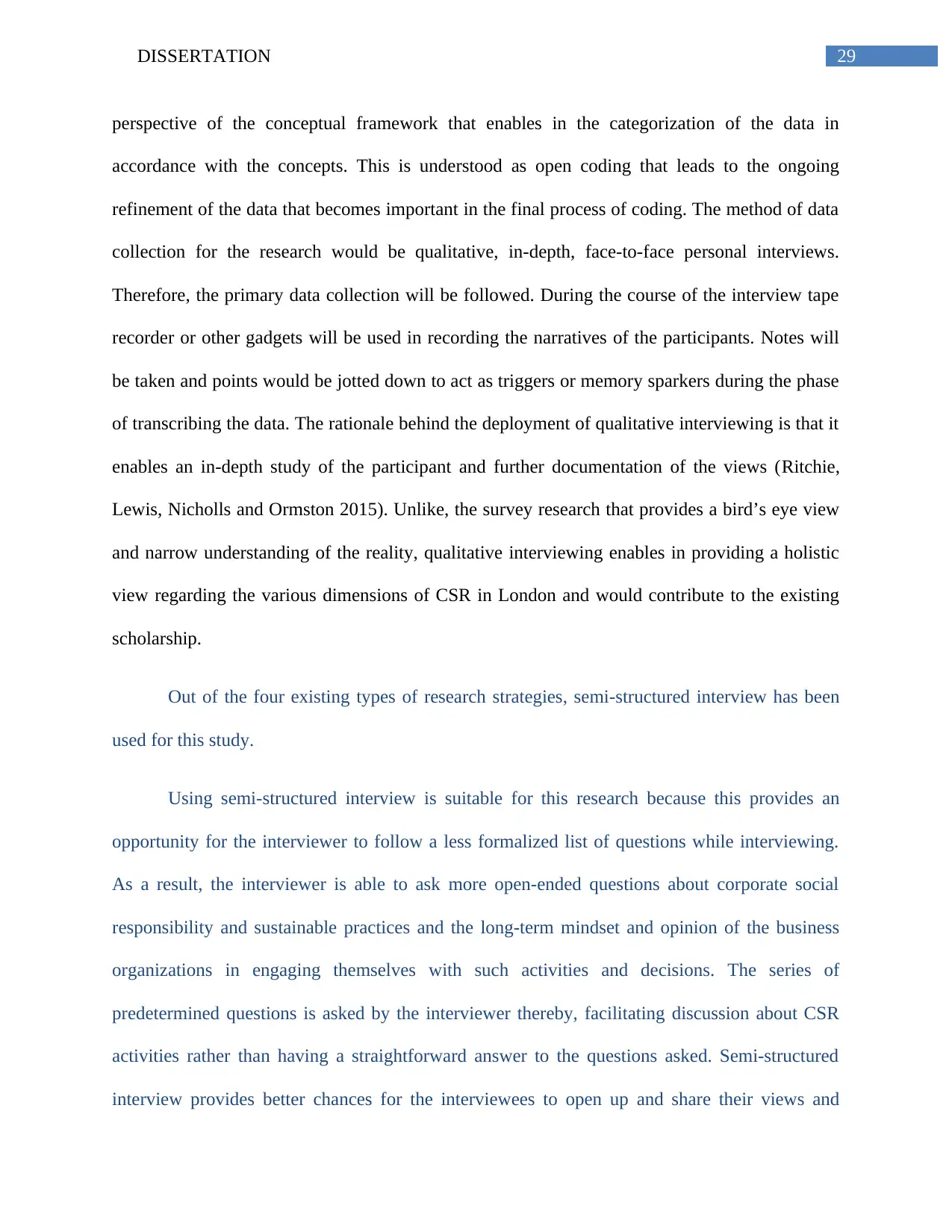
29DISSERTATION
perspective of the conceptual framework that enables in the categorization of the data in
accordance with the concepts. This is understood as open coding that leads to the ongoing
refinement of the data that becomes important in the final process of coding. The method of data
collection for the research would be qualitative, in-depth, face-to-face personal interviews.
Therefore, the primary data collection will be followed. During the course of the interview tape
recorder or other gadgets will be used in recording the narratives of the participants. Notes will
be taken and points would be jotted down to act as triggers or memory sparkers during the phase
of transcribing the data. The rationale behind the deployment of qualitative interviewing is that it
enables an in-depth study of the participant and further documentation of the views (Ritchie,
Lewis, Nicholls and Ormston 2015). Unlike, the survey research that provides a bird’s eye view
and narrow understanding of the reality, qualitative interviewing enables in providing a holistic
view regarding the various dimensions of CSR in London and would contribute to the existing
scholarship.
Out of the four existing types of research strategies, semi-structured interview has been
used for this study.
Using semi-structured interview is suitable for this research because this provides an
opportunity for the interviewer to follow a less formalized list of questions while interviewing.
As a result, the interviewer is able to ask more open-ended questions about corporate social
responsibility and sustainable practices and the long-term mindset and opinion of the business
organizations in engaging themselves with such activities and decisions. The series of
predetermined questions is asked by the interviewer thereby, facilitating discussion about CSR
activities rather than having a straightforward answer to the questions asked. Semi-structured
interview provides better chances for the interviewees to open up and share their views and
perspective of the conceptual framework that enables in the categorization of the data in
accordance with the concepts. This is understood as open coding that leads to the ongoing
refinement of the data that becomes important in the final process of coding. The method of data
collection for the research would be qualitative, in-depth, face-to-face personal interviews.
Therefore, the primary data collection will be followed. During the course of the interview tape
recorder or other gadgets will be used in recording the narratives of the participants. Notes will
be taken and points would be jotted down to act as triggers or memory sparkers during the phase
of transcribing the data. The rationale behind the deployment of qualitative interviewing is that it
enables an in-depth study of the participant and further documentation of the views (Ritchie,
Lewis, Nicholls and Ormston 2015). Unlike, the survey research that provides a bird’s eye view
and narrow understanding of the reality, qualitative interviewing enables in providing a holistic
view regarding the various dimensions of CSR in London and would contribute to the existing
scholarship.
Out of the four existing types of research strategies, semi-structured interview has been
used for this study.
Using semi-structured interview is suitable for this research because this provides an
opportunity for the interviewer to follow a less formalized list of questions while interviewing.
As a result, the interviewer is able to ask more open-ended questions about corporate social
responsibility and sustainable practices and the long-term mindset and opinion of the business
organizations in engaging themselves with such activities and decisions. The series of
predetermined questions is asked by the interviewer thereby, facilitating discussion about CSR
activities rather than having a straightforward answer to the questions asked. Semi-structured
interview provides better chances for the interviewees to open up and share their views and
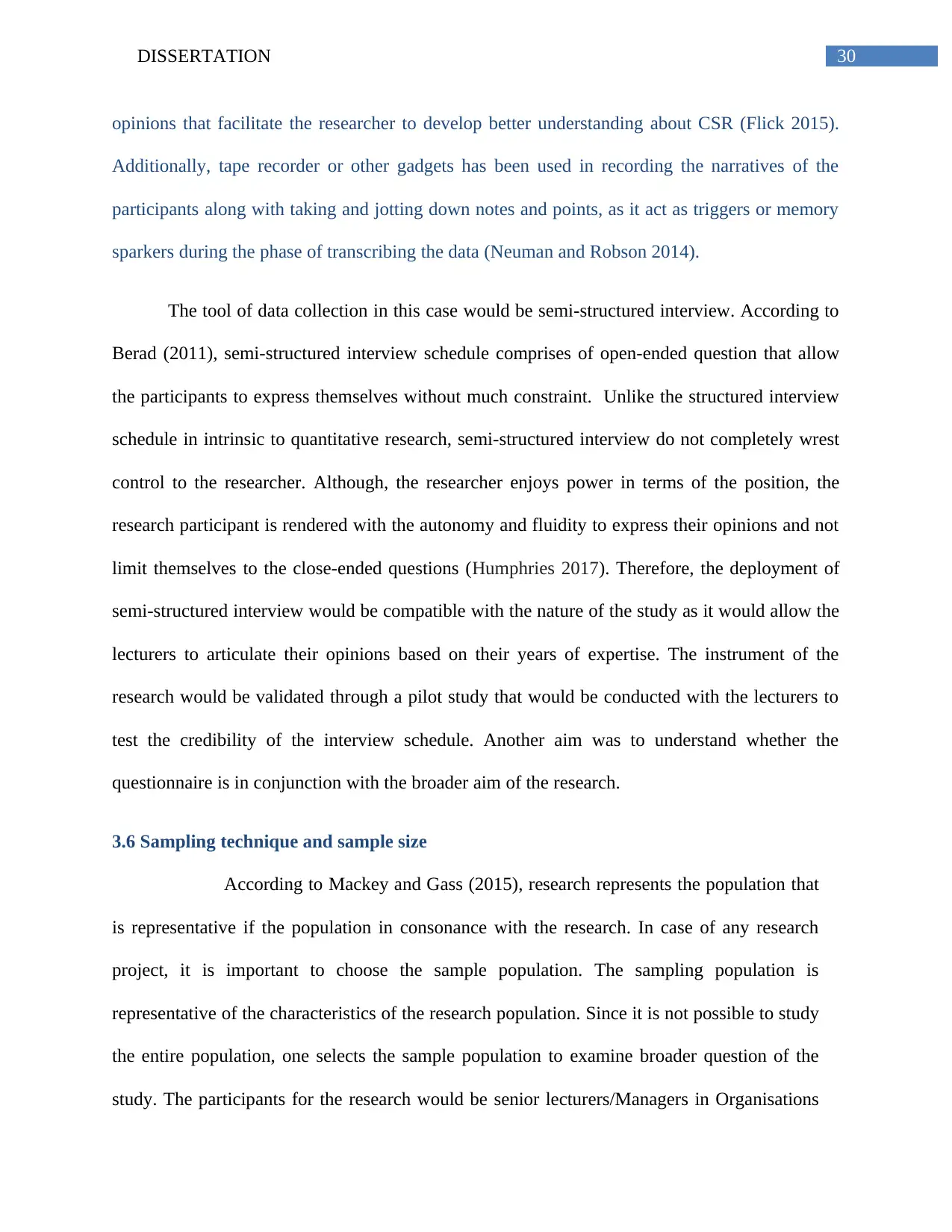
30DISSERTATION
opinions that facilitate the researcher to develop better understanding about CSR (Flick 2015).
Additionally, tape recorder or other gadgets has been used in recording the narratives of the
participants along with taking and jotting down notes and points, as it act as triggers or memory
sparkers during the phase of transcribing the data (Neuman and Robson 2014).
The tool of data collection in this case would be semi-structured interview. According to
Berad (2011), semi-structured interview schedule comprises of open-ended question that allow
the participants to express themselves without much constraint. Unlike the structured interview
schedule in intrinsic to quantitative research, semi-structured interview do not completely wrest
control to the researcher. Although, the researcher enjoys power in terms of the position, the
research participant is rendered with the autonomy and fluidity to express their opinions and not
limit themselves to the close-ended questions (Humphries 2017). Therefore, the deployment of
semi-structured interview would be compatible with the nature of the study as it would allow the
lecturers to articulate their opinions based on their years of expertise. The instrument of the
research would be validated through a pilot study that would be conducted with the lecturers to
test the credibility of the interview schedule. Another aim was to understand whether the
questionnaire is in conjunction with the broader aim of the research.
3.6 Sampling technique and sample size
According to Mackey and Gass (2015), research represents the population that
is representative if the population in consonance with the research. In case of any research
project, it is important to choose the sample population. The sampling population is
representative of the characteristics of the research population. Since it is not possible to study
the entire population, one selects the sample population to examine broader question of the
study. The participants for the research would be senior lecturers/Managers in Organisations
opinions that facilitate the researcher to develop better understanding about CSR (Flick 2015).
Additionally, tape recorder or other gadgets has been used in recording the narratives of the
participants along with taking and jotting down notes and points, as it act as triggers or memory
sparkers during the phase of transcribing the data (Neuman and Robson 2014).
The tool of data collection in this case would be semi-structured interview. According to
Berad (2011), semi-structured interview schedule comprises of open-ended question that allow
the participants to express themselves without much constraint. Unlike the structured interview
schedule in intrinsic to quantitative research, semi-structured interview do not completely wrest
control to the researcher. Although, the researcher enjoys power in terms of the position, the
research participant is rendered with the autonomy and fluidity to express their opinions and not
limit themselves to the close-ended questions (Humphries 2017). Therefore, the deployment of
semi-structured interview would be compatible with the nature of the study as it would allow the
lecturers to articulate their opinions based on their years of expertise. The instrument of the
research would be validated through a pilot study that would be conducted with the lecturers to
test the credibility of the interview schedule. Another aim was to understand whether the
questionnaire is in conjunction with the broader aim of the research.
3.6 Sampling technique and sample size
According to Mackey and Gass (2015), research represents the population that
is representative if the population in consonance with the research. In case of any research
project, it is important to choose the sample population. The sampling population is
representative of the characteristics of the research population. Since it is not possible to study
the entire population, one selects the sample population to examine broader question of the
study. The participants for the research would be senior lecturers/Managers in Organisations
Paraphrase This Document
Need a fresh take? Get an instant paraphrase of this document with our AI Paraphraser
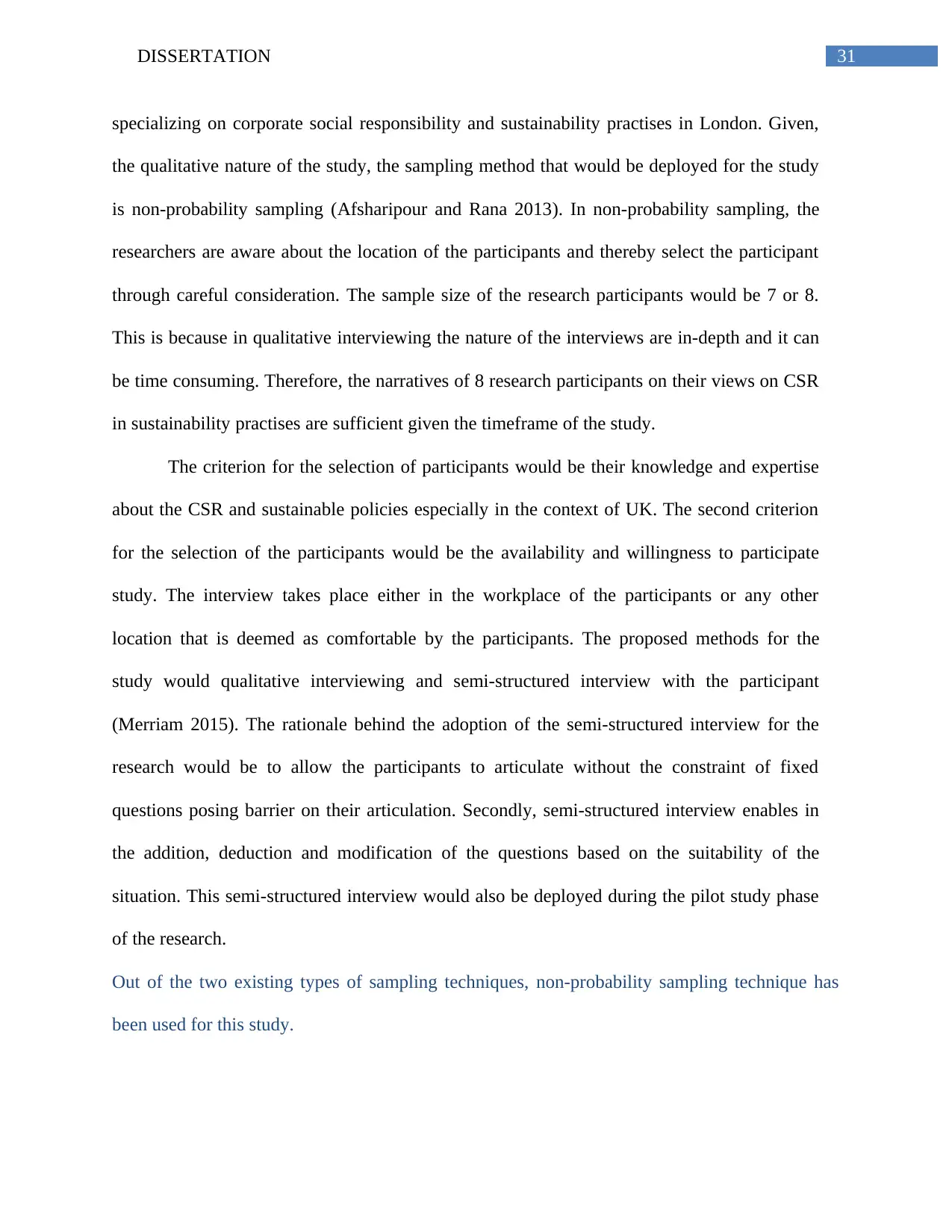
31DISSERTATION
specializing on corporate social responsibility and sustainability practises in London. Given,
the qualitative nature of the study, the sampling method that would be deployed for the study
is non-probability sampling (Afsharipour and Rana 2013). In non-probability sampling, the
researchers are aware about the location of the participants and thereby select the participant
through careful consideration. The sample size of the research participants would be 7 or 8.
This is because in qualitative interviewing the nature of the interviews are in-depth and it can
be time consuming. Therefore, the narratives of 8 research participants on their views on CSR
in sustainability practises are sufficient given the timeframe of the study.
The criterion for the selection of participants would be their knowledge and expertise
about the CSR and sustainable policies especially in the context of UK. The second criterion
for the selection of the participants would be the availability and willingness to participate
study. The interview takes place either in the workplace of the participants or any other
location that is deemed as comfortable by the participants. The proposed methods for the
study would qualitative interviewing and semi-structured interview with the participant
(Merriam 2015). The rationale behind the adoption of the semi-structured interview for the
research would be to allow the participants to articulate without the constraint of fixed
questions posing barrier on their articulation. Secondly, semi-structured interview enables in
the addition, deduction and modification of the questions based on the suitability of the
situation. This semi-structured interview would also be deployed during the pilot study phase
of the research.
Out of the two existing types of sampling techniques, non-probability sampling technique has
been used for this study.
specializing on corporate social responsibility and sustainability practises in London. Given,
the qualitative nature of the study, the sampling method that would be deployed for the study
is non-probability sampling (Afsharipour and Rana 2013). In non-probability sampling, the
researchers are aware about the location of the participants and thereby select the participant
through careful consideration. The sample size of the research participants would be 7 or 8.
This is because in qualitative interviewing the nature of the interviews are in-depth and it can
be time consuming. Therefore, the narratives of 8 research participants on their views on CSR
in sustainability practises are sufficient given the timeframe of the study.
The criterion for the selection of participants would be their knowledge and expertise
about the CSR and sustainable policies especially in the context of UK. The second criterion
for the selection of the participants would be the availability and willingness to participate
study. The interview takes place either in the workplace of the participants or any other
location that is deemed as comfortable by the participants. The proposed methods for the
study would qualitative interviewing and semi-structured interview with the participant
(Merriam 2015). The rationale behind the adoption of the semi-structured interview for the
research would be to allow the participants to articulate without the constraint of fixed
questions posing barrier on their articulation. Secondly, semi-structured interview enables in
the addition, deduction and modification of the questions based on the suitability of the
situation. This semi-structured interview would also be deployed during the pilot study phase
of the research.
Out of the two existing types of sampling techniques, non-probability sampling technique has
been used for this study.
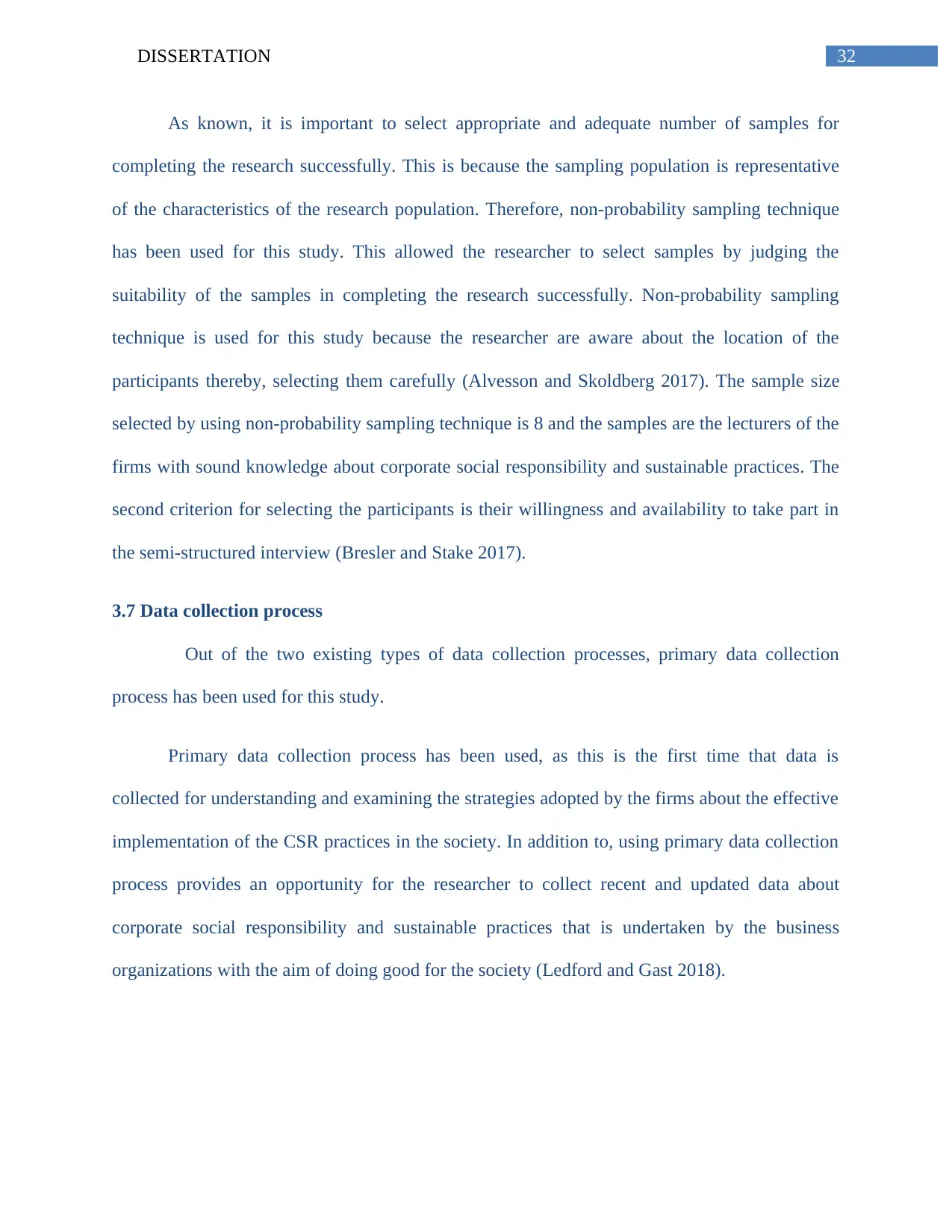
32DISSERTATION
As known, it is important to select appropriate and adequate number of samples for
completing the research successfully. This is because the sampling population is representative
of the characteristics of the research population. Therefore, non-probability sampling technique
has been used for this study. This allowed the researcher to select samples by judging the
suitability of the samples in completing the research successfully. Non-probability sampling
technique is used for this study because the researcher are aware about the location of the
participants thereby, selecting them carefully (Alvesson and Skoldberg 2017). The sample size
selected by using non-probability sampling technique is 8 and the samples are the lecturers of the
firms with sound knowledge about corporate social responsibility and sustainable practices. The
second criterion for selecting the participants is their willingness and availability to take part in
the semi-structured interview (Bresler and Stake 2017).
3.7 Data collection process
Out of the two existing types of data collection processes, primary data collection
process has been used for this study.
Primary data collection process has been used, as this is the first time that data is
collected for understanding and examining the strategies adopted by the firms about the effective
implementation of the CSR practices in the society. In addition to, using primary data collection
process provides an opportunity for the researcher to collect recent and updated data about
corporate social responsibility and sustainable practices that is undertaken by the business
organizations with the aim of doing good for the society (Ledford and Gast 2018).
As known, it is important to select appropriate and adequate number of samples for
completing the research successfully. This is because the sampling population is representative
of the characteristics of the research population. Therefore, non-probability sampling technique
has been used for this study. This allowed the researcher to select samples by judging the
suitability of the samples in completing the research successfully. Non-probability sampling
technique is used for this study because the researcher are aware about the location of the
participants thereby, selecting them carefully (Alvesson and Skoldberg 2017). The sample size
selected by using non-probability sampling technique is 8 and the samples are the lecturers of the
firms with sound knowledge about corporate social responsibility and sustainable practices. The
second criterion for selecting the participants is their willingness and availability to take part in
the semi-structured interview (Bresler and Stake 2017).
3.7 Data collection process
Out of the two existing types of data collection processes, primary data collection
process has been used for this study.
Primary data collection process has been used, as this is the first time that data is
collected for understanding and examining the strategies adopted by the firms about the effective
implementation of the CSR practices in the society. In addition to, using primary data collection
process provides an opportunity for the researcher to collect recent and updated data about
corporate social responsibility and sustainable practices that is undertaken by the business
organizations with the aim of doing good for the society (Ledford and Gast 2018).
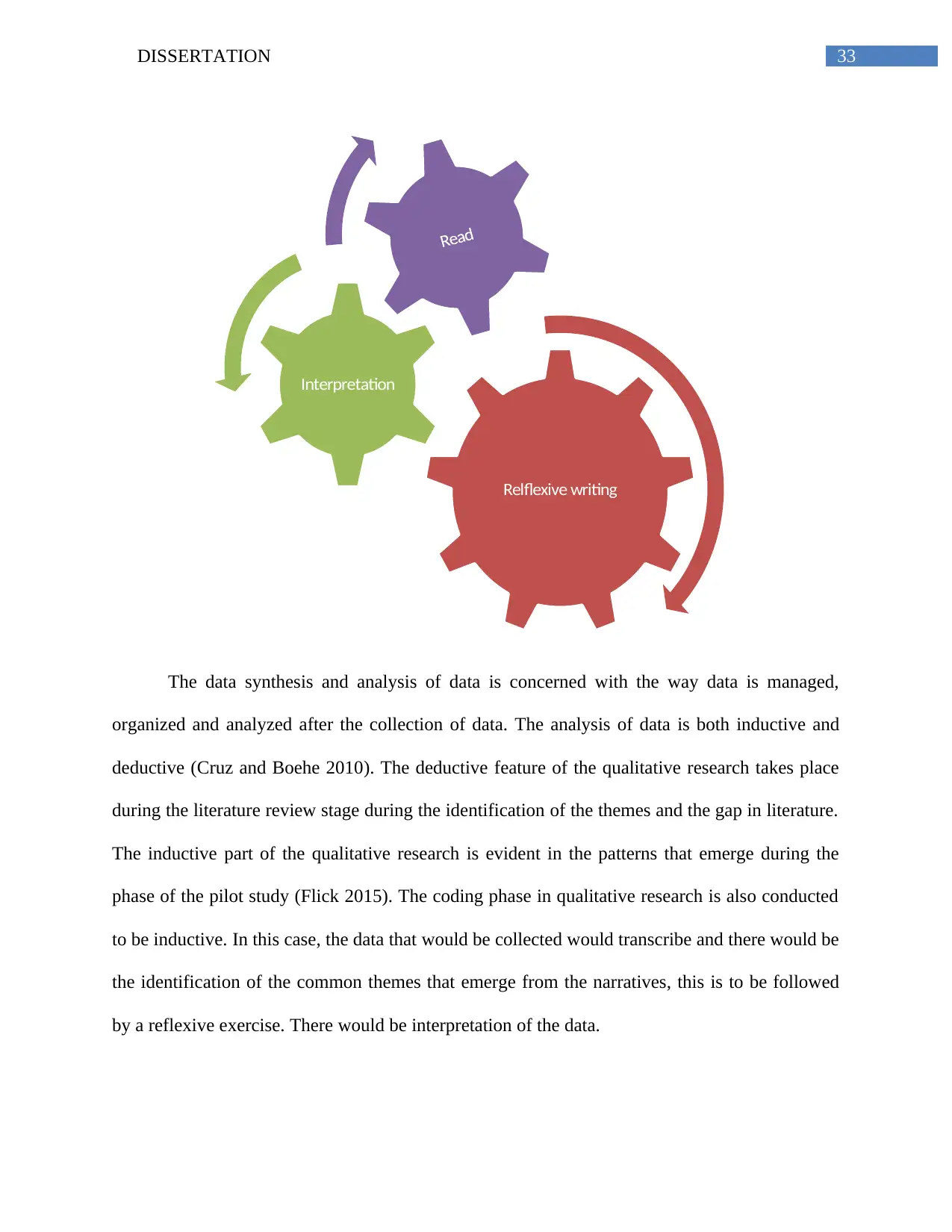
33DISSERTATION
The data synthesis and analysis of data is concerned with the way data is managed,
organized and analyzed after the collection of data. The analysis of data is both inductive and
deductive (Cruz and Boehe 2010). The deductive feature of the qualitative research takes place
during the literature review stage during the identification of the themes and the gap in literature.
The inductive part of the qualitative research is evident in the patterns that emerge during the
phase of the pilot study (Flick 2015). The coding phase in qualitative research is also conducted
to be inductive. In this case, the data that would be collected would transcribe and there would be
the identification of the common themes that emerge from the narratives, this is to be followed
by a reflexive exercise. There would be interpretation of the data.
Relflexive writing
Interpretation
The data synthesis and analysis of data is concerned with the way data is managed,
organized and analyzed after the collection of data. The analysis of data is both inductive and
deductive (Cruz and Boehe 2010). The deductive feature of the qualitative research takes place
during the literature review stage during the identification of the themes and the gap in literature.
The inductive part of the qualitative research is evident in the patterns that emerge during the
phase of the pilot study (Flick 2015). The coding phase in qualitative research is also conducted
to be inductive. In this case, the data that would be collected would transcribe and there would be
the identification of the common themes that emerge from the narratives, this is to be followed
by a reflexive exercise. There would be interpretation of the data.
Relflexive writing
Interpretation
Secure Best Marks with AI Grader
Need help grading? Try our AI Grader for instant feedback on your assignments.
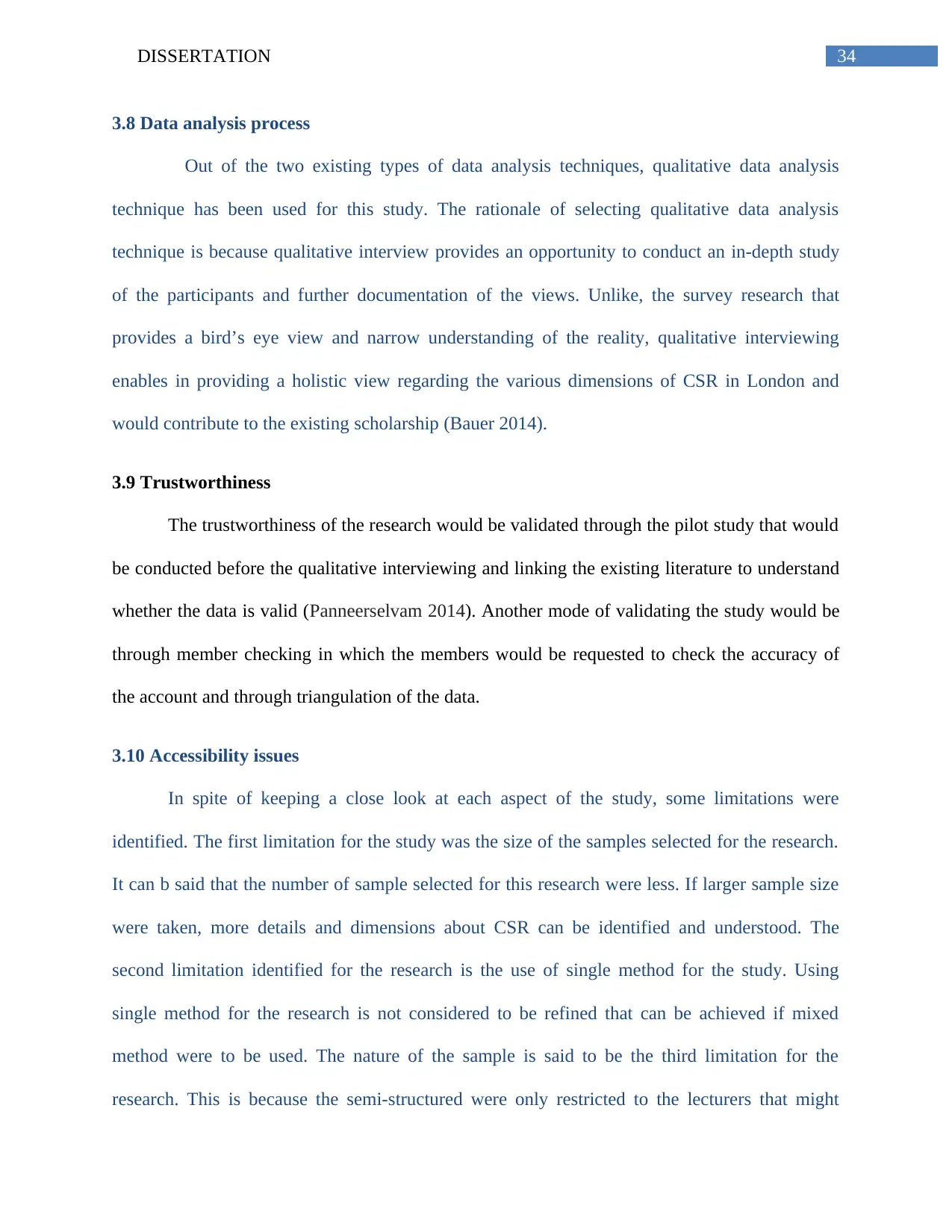
34DISSERTATION
3.8 Data analysis process
Out of the two existing types of data analysis techniques, qualitative data analysis
technique has been used for this study. The rationale of selecting qualitative data analysis
technique is because qualitative interview provides an opportunity to conduct an in-depth study
of the participants and further documentation of the views. Unlike, the survey research that
provides a bird’s eye view and narrow understanding of the reality, qualitative interviewing
enables in providing a holistic view regarding the various dimensions of CSR in London and
would contribute to the existing scholarship (Bauer 2014).
3.9 Trustworthiness
The trustworthiness of the research would be validated through the pilot study that would
be conducted before the qualitative interviewing and linking the existing literature to understand
whether the data is valid (Panneerselvam 2014). Another mode of validating the study would be
through member checking in which the members would be requested to check the accuracy of
the account and through triangulation of the data.
3.10 Accessibility issues
In spite of keeping a close look at each aspect of the study, some limitations were
identified. The first limitation for the study was the size of the samples selected for the research.
It can b said that the number of sample selected for this research were less. If larger sample size
were taken, more details and dimensions about CSR can be identified and understood. The
second limitation identified for the research is the use of single method for the study. Using
single method for the research is not considered to be refined that can be achieved if mixed
method were to be used. The nature of the sample is said to be the third limitation for the
research. This is because the semi-structured were only restricted to the lecturers that might
3.8 Data analysis process
Out of the two existing types of data analysis techniques, qualitative data analysis
technique has been used for this study. The rationale of selecting qualitative data analysis
technique is because qualitative interview provides an opportunity to conduct an in-depth study
of the participants and further documentation of the views. Unlike, the survey research that
provides a bird’s eye view and narrow understanding of the reality, qualitative interviewing
enables in providing a holistic view regarding the various dimensions of CSR in London and
would contribute to the existing scholarship (Bauer 2014).
3.9 Trustworthiness
The trustworthiness of the research would be validated through the pilot study that would
be conducted before the qualitative interviewing and linking the existing literature to understand
whether the data is valid (Panneerselvam 2014). Another mode of validating the study would be
through member checking in which the members would be requested to check the accuracy of
the account and through triangulation of the data.
3.10 Accessibility issues
In spite of keeping a close look at each aspect of the study, some limitations were
identified. The first limitation for the study was the size of the samples selected for the research.
It can b said that the number of sample selected for this research were less. If larger sample size
were taken, more details and dimensions about CSR can be identified and understood. The
second limitation identified for the research is the use of single method for the study. Using
single method for the research is not considered to be refined that can be achieved if mixed
method were to be used. The nature of the sample is said to be the third limitation for the
research. This is because the semi-structured were only restricted to the lecturers that might
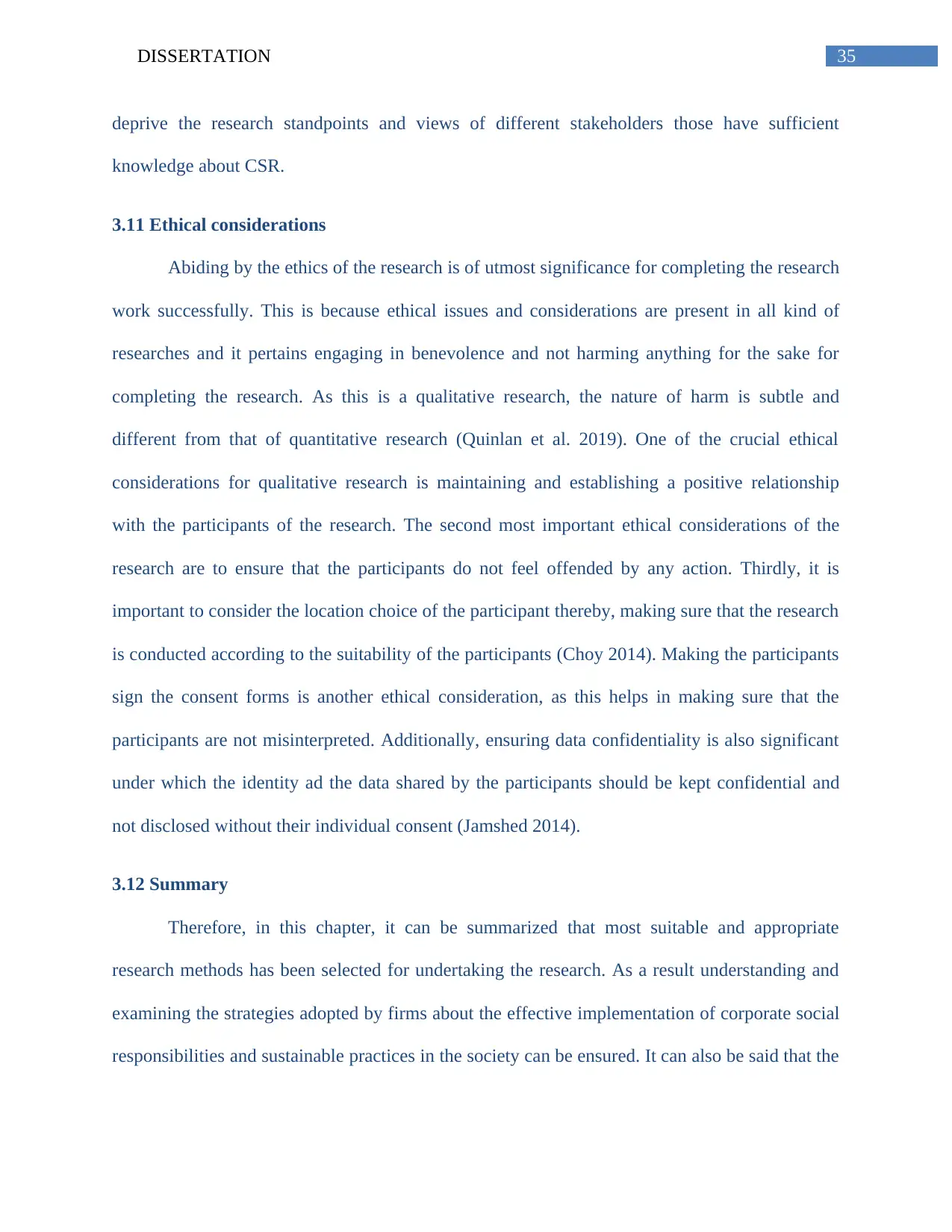
35DISSERTATION
deprive the research standpoints and views of different stakeholders those have sufficient
knowledge about CSR.
3.11 Ethical considerations
Abiding by the ethics of the research is of utmost significance for completing the research
work successfully. This is because ethical issues and considerations are present in all kind of
researches and it pertains engaging in benevolence and not harming anything for the sake for
completing the research. As this is a qualitative research, the nature of harm is subtle and
different from that of quantitative research (Quinlan et al. 2019). One of the crucial ethical
considerations for qualitative research is maintaining and establishing a positive relationship
with the participants of the research. The second most important ethical considerations of the
research are to ensure that the participants do not feel offended by any action. Thirdly, it is
important to consider the location choice of the participant thereby, making sure that the research
is conducted according to the suitability of the participants (Choy 2014). Making the participants
sign the consent forms is another ethical consideration, as this helps in making sure that the
participants are not misinterpreted. Additionally, ensuring data confidentiality is also significant
under which the identity ad the data shared by the participants should be kept confidential and
not disclosed without their individual consent (Jamshed 2014).
3.12 Summary
Therefore, in this chapter, it can be summarized that most suitable and appropriate
research methods has been selected for undertaking the research. As a result understanding and
examining the strategies adopted by firms about the effective implementation of corporate social
responsibilities and sustainable practices in the society can be ensured. It can also be said that the
deprive the research standpoints and views of different stakeholders those have sufficient
knowledge about CSR.
3.11 Ethical considerations
Abiding by the ethics of the research is of utmost significance for completing the research
work successfully. This is because ethical issues and considerations are present in all kind of
researches and it pertains engaging in benevolence and not harming anything for the sake for
completing the research. As this is a qualitative research, the nature of harm is subtle and
different from that of quantitative research (Quinlan et al. 2019). One of the crucial ethical
considerations for qualitative research is maintaining and establishing a positive relationship
with the participants of the research. The second most important ethical considerations of the
research are to ensure that the participants do not feel offended by any action. Thirdly, it is
important to consider the location choice of the participant thereby, making sure that the research
is conducted according to the suitability of the participants (Choy 2014). Making the participants
sign the consent forms is another ethical consideration, as this helps in making sure that the
participants are not misinterpreted. Additionally, ensuring data confidentiality is also significant
under which the identity ad the data shared by the participants should be kept confidential and
not disclosed without their individual consent (Jamshed 2014).
3.12 Summary
Therefore, in this chapter, it can be summarized that most suitable and appropriate
research methods has been selected for undertaking the research. As a result understanding and
examining the strategies adopted by firms about the effective implementation of corporate social
responsibilities and sustainable practices in the society can be ensured. It can also be said that the
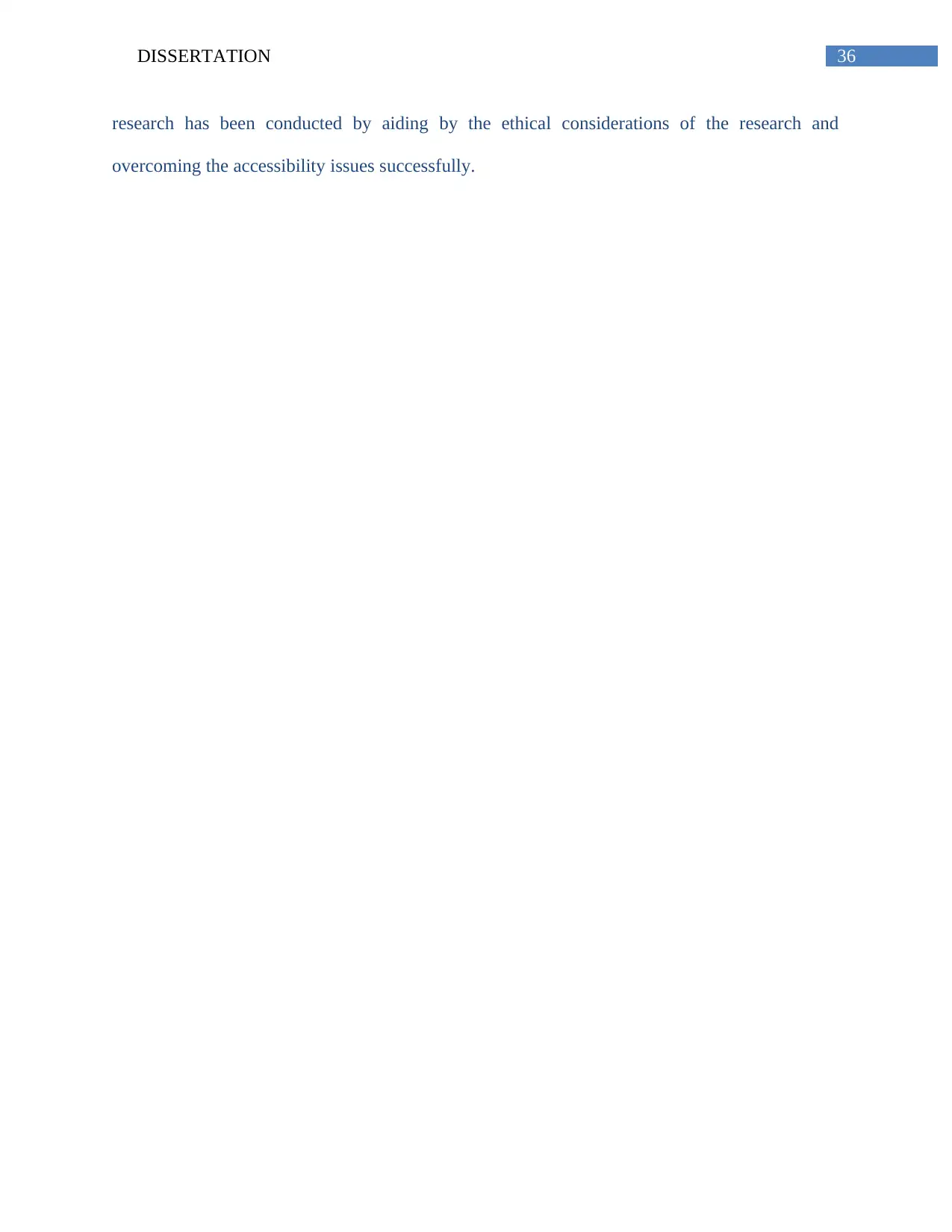
36DISSERTATION
research has been conducted by aiding by the ethical considerations of the research and
overcoming the accessibility issues successfully.
research has been conducted by aiding by the ethical considerations of the research and
overcoming the accessibility issues successfully.
Paraphrase This Document
Need a fresh take? Get an instant paraphrase of this document with our AI Paraphraser
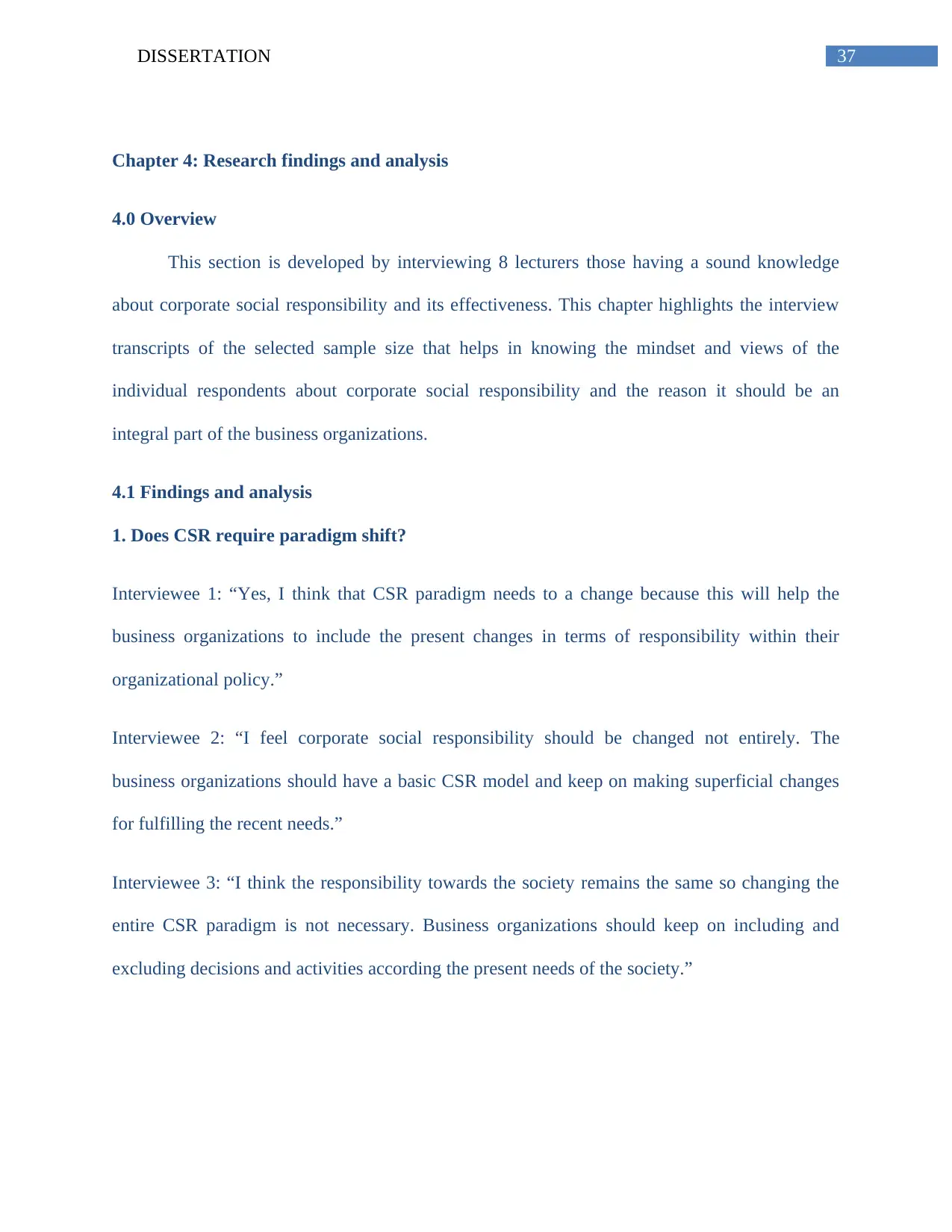
37DISSERTATION
Chapter 4: Research findings and analysis
4.0 Overview
This section is developed by interviewing 8 lecturers those having a sound knowledge
about corporate social responsibility and its effectiveness. This chapter highlights the interview
transcripts of the selected sample size that helps in knowing the mindset and views of the
individual respondents about corporate social responsibility and the reason it should be an
integral part of the business organizations.
4.1 Findings and analysis
1. Does CSR require paradigm shift?
Interviewee 1: “Yes, I think that CSR paradigm needs to a change because this will help the
business organizations to include the present changes in terms of responsibility within their
organizational policy.”
Interviewee 2: “I feel corporate social responsibility should be changed not entirely. The
business organizations should have a basic CSR model and keep on making superficial changes
for fulfilling the recent needs.”
Interviewee 3: “I think the responsibility towards the society remains the same so changing the
entire CSR paradigm is not necessary. Business organizations should keep on including and
excluding decisions and activities according the present needs of the society.”
Chapter 4: Research findings and analysis
4.0 Overview
This section is developed by interviewing 8 lecturers those having a sound knowledge
about corporate social responsibility and its effectiveness. This chapter highlights the interview
transcripts of the selected sample size that helps in knowing the mindset and views of the
individual respondents about corporate social responsibility and the reason it should be an
integral part of the business organizations.
4.1 Findings and analysis
1. Does CSR require paradigm shift?
Interviewee 1: “Yes, I think that CSR paradigm needs to a change because this will help the
business organizations to include the present changes in terms of responsibility within their
organizational policy.”
Interviewee 2: “I feel corporate social responsibility should be changed not entirely. The
business organizations should have a basic CSR model and keep on making superficial changes
for fulfilling the recent needs.”
Interviewee 3: “I think the responsibility towards the society remains the same so changing the
entire CSR paradigm is not necessary. Business organizations should keep on including and
excluding decisions and activities according the present needs of the society.”
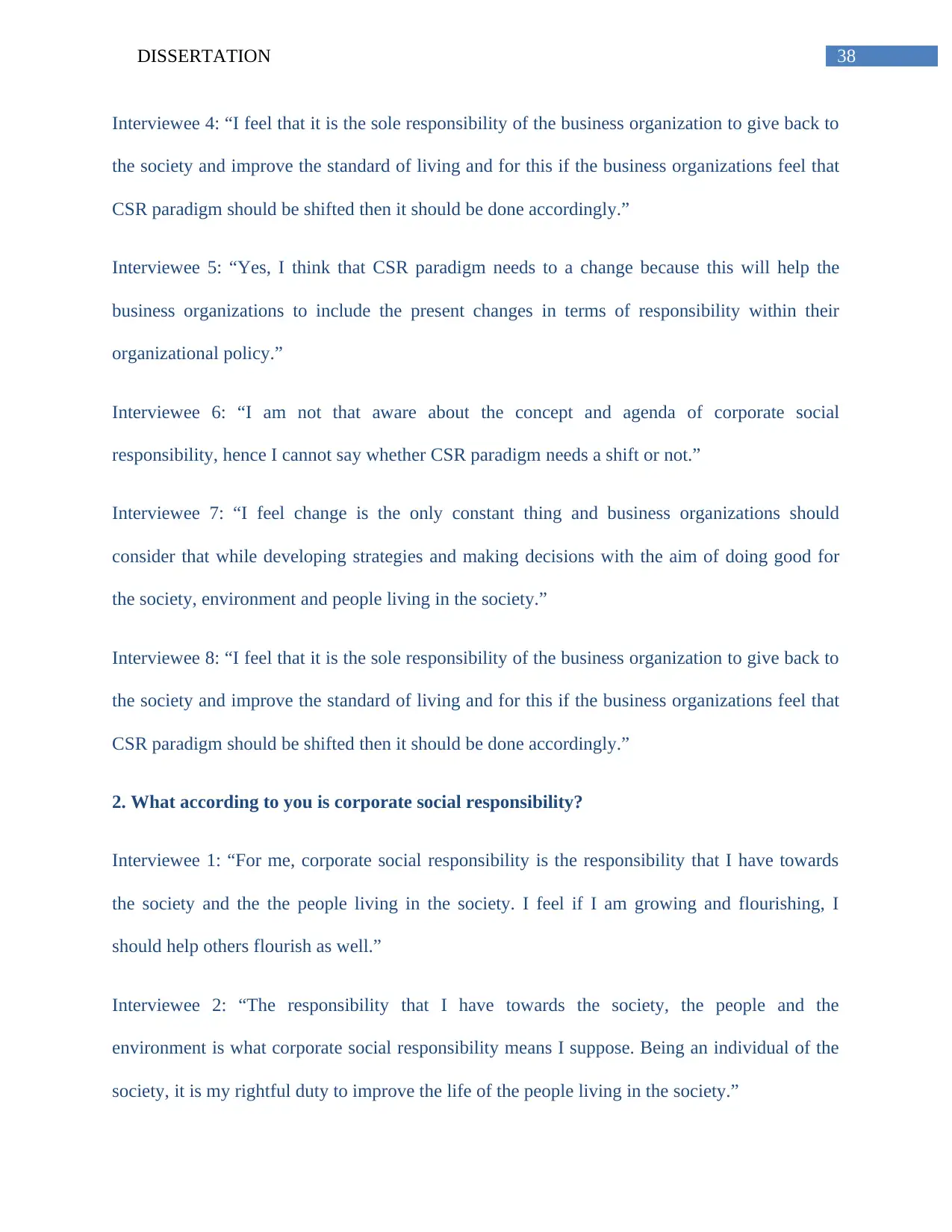
38DISSERTATION
Interviewee 4: “I feel that it is the sole responsibility of the business organization to give back to
the society and improve the standard of living and for this if the business organizations feel that
CSR paradigm should be shifted then it should be done accordingly.”
Interviewee 5: “Yes, I think that CSR paradigm needs to a change because this will help the
business organizations to include the present changes in terms of responsibility within their
organizational policy.”
Interviewee 6: “I am not that aware about the concept and agenda of corporate social
responsibility, hence I cannot say whether CSR paradigm needs a shift or not.”
Interviewee 7: “I feel change is the only constant thing and business organizations should
consider that while developing strategies and making decisions with the aim of doing good for
the society, environment and people living in the society.”
Interviewee 8: “I feel that it is the sole responsibility of the business organization to give back to
the society and improve the standard of living and for this if the business organizations feel that
CSR paradigm should be shifted then it should be done accordingly.”
2. What according to you is corporate social responsibility?
Interviewee 1: “For me, corporate social responsibility is the responsibility that I have towards
the society and the the people living in the society. I feel if I am growing and flourishing, I
should help others flourish as well.”
Interviewee 2: “The responsibility that I have towards the society, the people and the
environment is what corporate social responsibility means I suppose. Being an individual of the
society, it is my rightful duty to improve the life of the people living in the society.”
Interviewee 4: “I feel that it is the sole responsibility of the business organization to give back to
the society and improve the standard of living and for this if the business organizations feel that
CSR paradigm should be shifted then it should be done accordingly.”
Interviewee 5: “Yes, I think that CSR paradigm needs to a change because this will help the
business organizations to include the present changes in terms of responsibility within their
organizational policy.”
Interviewee 6: “I am not that aware about the concept and agenda of corporate social
responsibility, hence I cannot say whether CSR paradigm needs a shift or not.”
Interviewee 7: “I feel change is the only constant thing and business organizations should
consider that while developing strategies and making decisions with the aim of doing good for
the society, environment and people living in the society.”
Interviewee 8: “I feel that it is the sole responsibility of the business organization to give back to
the society and improve the standard of living and for this if the business organizations feel that
CSR paradigm should be shifted then it should be done accordingly.”
2. What according to you is corporate social responsibility?
Interviewee 1: “For me, corporate social responsibility is the responsibility that I have towards
the society and the the people living in the society. I feel if I am growing and flourishing, I
should help others flourish as well.”
Interviewee 2: “The responsibility that I have towards the society, the people and the
environment is what corporate social responsibility means I suppose. Being an individual of the
society, it is my rightful duty to improve the life of the people living in the society.”
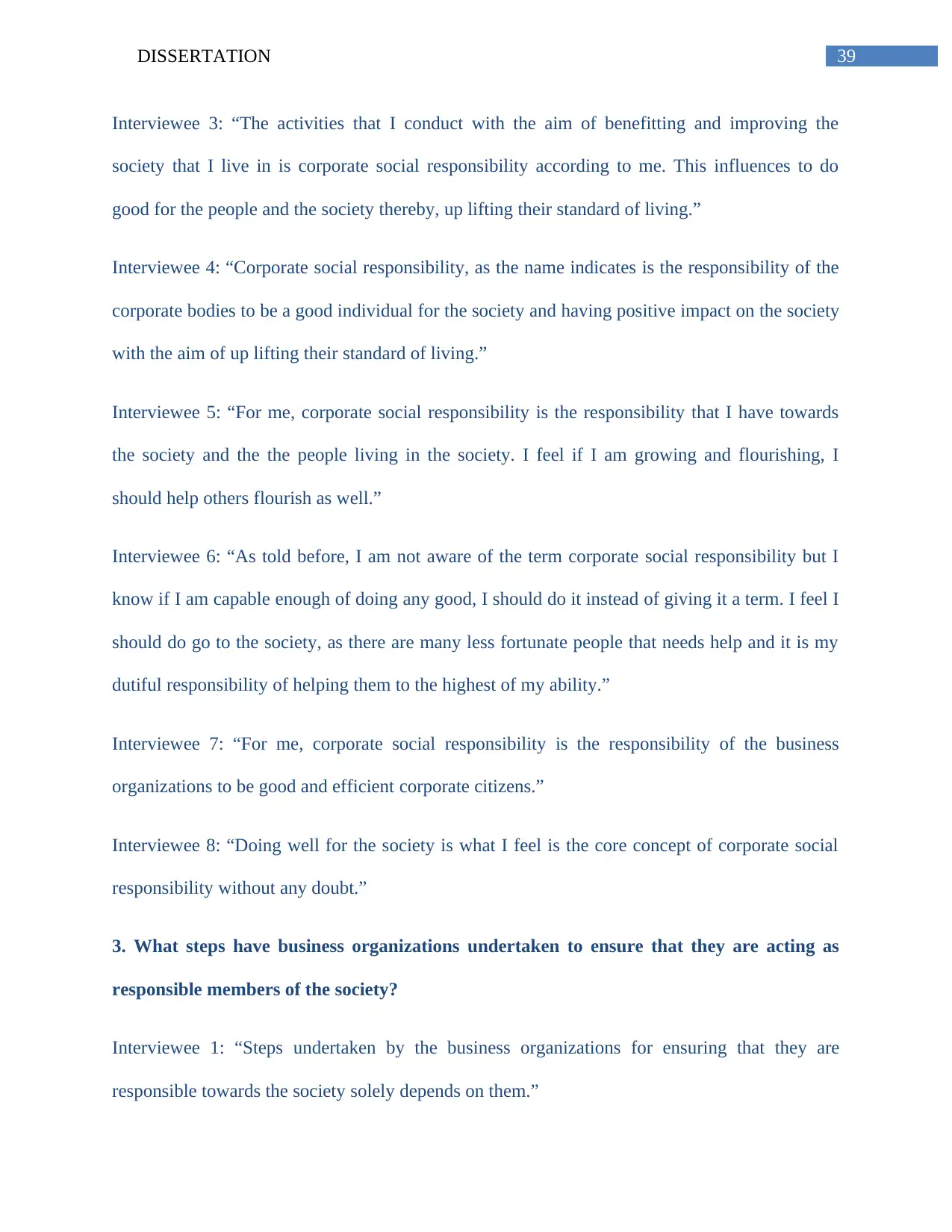
39DISSERTATION
Interviewee 3: “The activities that I conduct with the aim of benefitting and improving the
society that I live in is corporate social responsibility according to me. This influences to do
good for the people and the society thereby, up lifting their standard of living.”
Interviewee 4: “Corporate social responsibility, as the name indicates is the responsibility of the
corporate bodies to be a good individual for the society and having positive impact on the society
with the aim of up lifting their standard of living.”
Interviewee 5: “For me, corporate social responsibility is the responsibility that I have towards
the society and the the people living in the society. I feel if I am growing and flourishing, I
should help others flourish as well.”
Interviewee 6: “As told before, I am not aware of the term corporate social responsibility but I
know if I am capable enough of doing any good, I should do it instead of giving it a term. I feel I
should do go to the society, as there are many less fortunate people that needs help and it is my
dutiful responsibility of helping them to the highest of my ability.”
Interviewee 7: “For me, corporate social responsibility is the responsibility of the business
organizations to be good and efficient corporate citizens.”
Interviewee 8: “Doing well for the society is what I feel is the core concept of corporate social
responsibility without any doubt.”
3. What steps have business organizations undertaken to ensure that they are acting as
responsible members of the society?
Interviewee 1: “Steps undertaken by the business organizations for ensuring that they are
responsible towards the society solely depends on them.”
Interviewee 3: “The activities that I conduct with the aim of benefitting and improving the
society that I live in is corporate social responsibility according to me. This influences to do
good for the people and the society thereby, up lifting their standard of living.”
Interviewee 4: “Corporate social responsibility, as the name indicates is the responsibility of the
corporate bodies to be a good individual for the society and having positive impact on the society
with the aim of up lifting their standard of living.”
Interviewee 5: “For me, corporate social responsibility is the responsibility that I have towards
the society and the the people living in the society. I feel if I am growing and flourishing, I
should help others flourish as well.”
Interviewee 6: “As told before, I am not aware of the term corporate social responsibility but I
know if I am capable enough of doing any good, I should do it instead of giving it a term. I feel I
should do go to the society, as there are many less fortunate people that needs help and it is my
dutiful responsibility of helping them to the highest of my ability.”
Interviewee 7: “For me, corporate social responsibility is the responsibility of the business
organizations to be good and efficient corporate citizens.”
Interviewee 8: “Doing well for the society is what I feel is the core concept of corporate social
responsibility without any doubt.”
3. What steps have business organizations undertaken to ensure that they are acting as
responsible members of the society?
Interviewee 1: “Steps undertaken by the business organizations for ensuring that they are
responsible towards the society solely depends on them.”
Secure Best Marks with AI Grader
Need help grading? Try our AI Grader for instant feedback on your assignments.
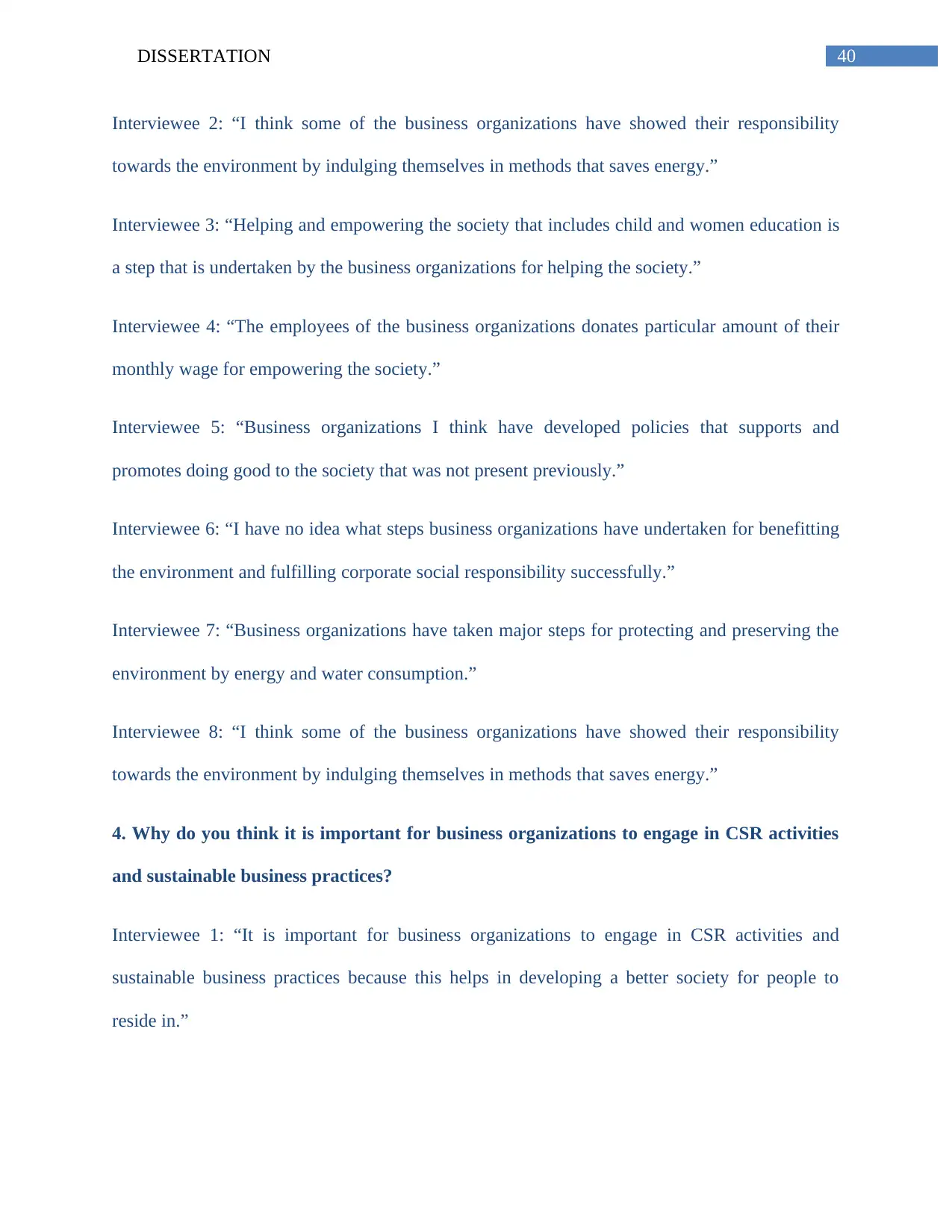
40DISSERTATION
Interviewee 2: “I think some of the business organizations have showed their responsibility
towards the environment by indulging themselves in methods that saves energy.”
Interviewee 3: “Helping and empowering the society that includes child and women education is
a step that is undertaken by the business organizations for helping the society.”
Interviewee 4: “The employees of the business organizations donates particular amount of their
monthly wage for empowering the society.”
Interviewee 5: “Business organizations I think have developed policies that supports and
promotes doing good to the society that was not present previously.”
Interviewee 6: “I have no idea what steps business organizations have undertaken for benefitting
the environment and fulfilling corporate social responsibility successfully.”
Interviewee 7: “Business organizations have taken major steps for protecting and preserving the
environment by energy and water consumption.”
Interviewee 8: “I think some of the business organizations have showed their responsibility
towards the environment by indulging themselves in methods that saves energy.”
4. Why do you think it is important for business organizations to engage in CSR activities
and sustainable business practices?
Interviewee 1: “It is important for business organizations to engage in CSR activities and
sustainable business practices because this helps in developing a better society for people to
reside in.”
Interviewee 2: “I think some of the business organizations have showed their responsibility
towards the environment by indulging themselves in methods that saves energy.”
Interviewee 3: “Helping and empowering the society that includes child and women education is
a step that is undertaken by the business organizations for helping the society.”
Interviewee 4: “The employees of the business organizations donates particular amount of their
monthly wage for empowering the society.”
Interviewee 5: “Business organizations I think have developed policies that supports and
promotes doing good to the society that was not present previously.”
Interviewee 6: “I have no idea what steps business organizations have undertaken for benefitting
the environment and fulfilling corporate social responsibility successfully.”
Interviewee 7: “Business organizations have taken major steps for protecting and preserving the
environment by energy and water consumption.”
Interviewee 8: “I think some of the business organizations have showed their responsibility
towards the environment by indulging themselves in methods that saves energy.”
4. Why do you think it is important for business organizations to engage in CSR activities
and sustainable business practices?
Interviewee 1: “It is important for business organizations to engage in CSR activities and
sustainable business practices because this helps in developing a better society for people to
reside in.”

41DISSERTATION
Interviewee 2: “It is important for business organizations to engage in CSR activities and
sustainable business practices because the business organizations are able to gain reputation in
the business market.”
Interviewee 3: “It is important for business organizations to engage in CSR activities and
sustainable business practices because this provides and opens up new business opportunities for
the companies.”
Interviewee 4: “It is important for business organizations to engage in CSR activities and
sustainable business practices because this provides opportunity to up lift the living standard of
the society.”
Interviewee 5: “It is important for business organizations to engage in CSR activities and
sustainable business practices because good relationships with the local authorizes can often
make doing business easier.”
Interviewee 6: “I feel as the business organizations are doing good for the society, it must impose
benefits for the business organizations rather than imposing negative impacts.”
Interviewee 7: “It is important for business organizations to engage in CSR activities and
sustainable business practices because the increased popularity and media coverage often boosts
and opens new business opportunities for the business organizations.”
Interviewee 8: ““It is important for business organizations to engage in CSR activities and
sustainable business practices because this provides and opens up new business opportunities for
the companies.”
Interviewee 2: “It is important for business organizations to engage in CSR activities and
sustainable business practices because the business organizations are able to gain reputation in
the business market.”
Interviewee 3: “It is important for business organizations to engage in CSR activities and
sustainable business practices because this provides and opens up new business opportunities for
the companies.”
Interviewee 4: “It is important for business organizations to engage in CSR activities and
sustainable business practices because this provides opportunity to up lift the living standard of
the society.”
Interviewee 5: “It is important for business organizations to engage in CSR activities and
sustainable business practices because good relationships with the local authorizes can often
make doing business easier.”
Interviewee 6: “I feel as the business organizations are doing good for the society, it must impose
benefits for the business organizations rather than imposing negative impacts.”
Interviewee 7: “It is important for business organizations to engage in CSR activities and
sustainable business practices because the increased popularity and media coverage often boosts
and opens new business opportunities for the business organizations.”
Interviewee 8: ““It is important for business organizations to engage in CSR activities and
sustainable business practices because this provides and opens up new business opportunities for
the companies.”
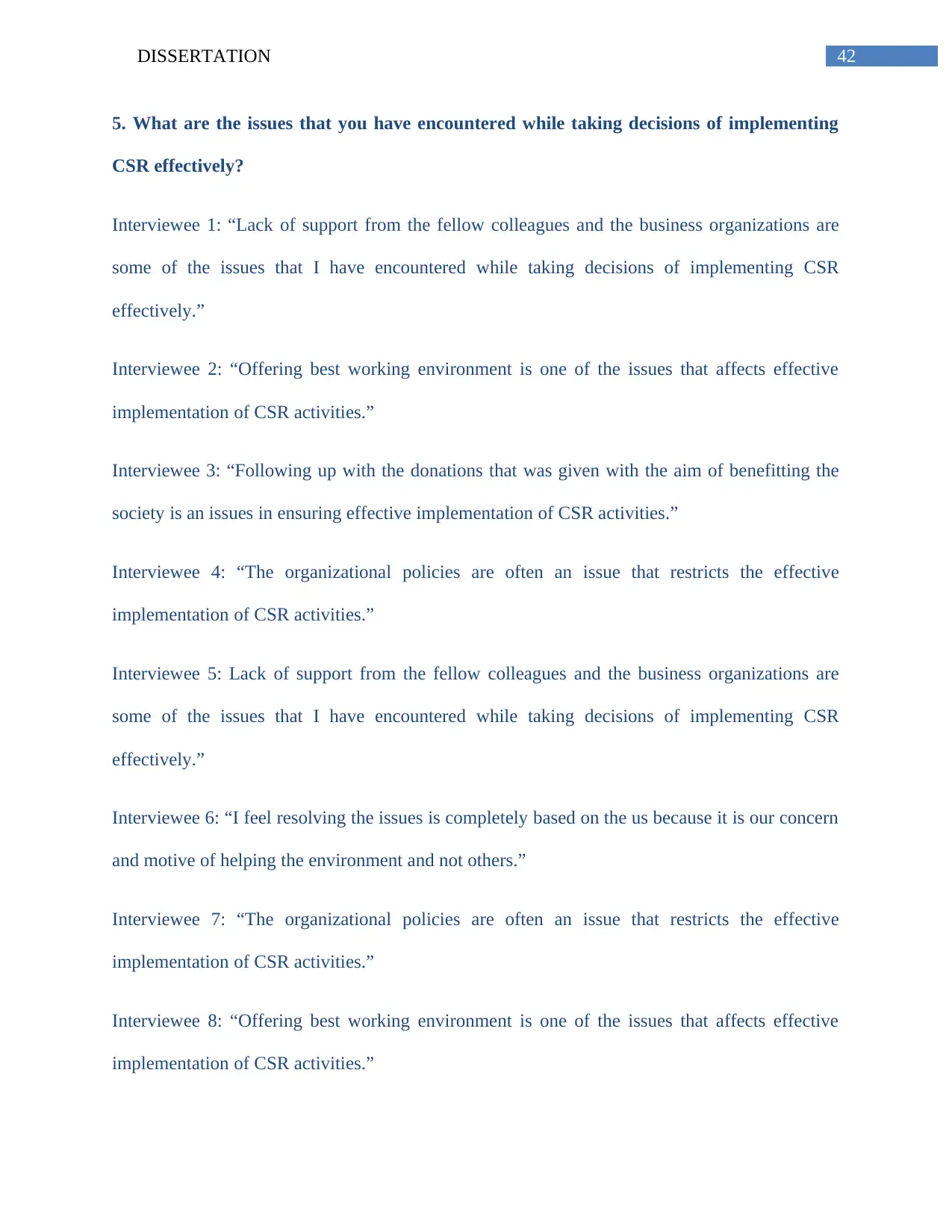
42DISSERTATION
5. What are the issues that you have encountered while taking decisions of implementing
CSR effectively?
Interviewee 1: “Lack of support from the fellow colleagues and the business organizations are
some of the issues that I have encountered while taking decisions of implementing CSR
effectively.”
Interviewee 2: “Offering best working environment is one of the issues that affects effective
implementation of CSR activities.”
Interviewee 3: “Following up with the donations that was given with the aim of benefitting the
society is an issues in ensuring effective implementation of CSR activities.”
Interviewee 4: “The organizational policies are often an issue that restricts the effective
implementation of CSR activities.”
Interviewee 5: Lack of support from the fellow colleagues and the business organizations are
some of the issues that I have encountered while taking decisions of implementing CSR
effectively.”
Interviewee 6: “I feel resolving the issues is completely based on the us because it is our concern
and motive of helping the environment and not others.”
Interviewee 7: “The organizational policies are often an issue that restricts the effective
implementation of CSR activities.”
Interviewee 8: “Offering best working environment is one of the issues that affects effective
implementation of CSR activities.”
5. What are the issues that you have encountered while taking decisions of implementing
CSR effectively?
Interviewee 1: “Lack of support from the fellow colleagues and the business organizations are
some of the issues that I have encountered while taking decisions of implementing CSR
effectively.”
Interviewee 2: “Offering best working environment is one of the issues that affects effective
implementation of CSR activities.”
Interviewee 3: “Following up with the donations that was given with the aim of benefitting the
society is an issues in ensuring effective implementation of CSR activities.”
Interviewee 4: “The organizational policies are often an issue that restricts the effective
implementation of CSR activities.”
Interviewee 5: Lack of support from the fellow colleagues and the business organizations are
some of the issues that I have encountered while taking decisions of implementing CSR
effectively.”
Interviewee 6: “I feel resolving the issues is completely based on the us because it is our concern
and motive of helping the environment and not others.”
Interviewee 7: “The organizational policies are often an issue that restricts the effective
implementation of CSR activities.”
Interviewee 8: “Offering best working environment is one of the issues that affects effective
implementation of CSR activities.”
Paraphrase This Document
Need a fresh take? Get an instant paraphrase of this document with our AI Paraphraser

43DISSERTATION
4.2 Summary
Therefore, from the chapter, it can be summarized that the participants support the idea
and concept of corporate social responsibility and thinks that it should be included and
considered as an integral part of every business organizations. The participants are well aware of
the CSR activities undertaken by well-known multinational companies such as Coco-Cola, Pepsi
Co, Microsoft, Google and Amazon.
4.2 Summary
Therefore, from the chapter, it can be summarized that the participants support the idea
and concept of corporate social responsibility and thinks that it should be included and
considered as an integral part of every business organizations. The participants are well aware of
the CSR activities undertaken by well-known multinational companies such as Coco-Cola, Pepsi
Co, Microsoft, Google and Amazon.
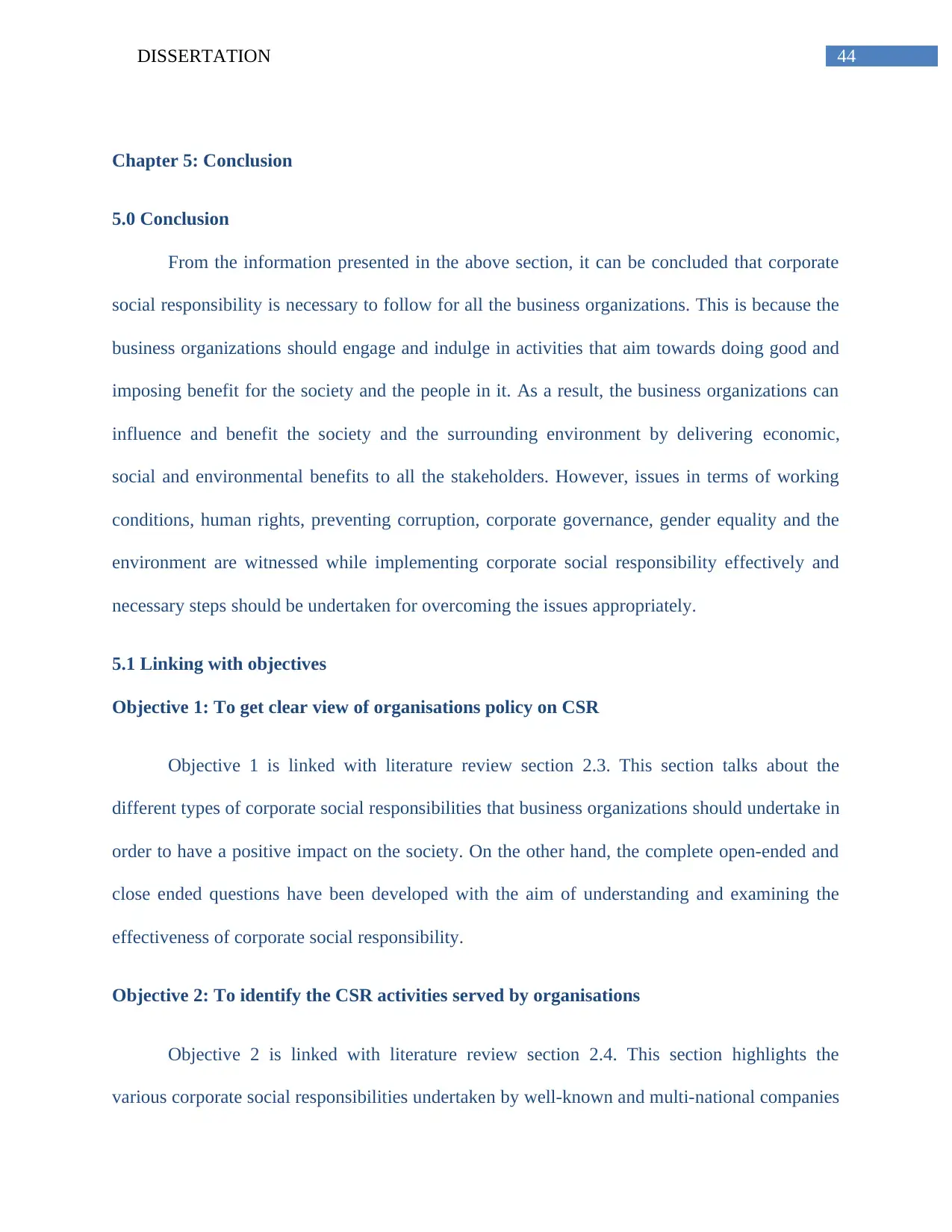
44DISSERTATION
Chapter 5: Conclusion
5.0 Conclusion
From the information presented in the above section, it can be concluded that corporate
social responsibility is necessary to follow for all the business organizations. This is because the
business organizations should engage and indulge in activities that aim towards doing good and
imposing benefit for the society and the people in it. As a result, the business organizations can
influence and benefit the society and the surrounding environment by delivering economic,
social and environmental benefits to all the stakeholders. However, issues in terms of working
conditions, human rights, preventing corruption, corporate governance, gender equality and the
environment are witnessed while implementing corporate social responsibility effectively and
necessary steps should be undertaken for overcoming the issues appropriately.
5.1 Linking with objectives
Objective 1: To get clear view of organisations policy on CSR
Objective 1 is linked with literature review section 2.3. This section talks about the
different types of corporate social responsibilities that business organizations should undertake in
order to have a positive impact on the society. On the other hand, the complete open-ended and
close ended questions have been developed with the aim of understanding and examining the
effectiveness of corporate social responsibility.
Objective 2: To identify the CSR activities served by organisations
Objective 2 is linked with literature review section 2.4. This section highlights the
various corporate social responsibilities undertaken by well-known and multi-national companies
Chapter 5: Conclusion
5.0 Conclusion
From the information presented in the above section, it can be concluded that corporate
social responsibility is necessary to follow for all the business organizations. This is because the
business organizations should engage and indulge in activities that aim towards doing good and
imposing benefit for the society and the people in it. As a result, the business organizations can
influence and benefit the society and the surrounding environment by delivering economic,
social and environmental benefits to all the stakeholders. However, issues in terms of working
conditions, human rights, preventing corruption, corporate governance, gender equality and the
environment are witnessed while implementing corporate social responsibility effectively and
necessary steps should be undertaken for overcoming the issues appropriately.
5.1 Linking with objectives
Objective 1: To get clear view of organisations policy on CSR
Objective 1 is linked with literature review section 2.3. This section talks about the
different types of corporate social responsibilities that business organizations should undertake in
order to have a positive impact on the society. On the other hand, the complete open-ended and
close ended questions have been developed with the aim of understanding and examining the
effectiveness of corporate social responsibility.
Objective 2: To identify the CSR activities served by organisations
Objective 2 is linked with literature review section 2.4. This section highlights the
various corporate social responsibilities undertaken by well-known and multi-national companies
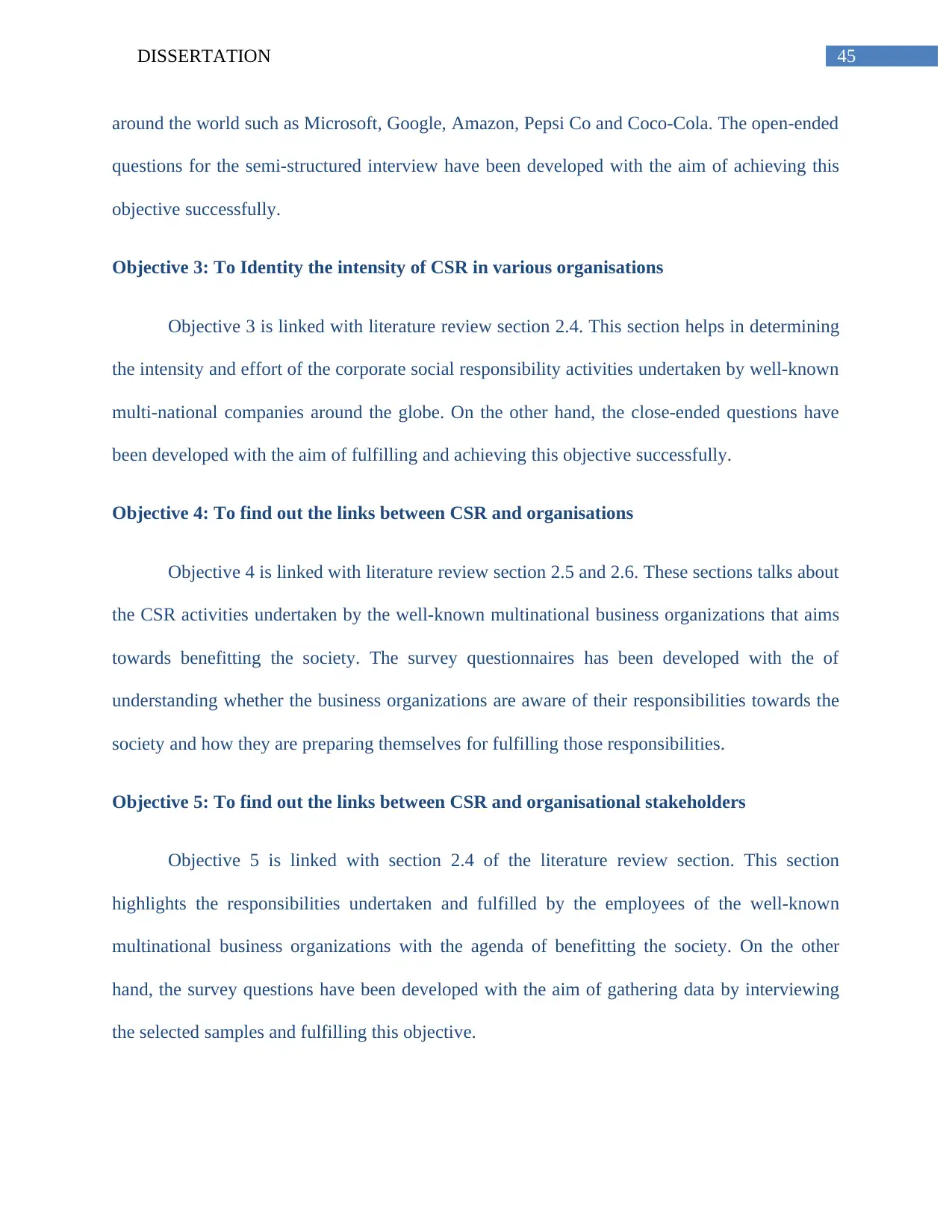
45DISSERTATION
around the world such as Microsoft, Google, Amazon, Pepsi Co and Coco-Cola. The open-ended
questions for the semi-structured interview have been developed with the aim of achieving this
objective successfully.
Objective 3: To Identity the intensity of CSR in various organisations
Objective 3 is linked with literature review section 2.4. This section helps in determining
the intensity and effort of the corporate social responsibility activities undertaken by well-known
multi-national companies around the globe. On the other hand, the close-ended questions have
been developed with the aim of fulfilling and achieving this objective successfully.
Objective 4: To find out the links between CSR and organisations
Objective 4 is linked with literature review section 2.5 and 2.6. These sections talks about
the CSR activities undertaken by the well-known multinational business organizations that aims
towards benefitting the society. The survey questionnaires has been developed with the of
understanding whether the business organizations are aware of their responsibilities towards the
society and how they are preparing themselves for fulfilling those responsibilities.
Objective 5: To find out the links between CSR and organisational stakeholders
Objective 5 is linked with section 2.4 of the literature review section. This section
highlights the responsibilities undertaken and fulfilled by the employees of the well-known
multinational business organizations with the agenda of benefitting the society. On the other
hand, the survey questions have been developed with the aim of gathering data by interviewing
the selected samples and fulfilling this objective.
around the world such as Microsoft, Google, Amazon, Pepsi Co and Coco-Cola. The open-ended
questions for the semi-structured interview have been developed with the aim of achieving this
objective successfully.
Objective 3: To Identity the intensity of CSR in various organisations
Objective 3 is linked with literature review section 2.4. This section helps in determining
the intensity and effort of the corporate social responsibility activities undertaken by well-known
multi-national companies around the globe. On the other hand, the close-ended questions have
been developed with the aim of fulfilling and achieving this objective successfully.
Objective 4: To find out the links between CSR and organisations
Objective 4 is linked with literature review section 2.5 and 2.6. These sections talks about
the CSR activities undertaken by the well-known multinational business organizations that aims
towards benefitting the society. The survey questionnaires has been developed with the of
understanding whether the business organizations are aware of their responsibilities towards the
society and how they are preparing themselves for fulfilling those responsibilities.
Objective 5: To find out the links between CSR and organisational stakeholders
Objective 5 is linked with section 2.4 of the literature review section. This section
highlights the responsibilities undertaken and fulfilled by the employees of the well-known
multinational business organizations with the agenda of benefitting the society. On the other
hand, the survey questions have been developed with the aim of gathering data by interviewing
the selected samples and fulfilling this objective.
Secure Best Marks with AI Grader
Need help grading? Try our AI Grader for instant feedback on your assignments.
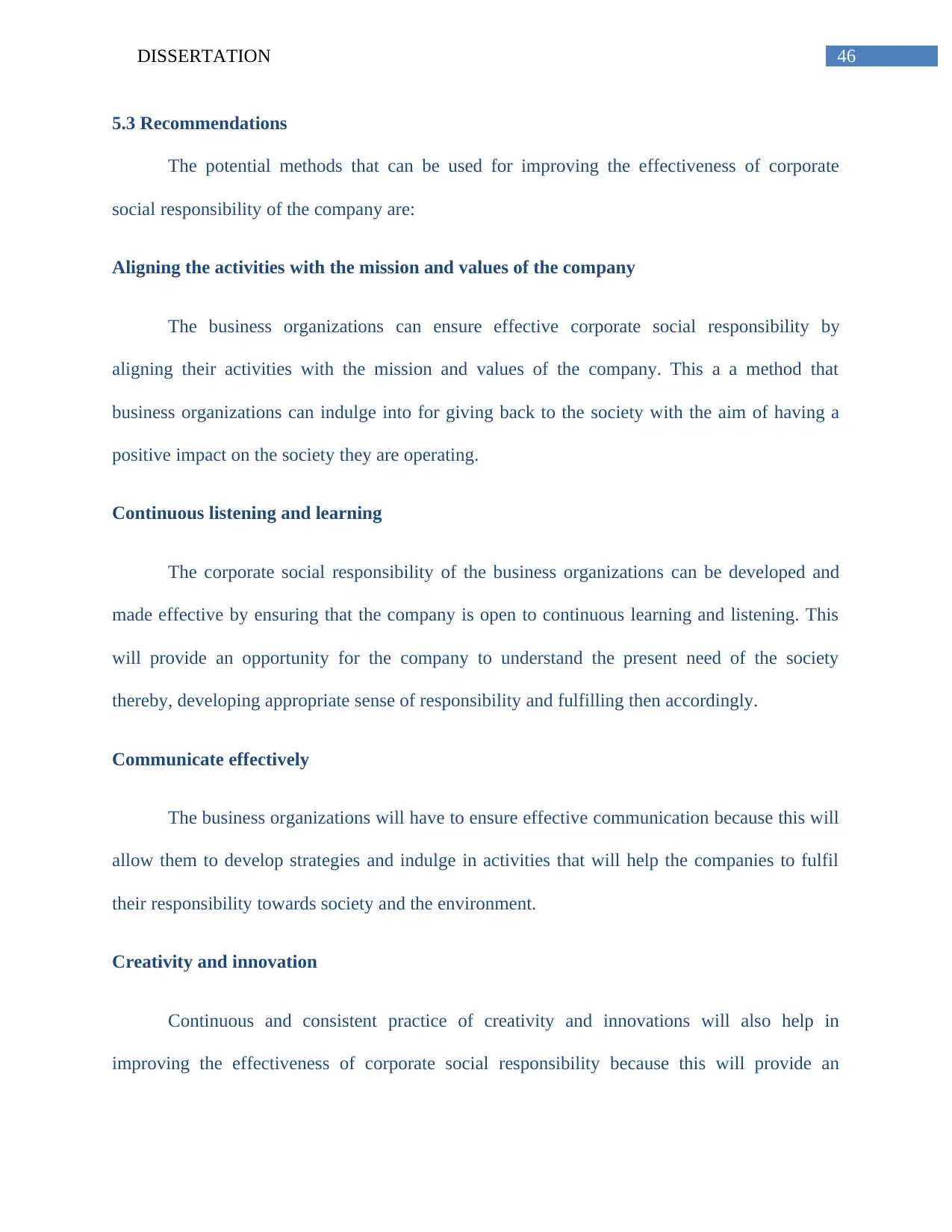
46DISSERTATION
5.3 Recommendations
The potential methods that can be used for improving the effectiveness of corporate
social responsibility of the company are:
Aligning the activities with the mission and values of the company
The business organizations can ensure effective corporate social responsibility by
aligning their activities with the mission and values of the company. This a a method that
business organizations can indulge into for giving back to the society with the aim of having a
positive impact on the society they are operating.
Continuous listening and learning
The corporate social responsibility of the business organizations can be developed and
made effective by ensuring that the company is open to continuous learning and listening. This
will provide an opportunity for the company to understand the present need of the society
thereby, developing appropriate sense of responsibility and fulfilling then accordingly.
Communicate effectively
The business organizations will have to ensure effective communication because this will
allow them to develop strategies and indulge in activities that will help the companies to fulfil
their responsibility towards society and the environment.
Creativity and innovation
Continuous and consistent practice of creativity and innovations will also help in
improving the effectiveness of corporate social responsibility because this will provide an
5.3 Recommendations
The potential methods that can be used for improving the effectiveness of corporate
social responsibility of the company are:
Aligning the activities with the mission and values of the company
The business organizations can ensure effective corporate social responsibility by
aligning their activities with the mission and values of the company. This a a method that
business organizations can indulge into for giving back to the society with the aim of having a
positive impact on the society they are operating.
Continuous listening and learning
The corporate social responsibility of the business organizations can be developed and
made effective by ensuring that the company is open to continuous learning and listening. This
will provide an opportunity for the company to understand the present need of the society
thereby, developing appropriate sense of responsibility and fulfilling then accordingly.
Communicate effectively
The business organizations will have to ensure effective communication because this will
allow them to develop strategies and indulge in activities that will help the companies to fulfil
their responsibility towards society and the environment.
Creativity and innovation
Continuous and consistent practice of creativity and innovations will also help in
improving the effectiveness of corporate social responsibility because this will provide an
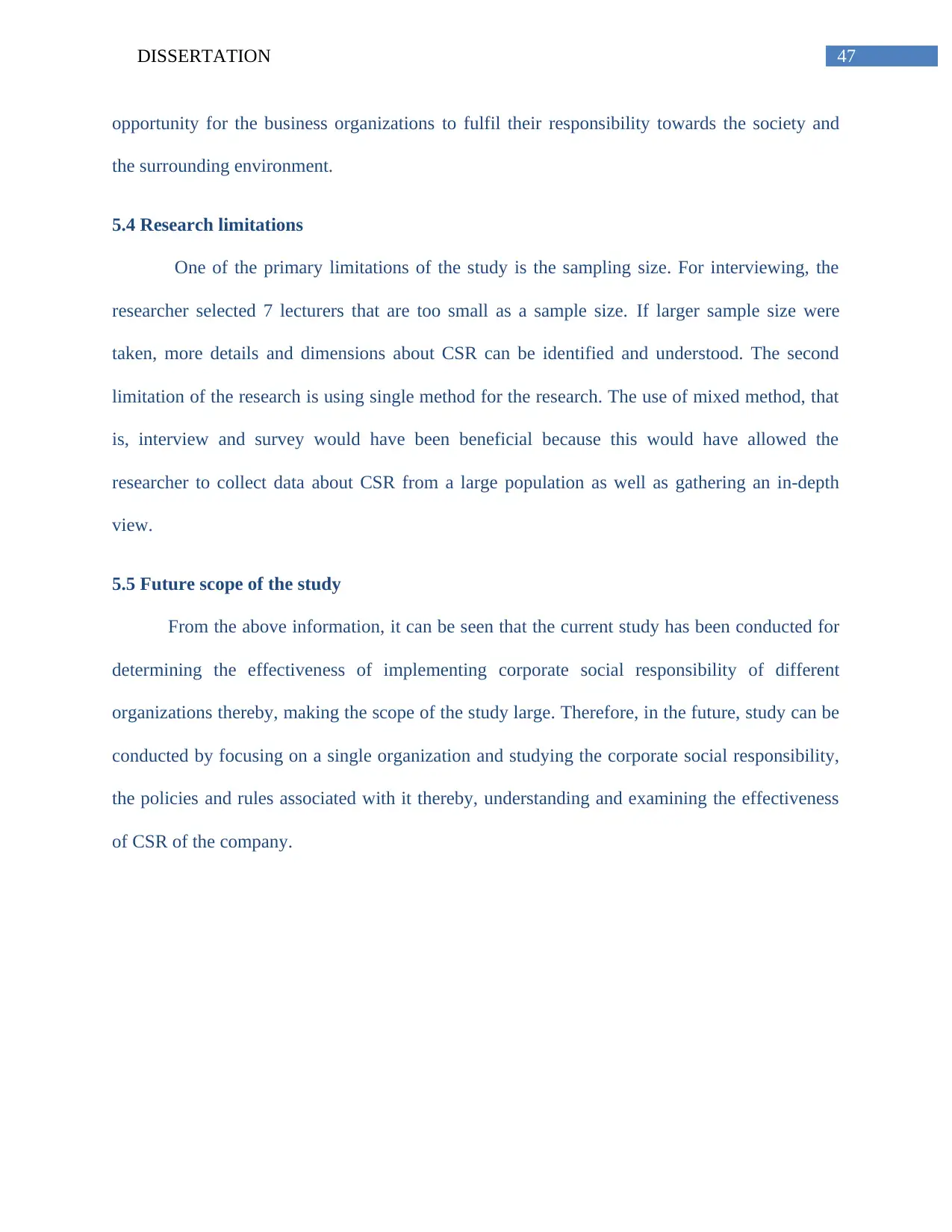
47DISSERTATION
opportunity for the business organizations to fulfil their responsibility towards the society and
the surrounding environment.
5.4 Research limitations
One of the primary limitations of the study is the sampling size. For interviewing, the
researcher selected 7 lecturers that are too small as a sample size. If larger sample size were
taken, more details and dimensions about CSR can be identified and understood. The second
limitation of the research is using single method for the research. The use of mixed method, that
is, interview and survey would have been beneficial because this would have allowed the
researcher to collect data about CSR from a large population as well as gathering an in-depth
view.
5.5 Future scope of the study
From the above information, it can be seen that the current study has been conducted for
determining the effectiveness of implementing corporate social responsibility of different
organizations thereby, making the scope of the study large. Therefore, in the future, study can be
conducted by focusing on a single organization and studying the corporate social responsibility,
the policies and rules associated with it thereby, understanding and examining the effectiveness
of CSR of the company.
opportunity for the business organizations to fulfil their responsibility towards the society and
the surrounding environment.
5.4 Research limitations
One of the primary limitations of the study is the sampling size. For interviewing, the
researcher selected 7 lecturers that are too small as a sample size. If larger sample size were
taken, more details and dimensions about CSR can be identified and understood. The second
limitation of the research is using single method for the research. The use of mixed method, that
is, interview and survey would have been beneficial because this would have allowed the
researcher to collect data about CSR from a large population as well as gathering an in-depth
view.
5.5 Future scope of the study
From the above information, it can be seen that the current study has been conducted for
determining the effectiveness of implementing corporate social responsibility of different
organizations thereby, making the scope of the study large. Therefore, in the future, study can be
conducted by focusing on a single organization and studying the corporate social responsibility,
the policies and rules associated with it thereby, understanding and examining the effectiveness
of CSR of the company.
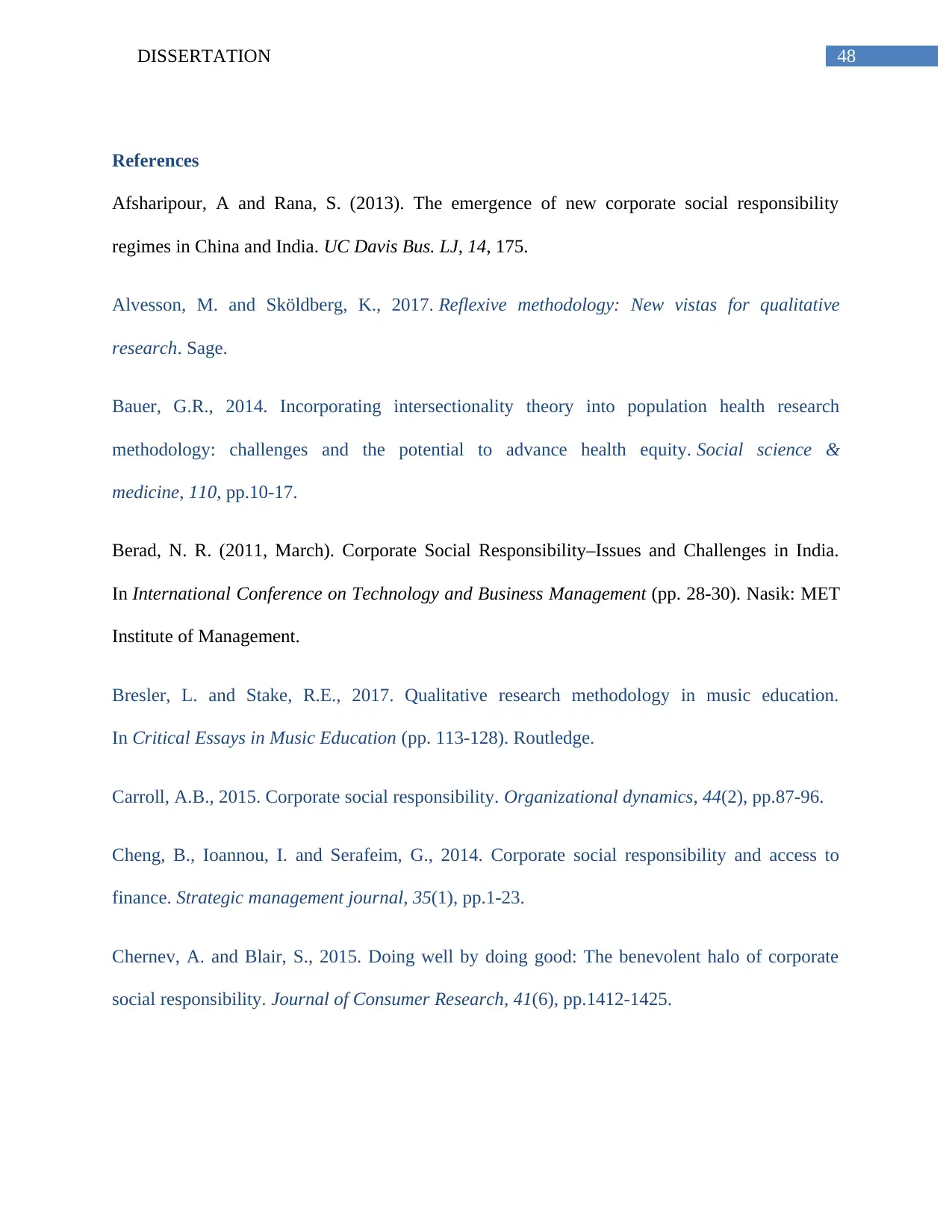
48DISSERTATION
References
Afsharipour, A and Rana, S. (2013). The emergence of new corporate social responsibility
regimes in China and India. UC Davis Bus. LJ, 14, 175.
Alvesson, M. and Sköldberg, K., 2017. Reflexive methodology: New vistas for qualitative
research. Sage.
Bauer, G.R., 2014. Incorporating intersectionality theory into population health research
methodology: challenges and the potential to advance health equity. Social science &
medicine, 110, pp.10-17.
Berad, N. R. (2011, March). Corporate Social Responsibility–Issues and Challenges in India.
In International Conference on Technology and Business Management (pp. 28-30). Nasik: MET
Institute of Management.
Bresler, L. and Stake, R.E., 2017. Qualitative research methodology in music education.
In Critical Essays in Music Education (pp. 113-128). Routledge.
Carroll, A.B., 2015. Corporate social responsibility. Organizational dynamics, 44(2), pp.87-96.
Cheng, B., Ioannou, I. and Serafeim, G., 2014. Corporate social responsibility and access to
finance. Strategic management journal, 35(1), pp.1-23.
Chernev, A. and Blair, S., 2015. Doing well by doing good: The benevolent halo of corporate
social responsibility. Journal of Consumer Research, 41(6), pp.1412-1425.
References
Afsharipour, A and Rana, S. (2013). The emergence of new corporate social responsibility
regimes in China and India. UC Davis Bus. LJ, 14, 175.
Alvesson, M. and Sköldberg, K., 2017. Reflexive methodology: New vistas for qualitative
research. Sage.
Bauer, G.R., 2014. Incorporating intersectionality theory into population health research
methodology: challenges and the potential to advance health equity. Social science &
medicine, 110, pp.10-17.
Berad, N. R. (2011, March). Corporate Social Responsibility–Issues and Challenges in India.
In International Conference on Technology and Business Management (pp. 28-30). Nasik: MET
Institute of Management.
Bresler, L. and Stake, R.E., 2017. Qualitative research methodology in music education.
In Critical Essays in Music Education (pp. 113-128). Routledge.
Carroll, A.B., 2015. Corporate social responsibility. Organizational dynamics, 44(2), pp.87-96.
Cheng, B., Ioannou, I. and Serafeim, G., 2014. Corporate social responsibility and access to
finance. Strategic management journal, 35(1), pp.1-23.
Chernev, A. and Blair, S., 2015. Doing well by doing good: The benevolent halo of corporate
social responsibility. Journal of Consumer Research, 41(6), pp.1412-1425.
Paraphrase This Document
Need a fresh take? Get an instant paraphrase of this document with our AI Paraphraser
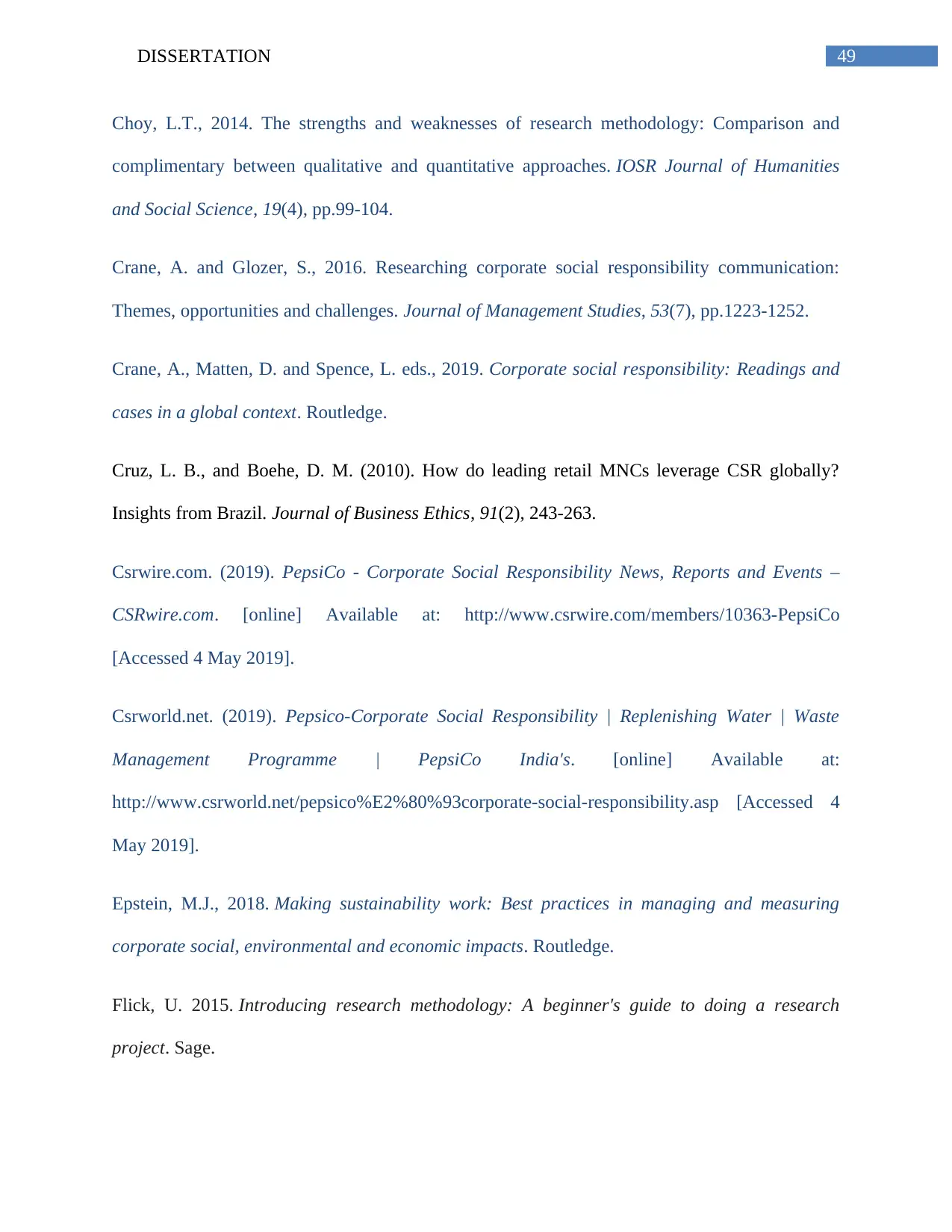
49DISSERTATION
Choy, L.T., 2014. The strengths and weaknesses of research methodology: Comparison and
complimentary between qualitative and quantitative approaches. IOSR Journal of Humanities
and Social Science, 19(4), pp.99-104.
Crane, A. and Glozer, S., 2016. Researching corporate social responsibility communication:
Themes, opportunities and challenges. Journal of Management Studies, 53(7), pp.1223-1252.
Crane, A., Matten, D. and Spence, L. eds., 2019. Corporate social responsibility: Readings and
cases in a global context. Routledge.
Cruz, L. B., and Boehe, D. M. (2010). How do leading retail MNCs leverage CSR globally?
Insights from Brazil. Journal of Business Ethics, 91(2), 243-263.
Csrwire.com. (2019). PepsiCo - Corporate Social Responsibility News, Reports and Events –
CSRwire.com. [online] Available at: http://www.csrwire.com/members/10363-PepsiCo
[Accessed 4 May 2019].
Csrworld.net. (2019). Pepsico-Corporate Social Responsibility | Replenishing Water | Waste
Management Programme | PepsiCo India's. [online] Available at:
http://www.csrworld.net/pepsico%E2%80%93corporate-social-responsibility.asp [Accessed 4
May 2019].
Epstein, M.J., 2018. Making sustainability work: Best practices in managing and measuring
corporate social, environmental and economic impacts. Routledge.
Flick, U. 2015. Introducing research methodology: A beginner's guide to doing a research
project. Sage.
Choy, L.T., 2014. The strengths and weaknesses of research methodology: Comparison and
complimentary between qualitative and quantitative approaches. IOSR Journal of Humanities
and Social Science, 19(4), pp.99-104.
Crane, A. and Glozer, S., 2016. Researching corporate social responsibility communication:
Themes, opportunities and challenges. Journal of Management Studies, 53(7), pp.1223-1252.
Crane, A., Matten, D. and Spence, L. eds., 2019. Corporate social responsibility: Readings and
cases in a global context. Routledge.
Cruz, L. B., and Boehe, D. M. (2010). How do leading retail MNCs leverage CSR globally?
Insights from Brazil. Journal of Business Ethics, 91(2), 243-263.
Csrwire.com. (2019). PepsiCo - Corporate Social Responsibility News, Reports and Events –
CSRwire.com. [online] Available at: http://www.csrwire.com/members/10363-PepsiCo
[Accessed 4 May 2019].
Csrworld.net. (2019). Pepsico-Corporate Social Responsibility | Replenishing Water | Waste
Management Programme | PepsiCo India's. [online] Available at:
http://www.csrworld.net/pepsico%E2%80%93corporate-social-responsibility.asp [Accessed 4
May 2019].
Epstein, M.J., 2018. Making sustainability work: Best practices in managing and measuring
corporate social, environmental and economic impacts. Routledge.
Flick, U. 2015. Introducing research methodology: A beginner's guide to doing a research
project. Sage.
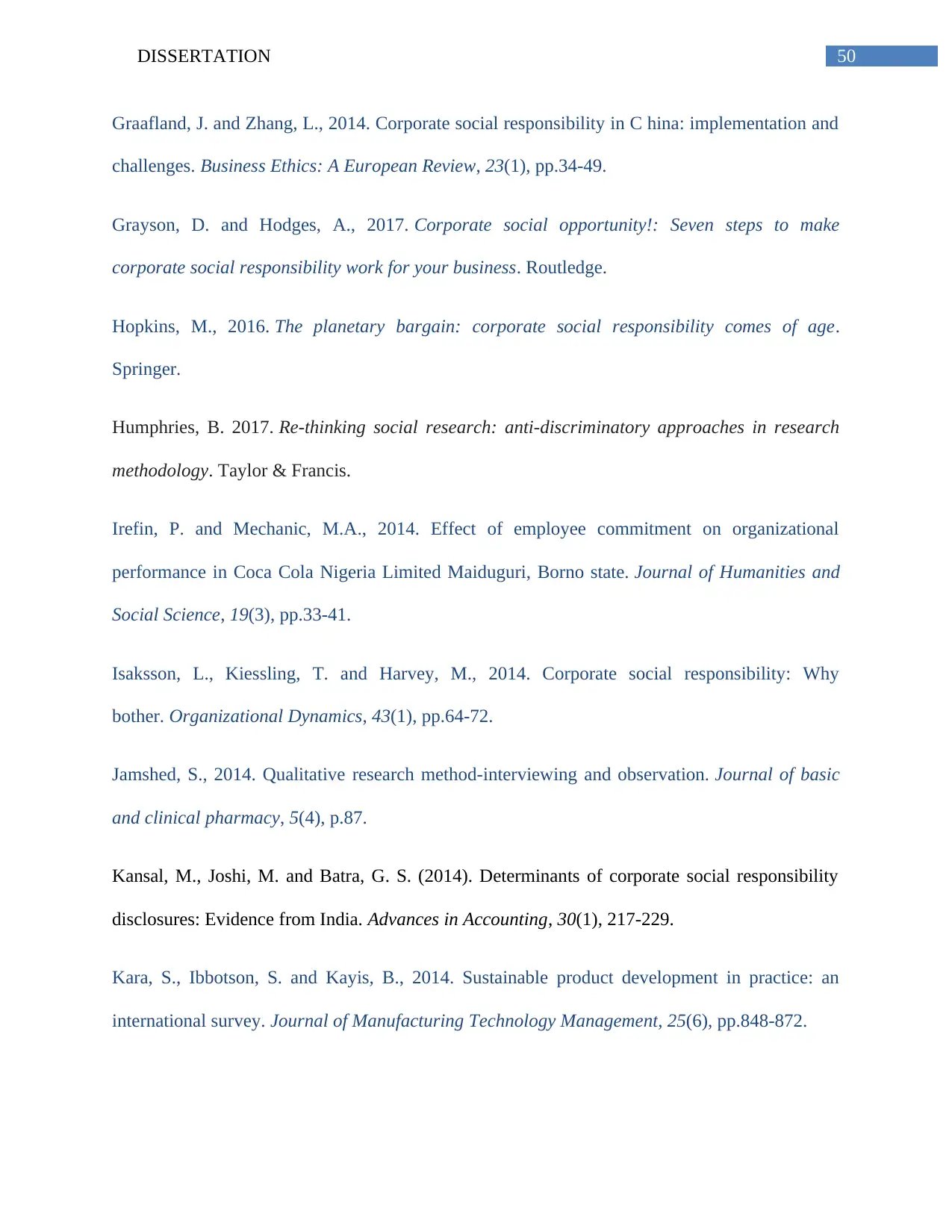
50DISSERTATION
Graafland, J. and Zhang, L., 2014. Corporate social responsibility in C hina: implementation and
challenges. Business Ethics: A European Review, 23(1), pp.34-49.
Grayson, D. and Hodges, A., 2017. Corporate social opportunity!: Seven steps to make
corporate social responsibility work for your business. Routledge.
Hopkins, M., 2016. The planetary bargain: corporate social responsibility comes of age.
Springer.
Humphries, B. 2017. Re-thinking social research: anti-discriminatory approaches in research
methodology. Taylor & Francis.
Irefin, P. and Mechanic, M.A., 2014. Effect of employee commitment on organizational
performance in Coca Cola Nigeria Limited Maiduguri, Borno state. Journal of Humanities and
Social Science, 19(3), pp.33-41.
Isaksson, L., Kiessling, T. and Harvey, M., 2014. Corporate social responsibility: Why
bother. Organizational Dynamics, 43(1), pp.64-72.
Jamshed, S., 2014. Qualitative research method-interviewing and observation. Journal of basic
and clinical pharmacy, 5(4), p.87.
Kansal, M., Joshi, M. and Batra, G. S. (2014). Determinants of corporate social responsibility
disclosures: Evidence from India. Advances in Accounting, 30(1), 217-229.
Kara, S., Ibbotson, S. and Kayis, B., 2014. Sustainable product development in practice: an
international survey. Journal of Manufacturing Technology Management, 25(6), pp.848-872.
Graafland, J. and Zhang, L., 2014. Corporate social responsibility in C hina: implementation and
challenges. Business Ethics: A European Review, 23(1), pp.34-49.
Grayson, D. and Hodges, A., 2017. Corporate social opportunity!: Seven steps to make
corporate social responsibility work for your business. Routledge.
Hopkins, M., 2016. The planetary bargain: corporate social responsibility comes of age.
Springer.
Humphries, B. 2017. Re-thinking social research: anti-discriminatory approaches in research
methodology. Taylor & Francis.
Irefin, P. and Mechanic, M.A., 2014. Effect of employee commitment on organizational
performance in Coca Cola Nigeria Limited Maiduguri, Borno state. Journal of Humanities and
Social Science, 19(3), pp.33-41.
Isaksson, L., Kiessling, T. and Harvey, M., 2014. Corporate social responsibility: Why
bother. Organizational Dynamics, 43(1), pp.64-72.
Jamshed, S., 2014. Qualitative research method-interviewing and observation. Journal of basic
and clinical pharmacy, 5(4), p.87.
Kansal, M., Joshi, M. and Batra, G. S. (2014). Determinants of corporate social responsibility
disclosures: Evidence from India. Advances in Accounting, 30(1), 217-229.
Kara, S., Ibbotson, S. and Kayis, B., 2014. Sustainable product development in practice: an
international survey. Journal of Manufacturing Technology Management, 25(6), pp.848-872.
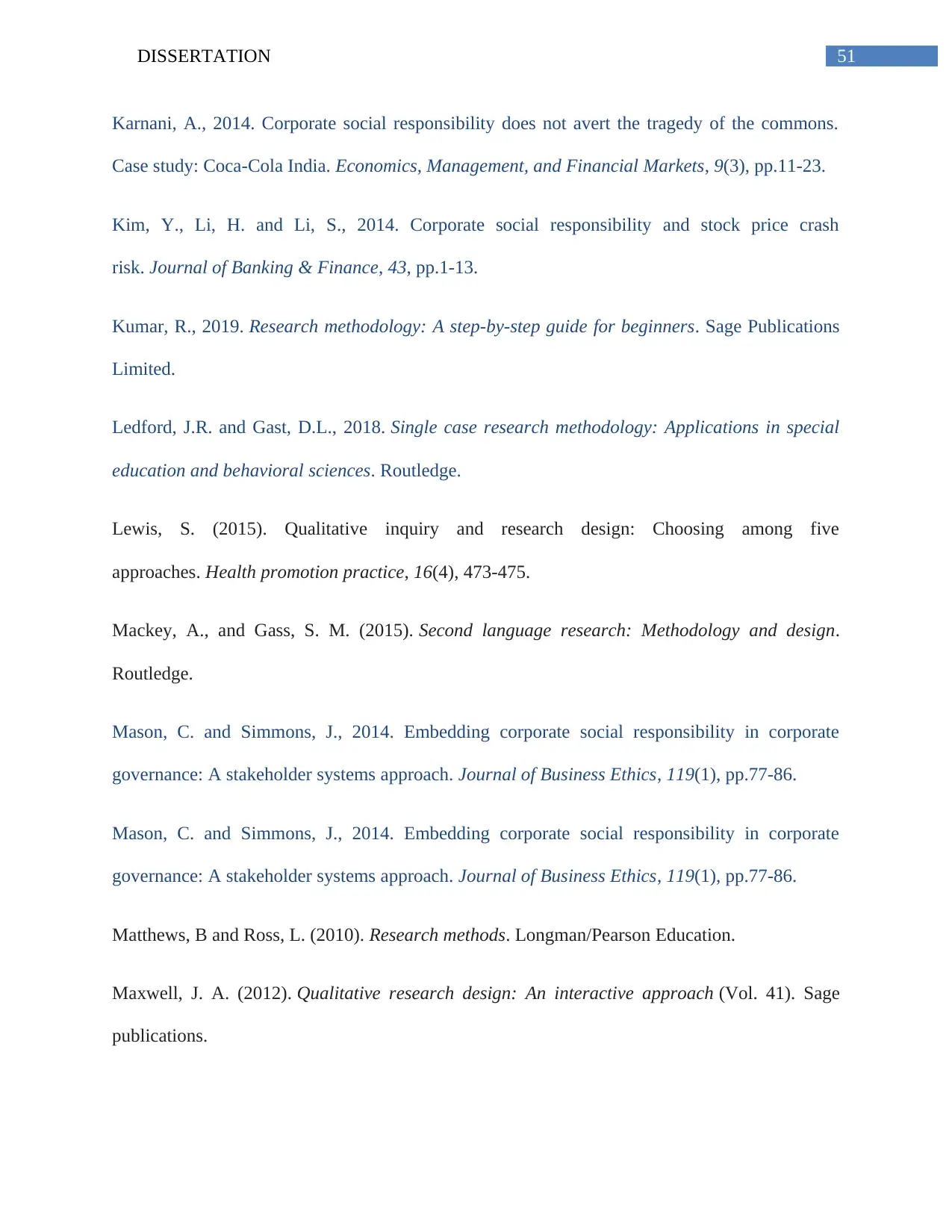
51DISSERTATION
Karnani, A., 2014. Corporate social responsibility does not avert the tragedy of the commons.
Case study: Coca-Cola India. Economics, Management, and Financial Markets, 9(3), pp.11-23.
Kim, Y., Li, H. and Li, S., 2014. Corporate social responsibility and stock price crash
risk. Journal of Banking & Finance, 43, pp.1-13.
Kumar, R., 2019. Research methodology: A step-by-step guide for beginners. Sage Publications
Limited.
Ledford, J.R. and Gast, D.L., 2018. Single case research methodology: Applications in special
education and behavioral sciences. Routledge.
Lewis, S. (2015). Qualitative inquiry and research design: Choosing among five
approaches. Health promotion practice, 16(4), 473-475.
Mackey, A., and Gass, S. M. (2015). Second language research: Methodology and design.
Routledge.
Mason, C. and Simmons, J., 2014. Embedding corporate social responsibility in corporate
governance: A stakeholder systems approach. Journal of Business Ethics, 119(1), pp.77-86.
Mason, C. and Simmons, J., 2014. Embedding corporate social responsibility in corporate
governance: A stakeholder systems approach. Journal of Business Ethics, 119(1), pp.77-86.
Matthews, B and Ross, L. (2010). Research methods. Longman/Pearson Education.
Maxwell, J. A. (2012). Qualitative research design: An interactive approach (Vol. 41). Sage
publications.
Karnani, A., 2014. Corporate social responsibility does not avert the tragedy of the commons.
Case study: Coca-Cola India. Economics, Management, and Financial Markets, 9(3), pp.11-23.
Kim, Y., Li, H. and Li, S., 2014. Corporate social responsibility and stock price crash
risk. Journal of Banking & Finance, 43, pp.1-13.
Kumar, R., 2019. Research methodology: A step-by-step guide for beginners. Sage Publications
Limited.
Ledford, J.R. and Gast, D.L., 2018. Single case research methodology: Applications in special
education and behavioral sciences. Routledge.
Lewis, S. (2015). Qualitative inquiry and research design: Choosing among five
approaches. Health promotion practice, 16(4), 473-475.
Mackey, A., and Gass, S. M. (2015). Second language research: Methodology and design.
Routledge.
Mason, C. and Simmons, J., 2014. Embedding corporate social responsibility in corporate
governance: A stakeholder systems approach. Journal of Business Ethics, 119(1), pp.77-86.
Mason, C. and Simmons, J., 2014. Embedding corporate social responsibility in corporate
governance: A stakeholder systems approach. Journal of Business Ethics, 119(1), pp.77-86.
Matthews, B and Ross, L. (2010). Research methods. Longman/Pearson Education.
Maxwell, J. A. (2012). Qualitative research design: An interactive approach (Vol. 41). Sage
publications.
Secure Best Marks with AI Grader
Need help grading? Try our AI Grader for instant feedback on your assignments.
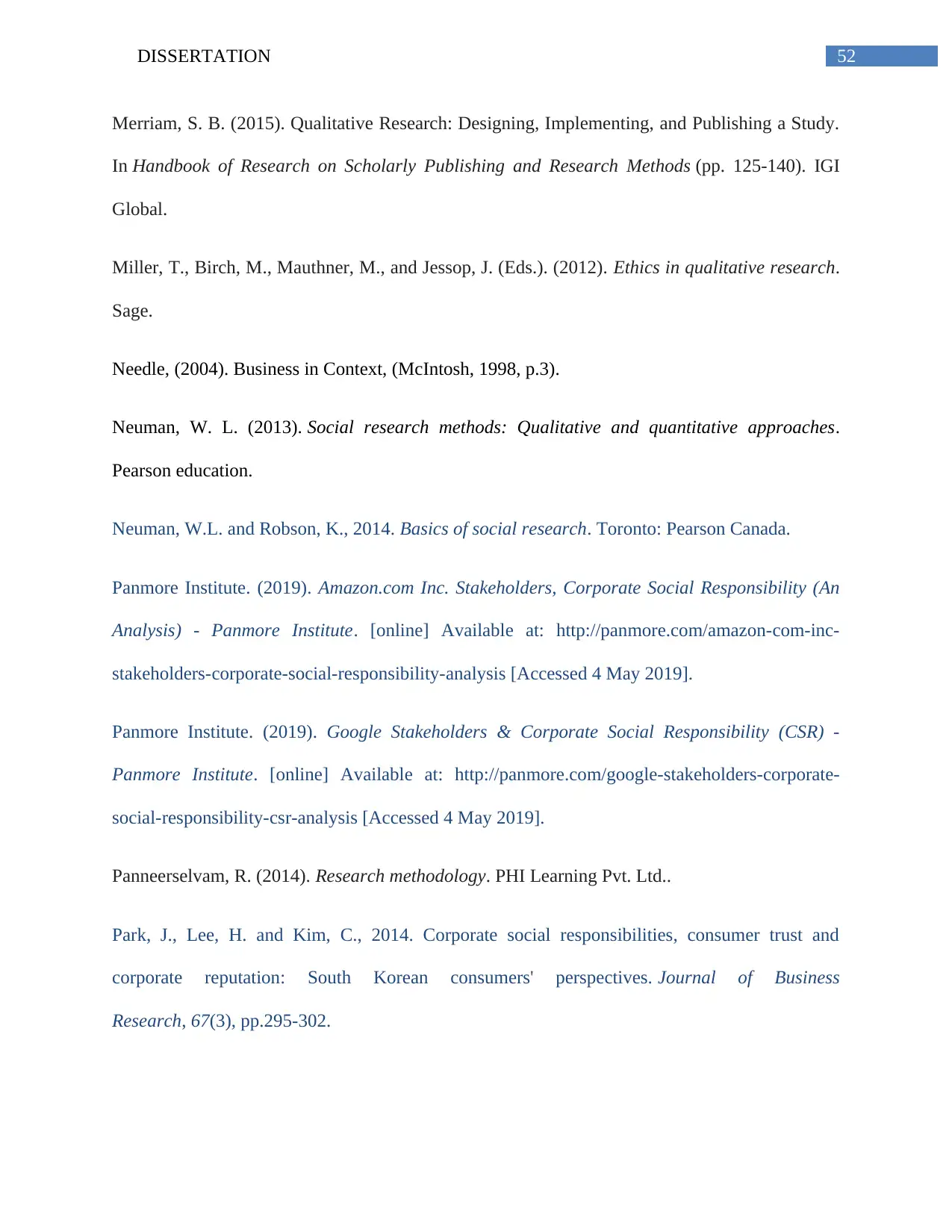
52DISSERTATION
Merriam, S. B. (2015). Qualitative Research: Designing, Implementing, and Publishing a Study.
In Handbook of Research on Scholarly Publishing and Research Methods (pp. 125-140). IGI
Global.
Miller, T., Birch, M., Mauthner, M., and Jessop, J. (Eds.). (2012). Ethics in qualitative research.
Sage.
Needle, (2004). Business in Context, (McIntosh, 1998, p.3).
Neuman, W. L. (2013). Social research methods: Qualitative and quantitative approaches.
Pearson education.
Neuman, W.L. and Robson, K., 2014. Basics of social research. Toronto: Pearson Canada.
Panmore Institute. (2019). Amazon.com Inc. Stakeholders, Corporate Social Responsibility (An
Analysis) - Panmore Institute. [online] Available at: http://panmore.com/amazon-com-inc-
stakeholders-corporate-social-responsibility-analysis [Accessed 4 May 2019].
Panmore Institute. (2019). Google Stakeholders & Corporate Social Responsibility (CSR) -
Panmore Institute. [online] Available at: http://panmore.com/google-stakeholders-corporate-
social-responsibility-csr-analysis [Accessed 4 May 2019].
Panneerselvam, R. (2014). Research methodology. PHI Learning Pvt. Ltd..
Park, J., Lee, H. and Kim, C., 2014. Corporate social responsibilities, consumer trust and
corporate reputation: South Korean consumers' perspectives. Journal of Business
Research, 67(3), pp.295-302.
Merriam, S. B. (2015). Qualitative Research: Designing, Implementing, and Publishing a Study.
In Handbook of Research on Scholarly Publishing and Research Methods (pp. 125-140). IGI
Global.
Miller, T., Birch, M., Mauthner, M., and Jessop, J. (Eds.). (2012). Ethics in qualitative research.
Sage.
Needle, (2004). Business in Context, (McIntosh, 1998, p.3).
Neuman, W. L. (2013). Social research methods: Qualitative and quantitative approaches.
Pearson education.
Neuman, W.L. and Robson, K., 2014. Basics of social research. Toronto: Pearson Canada.
Panmore Institute. (2019). Amazon.com Inc. Stakeholders, Corporate Social Responsibility (An
Analysis) - Panmore Institute. [online] Available at: http://panmore.com/amazon-com-inc-
stakeholders-corporate-social-responsibility-analysis [Accessed 4 May 2019].
Panmore Institute. (2019). Google Stakeholders & Corporate Social Responsibility (CSR) -
Panmore Institute. [online] Available at: http://panmore.com/google-stakeholders-corporate-
social-responsibility-csr-analysis [Accessed 4 May 2019].
Panneerselvam, R. (2014). Research methodology. PHI Learning Pvt. Ltd..
Park, J., Lee, H. and Kim, C., 2014. Corporate social responsibilities, consumer trust and
corporate reputation: South Korean consumers' perspectives. Journal of Business
Research, 67(3), pp.295-302.

53DISSERTATION
Podsakoff, P. M., MacKenzie, S. B., and Podsakoff, N. P. (2012). Sources of method bias in
social science research and recommendations on how to control it. Annual review of
psychology, 63, 539-569.
Quinlan, C., Babin, B., Carr, J. and Griffin, M., 2019. Business research methods. South Western
Cengage.
Ritchie, J., Lewis, J., Nicholls, C. M., &Ormston, R. (Eds.). (2013). Qualitative research
practice: A guide for social science students and researchers. Sage.
Scherer, A.G., Rasche, A., Palazzo, G. and Spicer, A., 2016. Managing for political corporate
social responsibility: New challenges and directions for PCSR 2.0. Journal of Management
Studies, 53(3), pp.273-298.
Silverman, D. (Ed.). (2016). Qualitative research. Sage.
Smith, J. A. (Ed.). (2015). Qualitative psychology: A practical guide to research methods. Sage.
Sovacool, B. K. (2014). What are we doing here? Analyzing fifteen years of energy scholarship
and proposing a social science research agenda. Energy Research & Social Science, 1, 1-29.
Tai, F.M. and Chuang, S.H., 2014. Corporate social responsibility. Ibusiness, 6(03), p.117.
Taylor, S. J., Bogdan, R., and DeVault, M. (2015). Introduction to qualitative research methods:
A guidebook and resource. John Wiley & Sons.
Thomas, Clarke (2007). International Corporate Governance, a comparative approach
US About Amazon. (2019). Sustainability. [online] Available at:
https://www.aboutamazon.com/sustainability [Accessed 4 May 2019].
Podsakoff, P. M., MacKenzie, S. B., and Podsakoff, N. P. (2012). Sources of method bias in
social science research and recommendations on how to control it. Annual review of
psychology, 63, 539-569.
Quinlan, C., Babin, B., Carr, J. and Griffin, M., 2019. Business research methods. South Western
Cengage.
Ritchie, J., Lewis, J., Nicholls, C. M., &Ormston, R. (Eds.). (2013). Qualitative research
practice: A guide for social science students and researchers. Sage.
Scherer, A.G., Rasche, A., Palazzo, G. and Spicer, A., 2016. Managing for political corporate
social responsibility: New challenges and directions for PCSR 2.0. Journal of Management
Studies, 53(3), pp.273-298.
Silverman, D. (Ed.). (2016). Qualitative research. Sage.
Smith, J. A. (Ed.). (2015). Qualitative psychology: A practical guide to research methods. Sage.
Sovacool, B. K. (2014). What are we doing here? Analyzing fifteen years of energy scholarship
and proposing a social science research agenda. Energy Research & Social Science, 1, 1-29.
Tai, F.M. and Chuang, S.H., 2014. Corporate social responsibility. Ibusiness, 6(03), p.117.
Taylor, S. J., Bogdan, R., and DeVault, M. (2015). Introduction to qualitative research methods:
A guidebook and resource. John Wiley & Sons.
Thomas, Clarke (2007). International Corporate Governance, a comparative approach
US About Amazon. (2019). Sustainability. [online] Available at:
https://www.aboutamazon.com/sustainability [Accessed 4 May 2019].
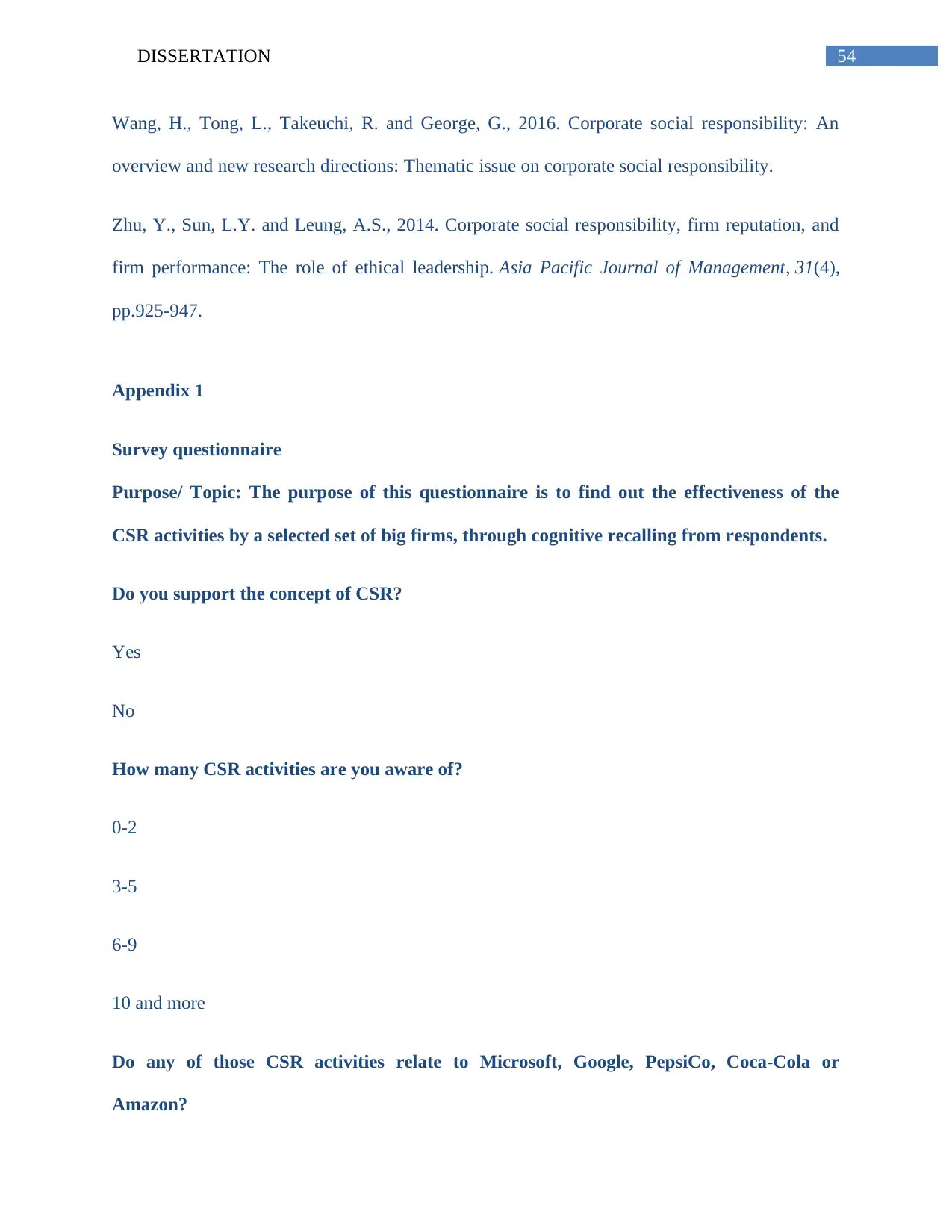
54DISSERTATION
Wang, H., Tong, L., Takeuchi, R. and George, G., 2016. Corporate social responsibility: An
overview and new research directions: Thematic issue on corporate social responsibility.
Zhu, Y., Sun, L.Y. and Leung, A.S., 2014. Corporate social responsibility, firm reputation, and
firm performance: The role of ethical leadership. Asia Pacific Journal of Management, 31(4),
pp.925-947.
Appendix 1
Survey questionnaire
Purpose/ Topic: The purpose of this questionnaire is to find out the effectiveness of the
CSR activities by a selected set of big firms, through cognitive recalling from respondents.
Do you support the concept of CSR?
Yes
No
How many CSR activities are you aware of?
0-2
3-5
6-9
10 and more
Do any of those CSR activities relate to Microsoft, Google, PepsiCo, Coca-Cola or
Amazon?
Wang, H., Tong, L., Takeuchi, R. and George, G., 2016. Corporate social responsibility: An
overview and new research directions: Thematic issue on corporate social responsibility.
Zhu, Y., Sun, L.Y. and Leung, A.S., 2014. Corporate social responsibility, firm reputation, and
firm performance: The role of ethical leadership. Asia Pacific Journal of Management, 31(4),
pp.925-947.
Appendix 1
Survey questionnaire
Purpose/ Topic: The purpose of this questionnaire is to find out the effectiveness of the
CSR activities by a selected set of big firms, through cognitive recalling from respondents.
Do you support the concept of CSR?
Yes
No
How many CSR activities are you aware of?
0-2
3-5
6-9
10 and more
Do any of those CSR activities relate to Microsoft, Google, PepsiCo, Coca-Cola or
Amazon?
Paraphrase This Document
Need a fresh take? Get an instant paraphrase of this document with our AI Paraphraser

55DISSERTATION
Yes
No
Do you think any of those mentioned companies has marketed their CSR activity well
enough?
Yes
No
If given to choose the best CSR activity, which of these companies will you choose?
Microsoft
Amazon
PepsiCo
Coca-Cola
Google
Other
What prompted you to make that choice?
Marketing
Community outreach
Intent
None of the above.
Yes
No
Do you think any of those mentioned companies has marketed their CSR activity well
enough?
Yes
No
If given to choose the best CSR activity, which of these companies will you choose?
Microsoft
Amazon
PepsiCo
Coca-Cola
Other
What prompted you to make that choice?
Marketing
Community outreach
Intent
None of the above.
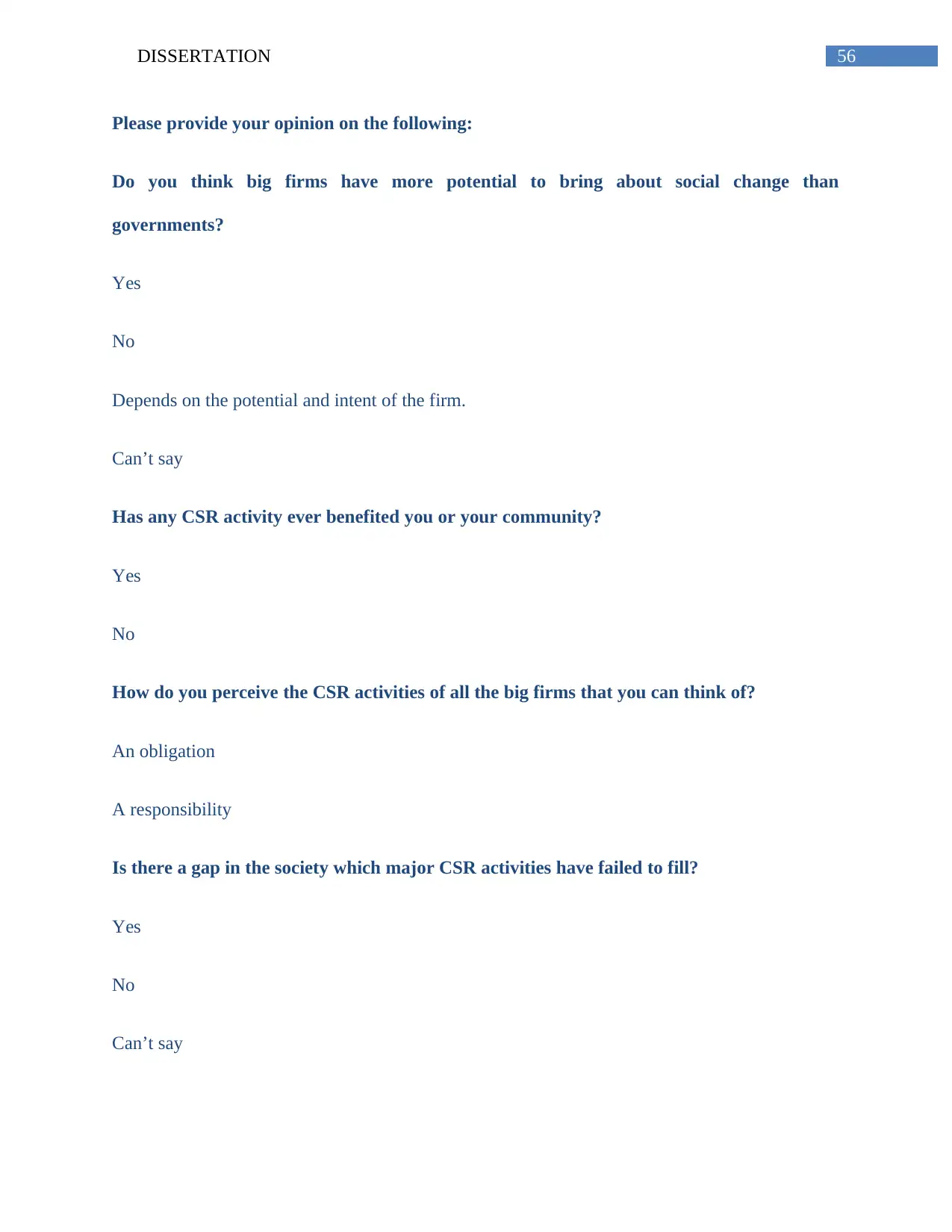
56DISSERTATION
Please provide your opinion on the following:
Do you think big firms have more potential to bring about social change than
governments?
Yes
No
Depends on the potential and intent of the firm.
Can’t say
Has any CSR activity ever benefited you or your community?
Yes
No
How do you perceive the CSR activities of all the big firms that you can think of?
An obligation
A responsibility
Is there a gap in the society which major CSR activities have failed to fill?
Yes
No
Can’t say
Please provide your opinion on the following:
Do you think big firms have more potential to bring about social change than
governments?
Yes
No
Depends on the potential and intent of the firm.
Can’t say
Has any CSR activity ever benefited you or your community?
Yes
No
How do you perceive the CSR activities of all the big firms that you can think of?
An obligation
A responsibility
Is there a gap in the society which major CSR activities have failed to fill?
Yes
No
Can’t say
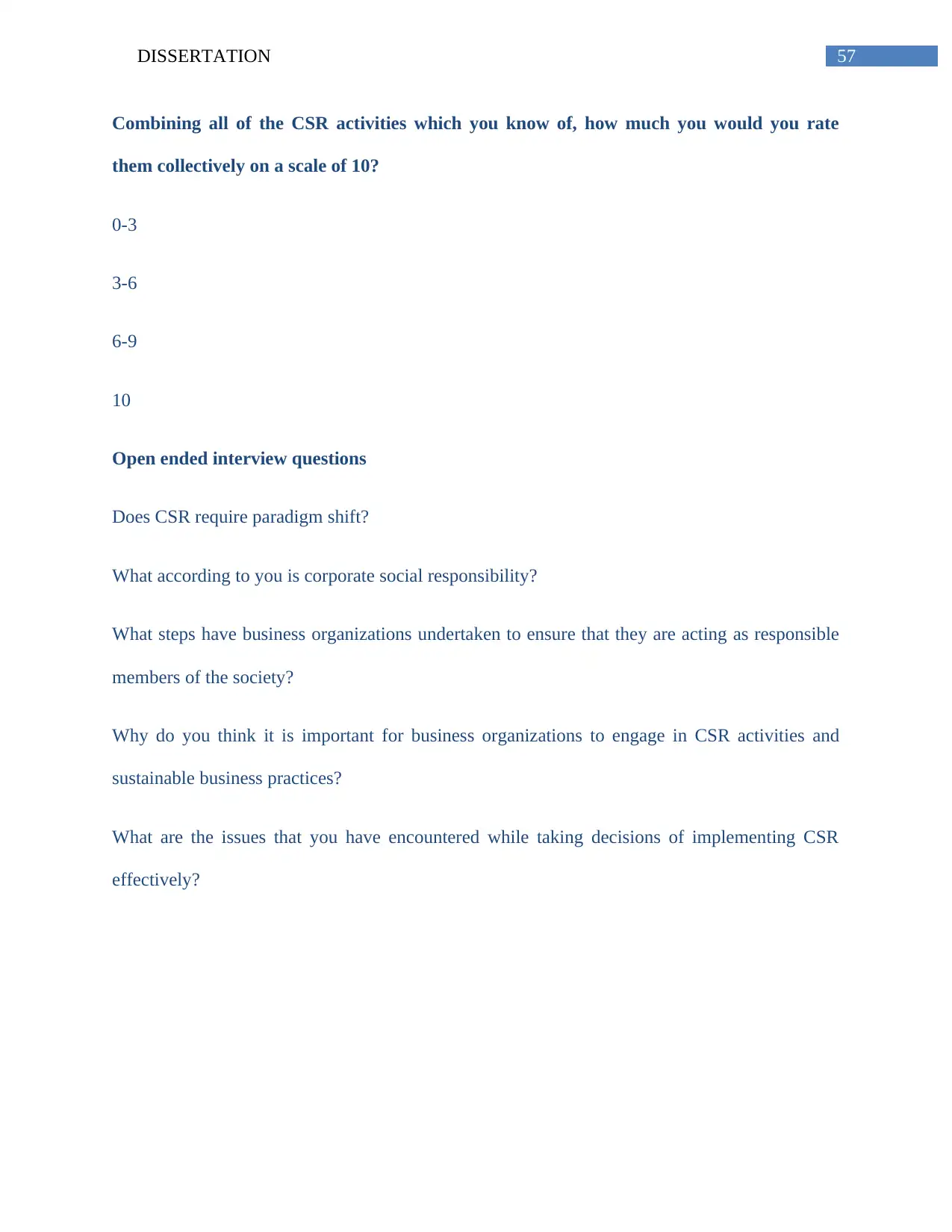
57DISSERTATION
Combining all of the CSR activities which you know of, how much you would you rate
them collectively on a scale of 10?
0-3
3-6
6-9
10
Open ended interview questions
Does CSR require paradigm shift?
What according to you is corporate social responsibility?
What steps have business organizations undertaken to ensure that they are acting as responsible
members of the society?
Why do you think it is important for business organizations to engage in CSR activities and
sustainable business practices?
What are the issues that you have encountered while taking decisions of implementing CSR
effectively?
Combining all of the CSR activities which you know of, how much you would you rate
them collectively on a scale of 10?
0-3
3-6
6-9
10
Open ended interview questions
Does CSR require paradigm shift?
What according to you is corporate social responsibility?
What steps have business organizations undertaken to ensure that they are acting as responsible
members of the society?
Why do you think it is important for business organizations to engage in CSR activities and
sustainable business practices?
What are the issues that you have encountered while taking decisions of implementing CSR
effectively?
1 out of 58
Related Documents
Your All-in-One AI-Powered Toolkit for Academic Success.
+13062052269
info@desklib.com
Available 24*7 on WhatsApp / Email
![[object Object]](/_next/static/media/star-bottom.7253800d.svg)
Unlock your academic potential
© 2024 | Zucol Services PVT LTD | All rights reserved.





